Proxim Wireless AP700 Wireless Access Device User Manual APs UG
Proxim Wireless Corporation Wireless Access Device APs UG
Contents
- 1. reg manual
- 2. manual 1
- 3. manual 2
- 4. Users Manual 1 of 3
- 5. Users Manual 2 of 3
- 6. Users Manual 3 of 3
Users Manual 2 of 3

Advanced Configuration AP-700 User Guide
SSID/VLAN/Security
116
— For 64-bit encryption, an encryption key is 10 hexadecimal characters (0-9 and A-F) or 5 ASCII characters
(see ASCII Character Chart).
— For 128-bit encryption, an encryption key is 26 hexadecimal characters or 13 ASCII characters.
— For 152-bit encryption, an encryption key is 32 hexadecimal characters or 16 ASCII characters.
• Encryption Transmit Key: select Key 0, Key 1, Key 2, or Key 3
NOTE: When VLAN tagging is enabled, only Key 0 can be configured.
•802.1x Station:
• Authentication Mode: 802.1x
• Cipher: WEP
• Encryption Key Length: 64 or 128 Bits.
— If 802.1x is enabled simultaneously with WEP, the 802.1x Station’s encryption key length is determined by
the WEP encryption key.
•WPA Station:
• Authentication Mode: 802.1x
• Cipher: TKIP
•WPA-PSK Station:
• Authentication Mode: PSK
• Cipher: TKIP
• PSK Passphrase: an 8-63 character user-defined phrase. It is recommended a passphrase of at least 13
characters, including both letters and numbers, and upper and lower case characters, be used to ensure that
the generated key cannot be easily deciphered by network infiltrators.
•802.11i Station:
• Authentication Mode: 802.1x
• Cipher: CCMP based on AES
•802.11i-PSK Station:
• Authentication Mode: PSK
• Cipher: CCMP based on AES
• PSK Passphrase: an 8-63 character user-defined phrase. It is recommended a passphrase of at least 13
characters, including both letters and numbers, and upper and lower case characters, to ensure that the
generated key cannot be easily deciphered by network infiltrators.
5. When finished configuring all parameters, click OK.
6. If you selected a Security Mode of 802.1x Station, WPA Station, or 802.11i Station, you must configure a RADIUS
802.1x/EAP server. See the Configuring Radius Profiles section.
Security Profile 1 will be used by default for all wireless interfaces.
7. Reboot the AP.
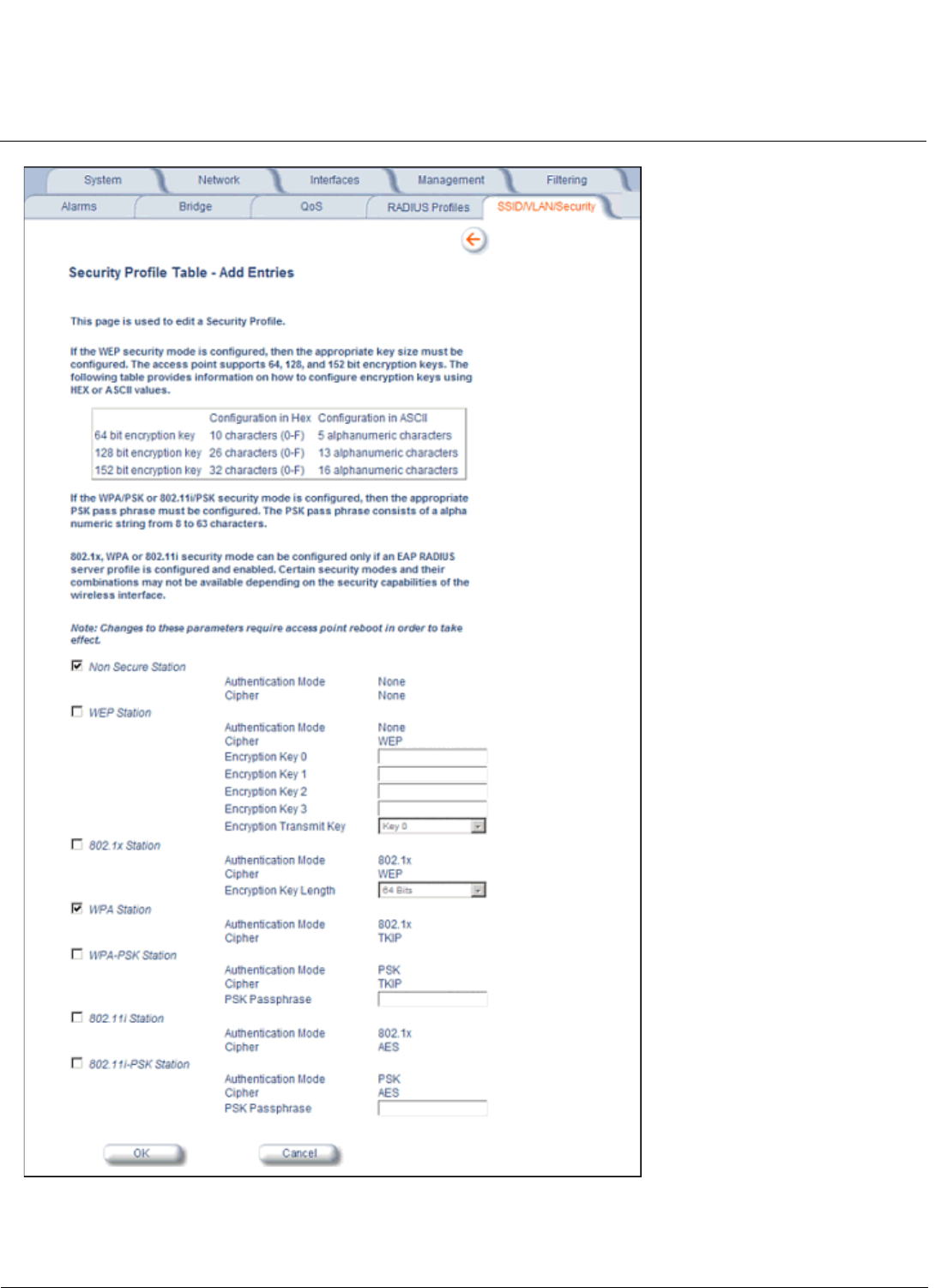
Advanced Configuration AP-700 User Guide
SSID/VLAN/Security
117
Figure 4-49 Security Profile Table - Add Entries
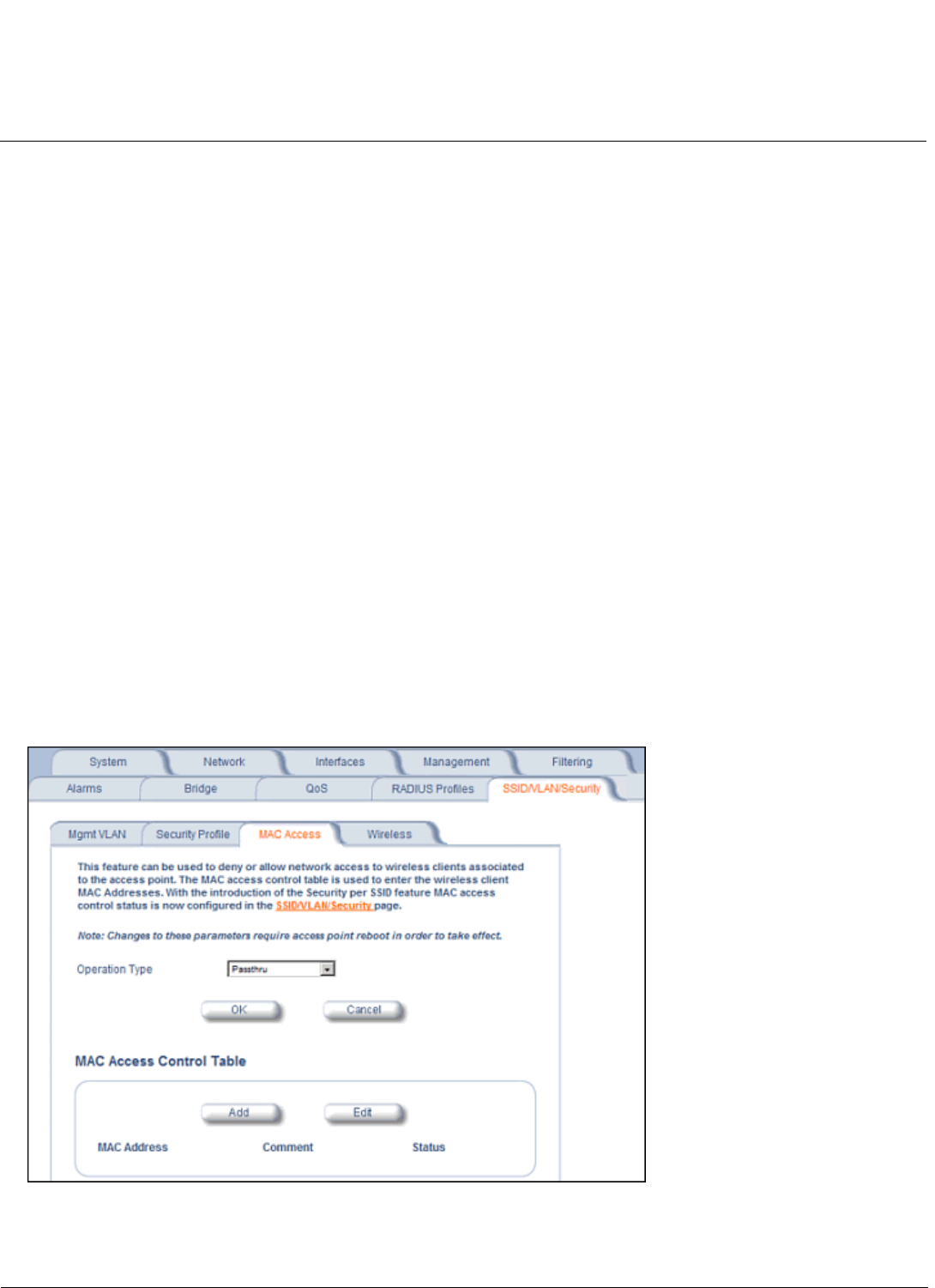
Advanced Configuration AP-700 User Guide
SSID/VLAN/Security
118
MAC Access
The MAC Access sub-tab allows you to build a list of stations, identified by their MAC addresses, authorized to access
the network through the AP. The list is stored inside each AP within your network. Note that you must reboot the AP for
any changes to the MAC Access Control Table to take effect. Up to 1000 entries can be made in the table.
The “MAC ACL Status” parameter (configurable on the SSID/VLAN/Security > Wireless sub-tab) is per VLAN if VLAN
Management is enabled. All other parameters besides “MAC ACL Status” are configured per AP, even if VLAN is
enabled.
The following list details the configurable MAC Access parameters.
NOTE: MAC Access Control status is controlled on the SSID/VLAN/Security > Wireless sub-tab. When set to Strict,
changes to the MAC ACL table will take effect immediately, without a unit reboot. When not set to Strict, changes
will not take effect until the unit is rebooted.
•Operation Type: Choose between Passthru and Block. This determines how the stations identified in the MAC
Access Control Table are filtered.
– If set to Passthru, only the addresses listed in the Control Table will pass through the bridge.
– If set to Block, the bridge will block traffic to or from the addresses listed in the Control Table.
•MAC Access Control Table: Click Add to create a new entry. Click Edit to change an existing entry. Each entry
contains the following field:
–MAC Address: Enter the wireless client’s MAC address.
–Comment: Enter an optional comment such as the client’s name.
–Status: The entry is enabled automatically when saved (so the Status field is only visible when editing an entry).
You can also disable or delete entries by changing this field’s value.
NOTE: For larger networks that include multiple Access Points, you may prefer to maintain this list on a centralized
location using the MAC Access Control Via RADIUS Authentication.
Figure 4-50 MAC Access Configuration Screen
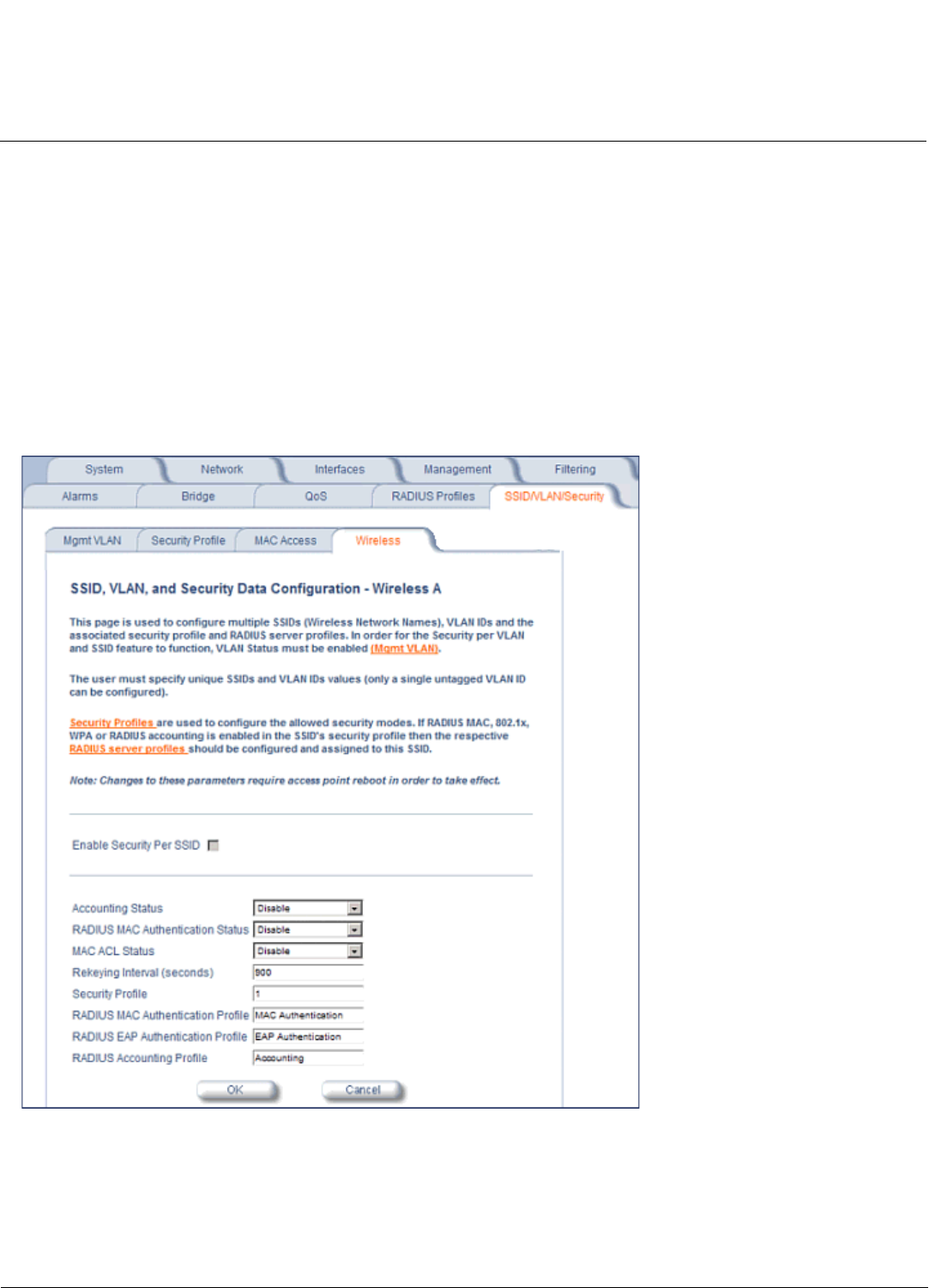
Advanced Configuration AP-700 User Guide
SSID/VLAN/Security
119
Wireless
Each SSID can have its own Security Profile that defines its security mode, authentication mechanism, and encryption,
so that customers can have multiple types of clients (non-WEP, WEP, 802.1x, WPA, WPA-PSK, 802.11i, 802.11i-PSK) on
the same system separated per VLAN. See the Security Profile section for more information. Each SSID can support a
unique VLAN. In order for the AP to support multiple SSID/VLANs, VLAN Tagging must be enabled. These parameters
are configurable on the Wireless screens.
Configuring an SSID/VLAN with VLAN Tagging Disabled
With VLAN tagging disabled (from the SSID/VLAN/Security > Mgmt VLAN tab), only one SSID can be configured. All
parameters set on the Wireless tab will be applied to that SSID.
1. Click SSID/VLAN/Security > Wireless.
The SSID, VLAN, and Security Configuration page is displayed.
Figure 4-51 SSID, VLAN, and Security Configuration (VLAN Tagging Disabled)
2. Enable or disable RADIUS accounting on the VLAN/SSID by selecting Enable or Disable from the Accounting
Status drop-down menu.
3. Control the functionality of RADIUS MAC Authentication on the VLAN/SSID by selecting one of the following from the
the RADIUS Authentication Status drop-down menu.

Advanced Configuration AP-700 User Guide
SSID/VLAN/Security
120
•Enable: MAC addresses in the MAC Access Control List stored on the RADIUS server are blocked or allowed,
based on the MAC ACL settings. If a higher priority authentication protocol is also enabled, the higher-priority
settings will override the MAC ACL settings. See Authentication Protocol Hierarchy.
•Disable: RADIUS MAC ACL settings are disabled.
•Strict: RADIUS MAC ACL settings are enabled. If a higher-priority authentication protocol is also enabled,
RADIUS MAC ACL settings will be applied in addition to the higher priority authentication protocol settings. See
Authentication Protocol Hierarchy.
4. Control the functionality of the MAC Access Control List on the VLAN/SSID by selecting one of the following from the
MAC ACL Status drop-down menu:
•Enable: MAC addresses in the MAC Access Control List are blocked or allowed, based on the MAC ACL settings.
If a higher priority authentication protocol is also enabled, the higher-priority settings will override the MAC ACL
settings. See Authentication Protocol Hierarchy.
•Disable: MAC ACL settings are disabled.
•Strict: MAC ACL settings are enabled. If a higher-priority authentication protocol is also enabled, MAC ACL
settings will be applied in addition to the higher priority authentication protocol settings. See Authentication
Protocol Hierarchy. When MAC ACL Status is set to Strict, changes to the MAC ACL table (configured on the MAC
Access page) will take effect without a device reboot.
5. Enter Rekeying Interval in seconds (between 300 and 65525). When set to 0, this parameter is disabled. The default
is 900 seconds.
6. Enter the Security Profile used by the VLAN in the Security Profile field. See the Security Profile section for more
information.
7. Define the RADIUS Server Profile Configuration for the VLAN/SSID:
• RADIUS MAC Authentication Profile
• RADIUS EAP Authentication Profile
• RADIUS Accounting Profile
If 802.1x, WPA, or 802.11i security mode is used, the RADIUS EAP Authentication Profile must have a value.
A RADIUS Server Profile for authentication for each VLAN shall be configured as part of the configuration options
for that VLAN. RADIUS profiles are independent of VLANs. The user can define any profile to be the default and
associate all VLANs to that profile. Four profiles are created by default, “MAC Authentication”, “EAP
Authentication”, Accounting”, and “Management”
8. If desired, scroll down to the scroll down to the SSID and VLAN Table and click Edit to modify the Network Name,
VLAN ID, or QoS profile of the SSID/VLAN.
NOTE: Because VLAN tagging is disabled, attempting to add a new SSID/VLAN will produce an error message.
The Edit Entries screen will be displayed. See Figure 4-52.
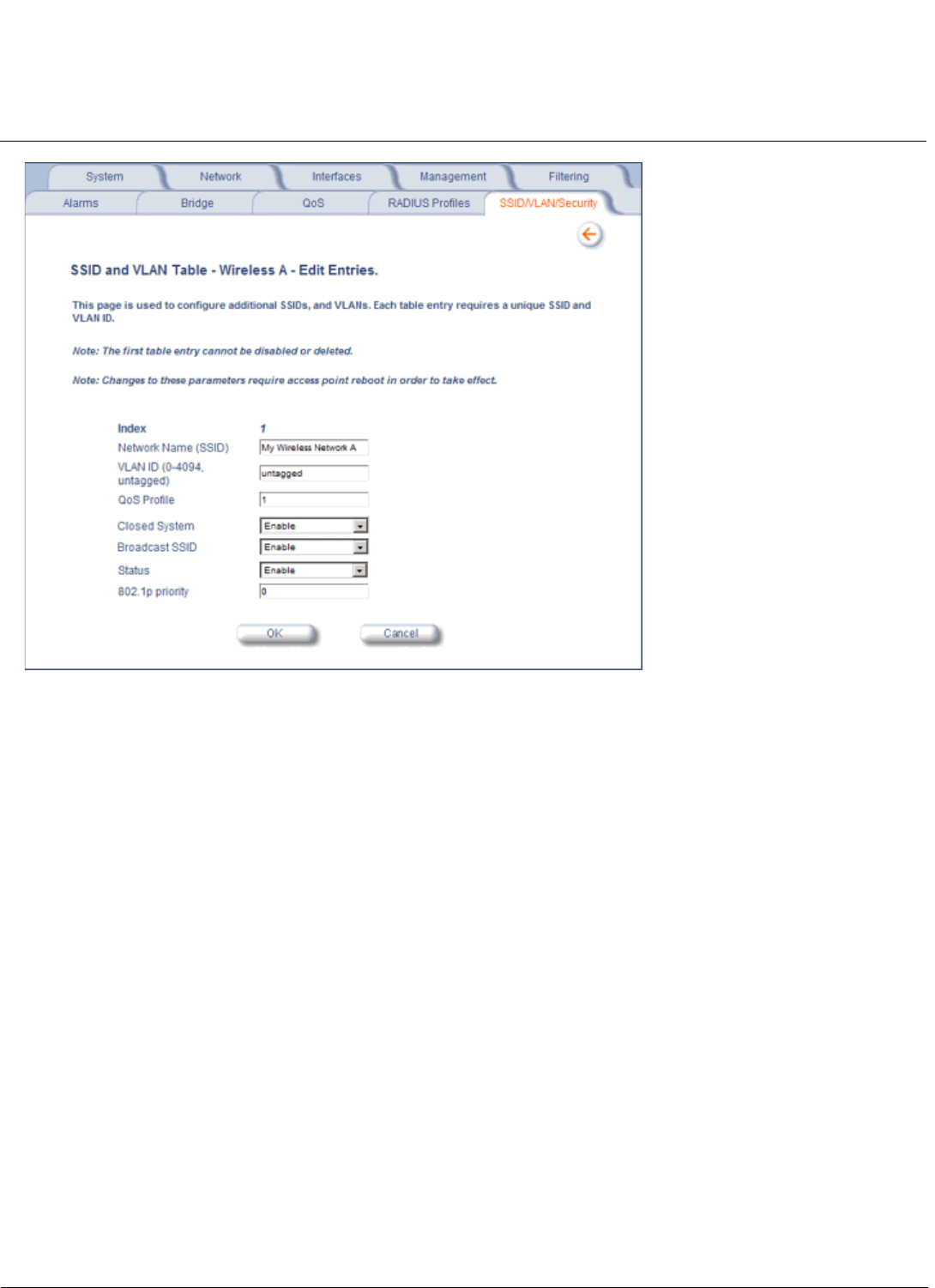
Advanced Configuration AP-700 User Guide
SSID/VLAN/Security
121
Figure 4-52 SSID/VLAN Edit Entries Screen (VLAN Tagging Disabled)
9. Enter a unique Network Name (SSID) between 1 and 32 characters. This parameter is mandatory.
NOTE: Do not use quotation marks (single or double) in the Network Name; this will cause the AP to misinterpret the
name.
10.Enter a unique VLAN ID. This parameter is mandatory.
• A VLAN ID is a number from -1 to 4094. A value of -1 means that an entry is “untagged.”
• You can set the VLAN ID to “-1” or “untagged” if you do not want clients that are using a specific SSID to be
members of a VLAN workgroup.
• The VLAN ID must match an ID used by your network; contact your network administrator if you need assistance
defining the VLAN IDs.
11. Specify a QoS profile. See the Policy section for more information.
12.Select the status of Closed System to control whether the SSID is advertised in the beacon and manage the way
probe requests are handled, as follows:
•Enable: The SSID is not advertised in the beacon, and the AP will respond to probe requests with an SSID only if
the client has specified the SSID in the probe request. If the client sends a probe request with a null or “ANY”
SSID, the AP will not respond.
•Partial: The SSID is advertised in the beacon, and the AP will not respond to "ANY" SSID requests. The Partial
setting reduces network traffic by eliminating the repeated broadcast of SSIDs in probe responses.
•Disable: The SSID is advertised in the beacon, and the AP will respond with each configured SSID, whether or
not an SSID has been specified in the probe request.
13.Enable Broadcast Unique Beacon using the drop-down menu. When enabled, Broadcast Unique Beacon allows the
broadcast of a up to four unique beacons when the AP is configured for multiple SSIDs. If Closed System (above) is
set to Partial or Disable, each beacon (up to four) will be broadcast a single SSID. If more than four SSIDs are
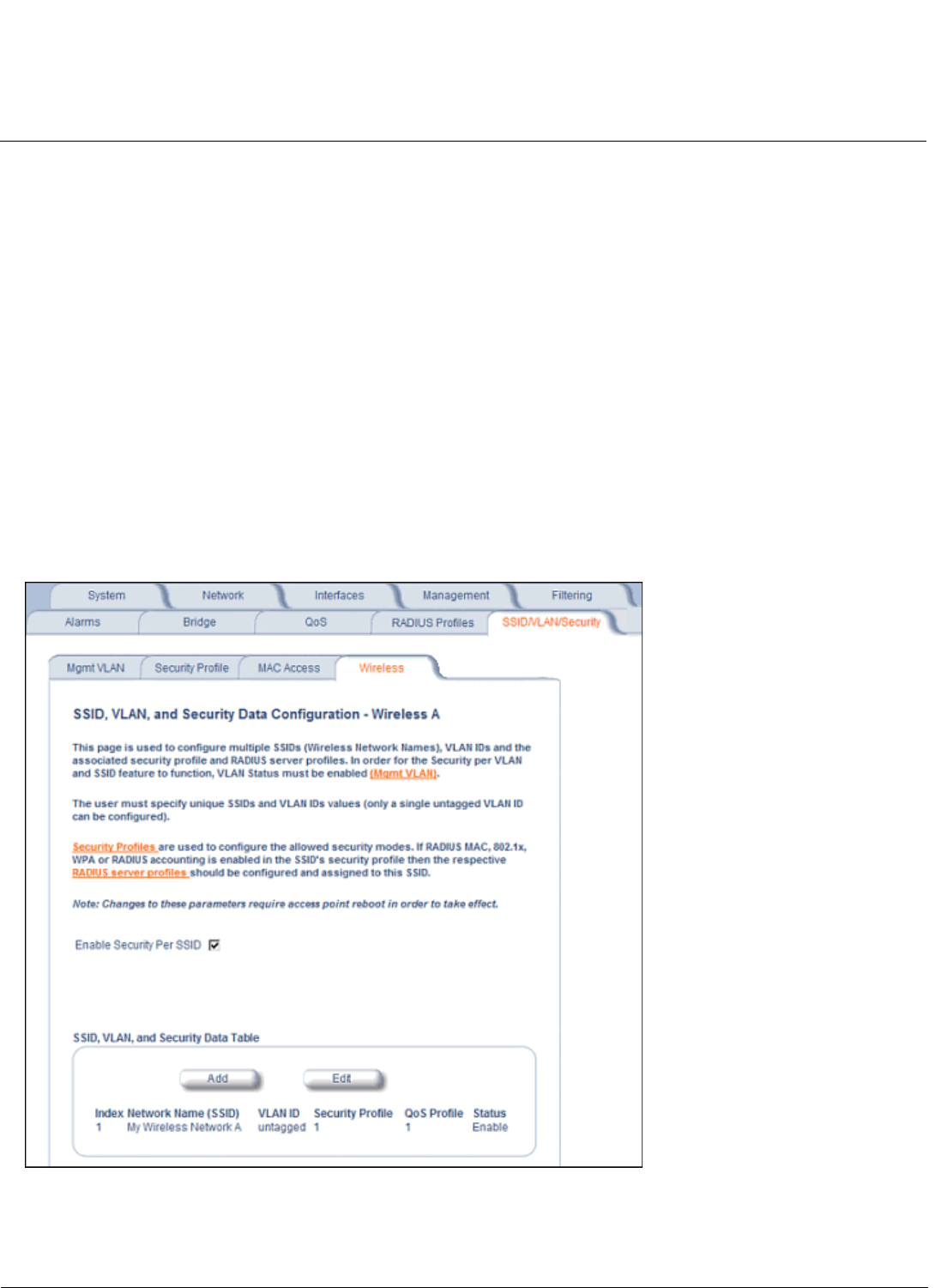
Advanced Configuration AP-700 User Guide
SSID/VLAN/Security
122
configured, then three SSIDs will be broadcast in individual beacons; the fourth and subsequent SSIDs will be
combined in one beacon and will not be broadcast. If Closed System is set to Enable, the SSID will not be broadcast
in the beacon. If Broadcast Unique Beacon is disabled, a combined beacon will be broadcast.
NOTE: Enabling Broadcast Unique Beacon will lower the total throughput of the AP by 2-4%. Enabling Broadcast
Unique Beacon simultaneously with Rogue Scan will cause a drift in the beacon interval and the occasional
missing of beacons.
14.Set the 802.1p Priority given to packets tagged with this VLAN ID. Enter a number between 0-7.
15.If editing an entry, enable or disable the parameters on this page by electing Enable or Disable from the Status
drop-down menu. If adding a new entry, this drop-down menu will not appear.
16.Click OK to return to Wireless Security Configuration Screen.
17.Reboot the AP.
Configuring SSID/VLANs with VLAN Tagging Enabled
With VLAN Tagging enabled (from the SSID/VLAN/Security > Mgmt VLAN tab), multiple SSID/VLANs are supported.
Parameters set on the Wireless tab can be enabled per SSID by choosing the Enable Security per SSID option.
1. Click SSID/VLAN/Security > Wireless.
2. Select the Enable Security Per SSID option. The screen will update to the following:
Figure 4-53 SSID/VLAN Configuration (VLAN Tagging Enabled)
NOTE: If you disable (uncheck) the Enable Security per SSID option, you will be able to add multiple SSID/VLANs,
but the same configuration parameters (described below) will applied to all of them.
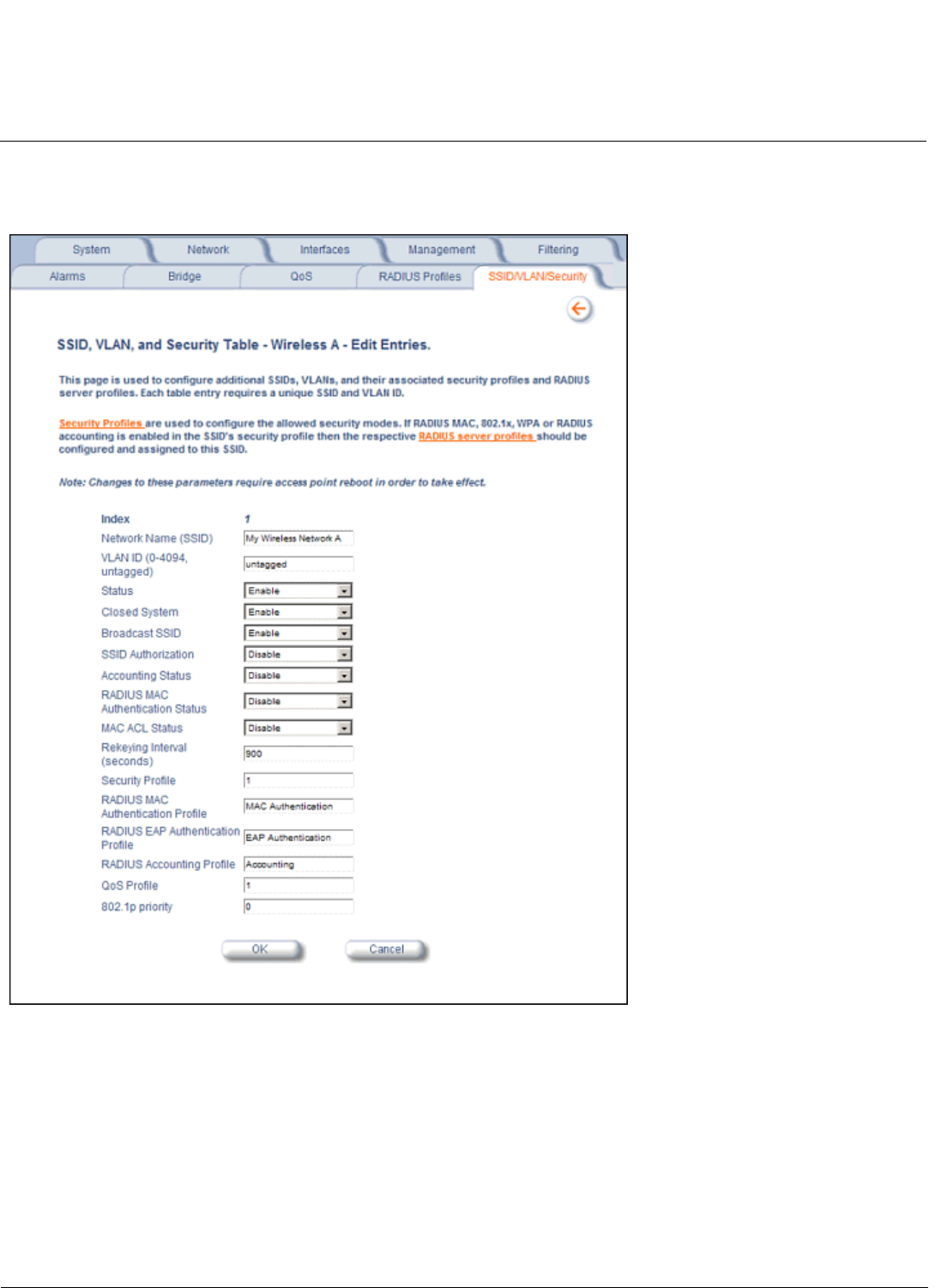
Advanced Configuration AP-700 User Guide
SSID/VLAN/Security
123
3. Click Add to configure additional SSIDs, VLANs, and their associated security profiles and RADIUS server profiles, or
click Edit to modify existing SSIDs.
The Add Entries or Edit Entries screen appears. See Figure 4-54.
Figure 4-54 SSID/VLAN Edit Entries Screen (VLAN Tagging Enabled)
4. Enter a unique Network Name (SSID) between 1 and 32 characters. This parameter is mandatory.
NOTE: Do not use quotation marks (single or double) in the Network Name; this will cause the AP to misinterpret the
name.
5. Enter a unique VLAN ID. This parameter is mandatory.
• A VLAN ID is a number from -1 to 4094. A value of -1 means that an entry is “untagged.”
• You can set the VLAN ID to “-1” or “untagged” if you do not want clients that are using a specific SSID to be
members of a VLAN workgroup. Only one “untagged” VLAN ID is allowed per interface.

Advanced Configuration AP-700 User Guide
SSID/VLAN/Security
124
• The VLAN ID must match an ID used by your network; contact your network administrator if you need assistance
defining the VLAN IDs.
6. Select the status of Closed System to control whether the SSID is advertised in the beacon and manage the way
probe requests are handled, as follows:
•Enable: The SSID is not advertised in the beacon, and the AP will respond to probe requests with an SSID only if
the client has specified the SSID in the probe request. If the client sends a probe request with a null or “ANY”
SSID, the AP will not respond.
•Partial: The SSID is advertised in the beacon, and the AP will not respond to "ANY" SSID requests. The Partial
setting reduces network traffic by eliminating the repeated broadcast of SSIDs in probe responses.
•Disable: The SSID is advertised in the beacon, and the AP will respond with each configured SSID, whether or
not an SSID has been specified in the probe request.
7. Enable Broadcast Unique Beacon using the drop-down menu. When enabled, Broadcast Unique Beacon allows the
broadcast of a up to four unique beacons when the AP is configured for multiple SSIDs. If Closed System (above) is
set to Partial or Disable, each beacon (up to four) will be broadcast a single SSID. If more than four SSIDs are
configured, then three SSIDs will be broadcast in individual beacons; the fourth and subsequent SSIDs will be
combined in one beacon and will not be broadcast. If Closed System is set to Enable, the SSID will not be broadcast
in the beacon. If Broadcast Unique Beacon is disabled, a combined beacon will be broadcast.
NOTE: Enabling Broadcast Unique Beacon will lower the throughput of the AP by 2-4%. Enabling Broadcast Unique
Beacon simultaneously with Rogue Scan will cause a drift in the beacon interval and the occasional missing of
beacons.
8. Enable or disable the SSID Authorization status from the drop-down menu. SSID Authorization is the RADIUS-based
authorization of the SSID for a particular client. The authorized SSIDs are sent as the tunnel attributes.
9. Enable or disable RADIUS accounting on the VLAN/SSID under the Accounting Status drop-down menu.
10.Enable or disable RADIUS MAC authentication status on the VLAN/SSID under the RADIUS Authentication Status
drop-down menu.
11.Enable or disable MAC Access Control List status on the VLAN/SSID under the MAC ACL Status drop-down menu.
12.Enter the Rekeying Interval in seconds (between 300 and 65525). When set to 0, this parameter is disabled. The
default is 900 seconds.
13.Enter the Security Profile used by the VLAN in the Security Profile field.
NOTE: If you have two or more SSIDs per interface using a Security Profile with a security mode of Non Secure, be
aware that security being applied in the VLAN is not being applied in the wireless network.
14.Define the RADIUS Server Profile Configuration for the VLAN/SSID:
• RADIUS MAC Authentication Profile
• RADIUS EAP Authentication Profile
• RADIUS Accounting Profile
If 802.1x, WPA, or 802.11i security mode is used, the RADIUS EAP Authentication Profile must have a value.
A RADIUS Server Profile for authentication for each VLAN shall be configured as part of the configuration options for
that VLAN. RADIUS profiles are independent of VLANs. The user can define any profile to be the default and
associate all VLANs to that profile. Four profiles are created by default, “MAC Authentication”, “EAP Authentication”,
Accounting”, and “Management”.
15.Specify a QoS Profile. See the Policy section for more information.
16.Set the 802.1p Priority given to packets tagged with this VLAN ID. Enter a number between 0-7.
17.If editing an entry, enable or disable the parameters on this page using Status drop-down menu. If adding a new entry,
this drop-down menu will not appear.
18.Reboot the AP.

125
AP-700 User Guide
5
Monitoring
This chapter discusses the following monitoring options:
•Version: Provides version information for the Access Point’s system components.
•ICMP: Displays statistics for Internet Control Message Protocol packets sent and received by the AP.
•IP/ARP Table: Displays the AP’s IP Address Resolution table.
•Learn Table: Displays the list of nodes that the AP has learned are on the network.
•IAPP: Provides statistics for the Inter-Access Point Protocol messages sent and received by the AP.
•RADIUS: Provides statistics for the configured RADIUS server(s).
•Interfaces: Displays the Access Point’s interface statistics (Wireless and Ethernet).
•Station Statistics: Displays statistics for stations and Wireless Distribution System links.
•Mesh Statistics: Displays statistics for the Mesh portal, including the network topology and the Neighbor Table. This
page is not relevant to the AP-700.
To monitor the AP using the HTTP/HTTPS interface, you must first log in to a web browser. See Logging In for
instructions.
You may also monitor the AP using the command line interface. See Command Line Interface (CLI) for more information
To monitor the AP via HTTP/HTTPS:
1. Click the Monitor button located on the left-hand side of the screen. The main Monitor screen will be displayed.
Figure 5-1 Monitor Main Screen
2. Click the tab that corresponds to the statistics you want to review. For example, click Learn Table to see the list of
nodes that the AP has discovered on the network.
3. If necessary, click the Refresh button to update the statistics.
Each Monitor tab is described in the remainder of this chapter.
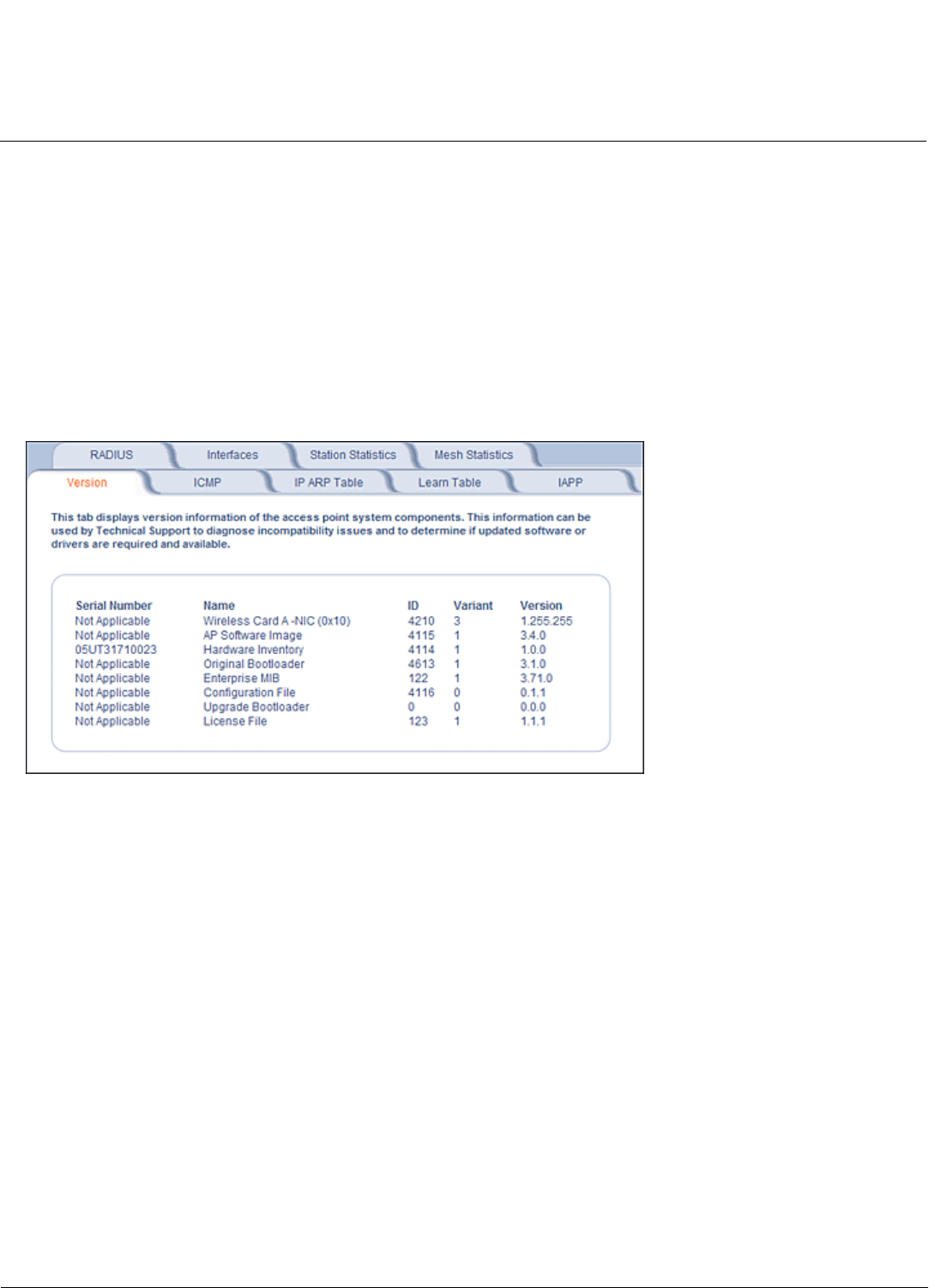
Monitoring AP-700 User Guide
Version
126
Version
From the HTTP interface, click the Monitor button and select the Version tab. The list displayed provides you with
information that may be pertinent when calling Technical Support. With this information, your Technical Support
representative can verify compatibility issues and make sure the latest software are loaded. This screen displays the
following information for each Access Point component:
•Serial Number: The component’s serial number, if applicable.
•Name/ID: The AP identifies a system component based on its name or ID. Each component has a unique identifier.
•Variant: Several variants may exist of the same component (for example, a hardware component may have two
variants, one with more memory than the other).
•Version: Specifies the component’s version or build number. The Software Image version is the most useful
information on this screen for the typical end user.
Figure 5-2 Version Monitoring Tab
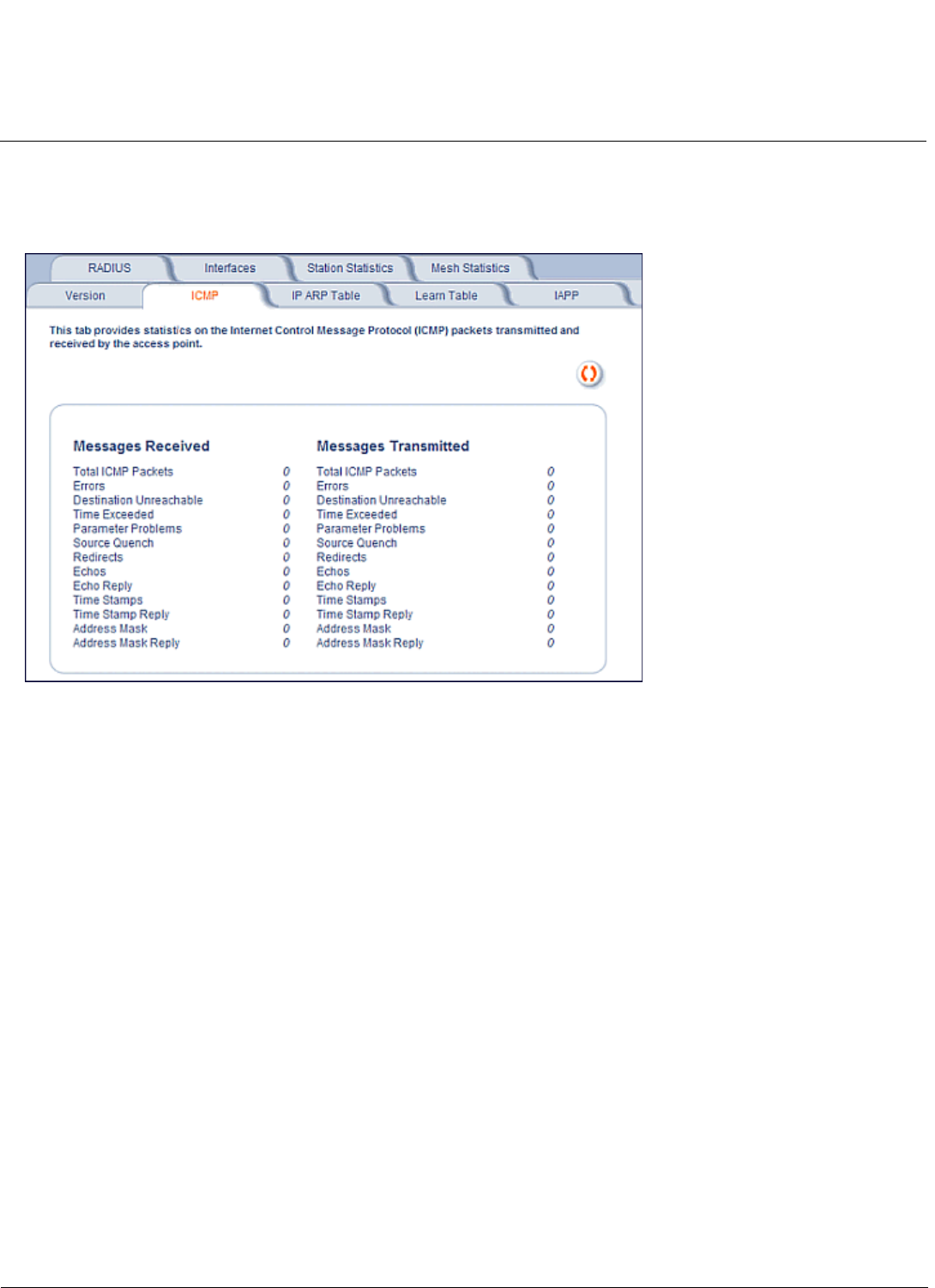
Monitoring AP-700 User Guide
ICMP
127
ICMP
This tab provides statistical information for both received and transmitted messages directed to the AP. Not all ICMP
traffic on the network is counted in the ICMP (Internet Control Message Protocol) statistics.
Figure 5-3 ICMP Monitoring Tab

Monitoring AP-700 User Guide
IP/ARP Table
128
IP/ARP Table
This tab provides information based on the Address Resolution Protocol (ARP), which relates MAC Address and IP
Addresses.
Figure 5-4 IP/ARP Table Monitoring Tab
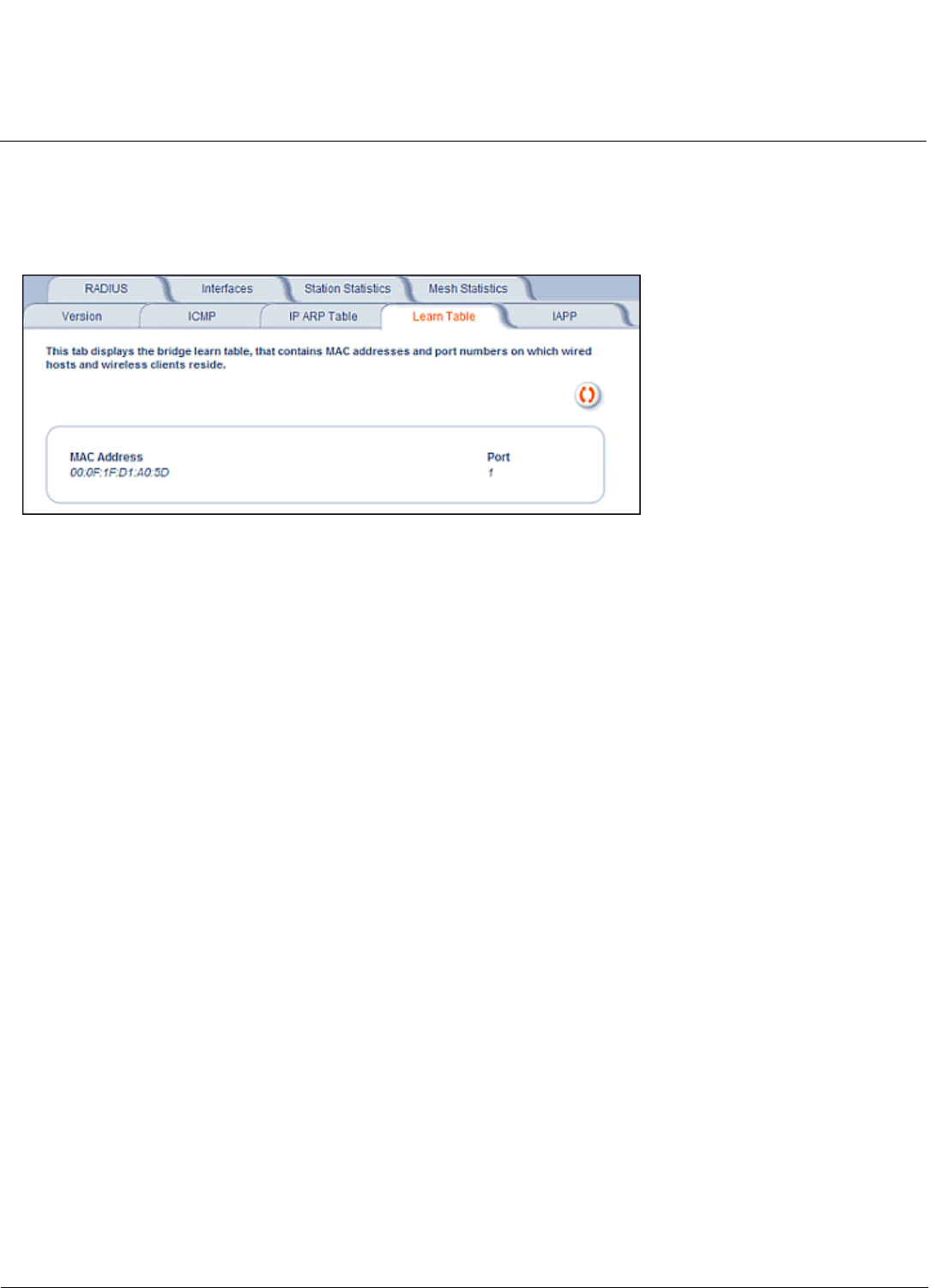
Monitoring AP-700 User Guide
Learn Table
129
Learn Table
This tab displays information relating to network bridging. It reports the MAC address for each node that the device has
learned is on the network and the interface on which the node was detected. There can be up 10,000 entries in the Learn
Table.
Figure 5-5 Learn Table Monitoring Tab

Monitoring AP-700 User Guide
IAPP
130
IAPP
This tab displays statistics relating to client handovers and communications between Access Points.
Figure 5-6 IAPP Monitoring Tab
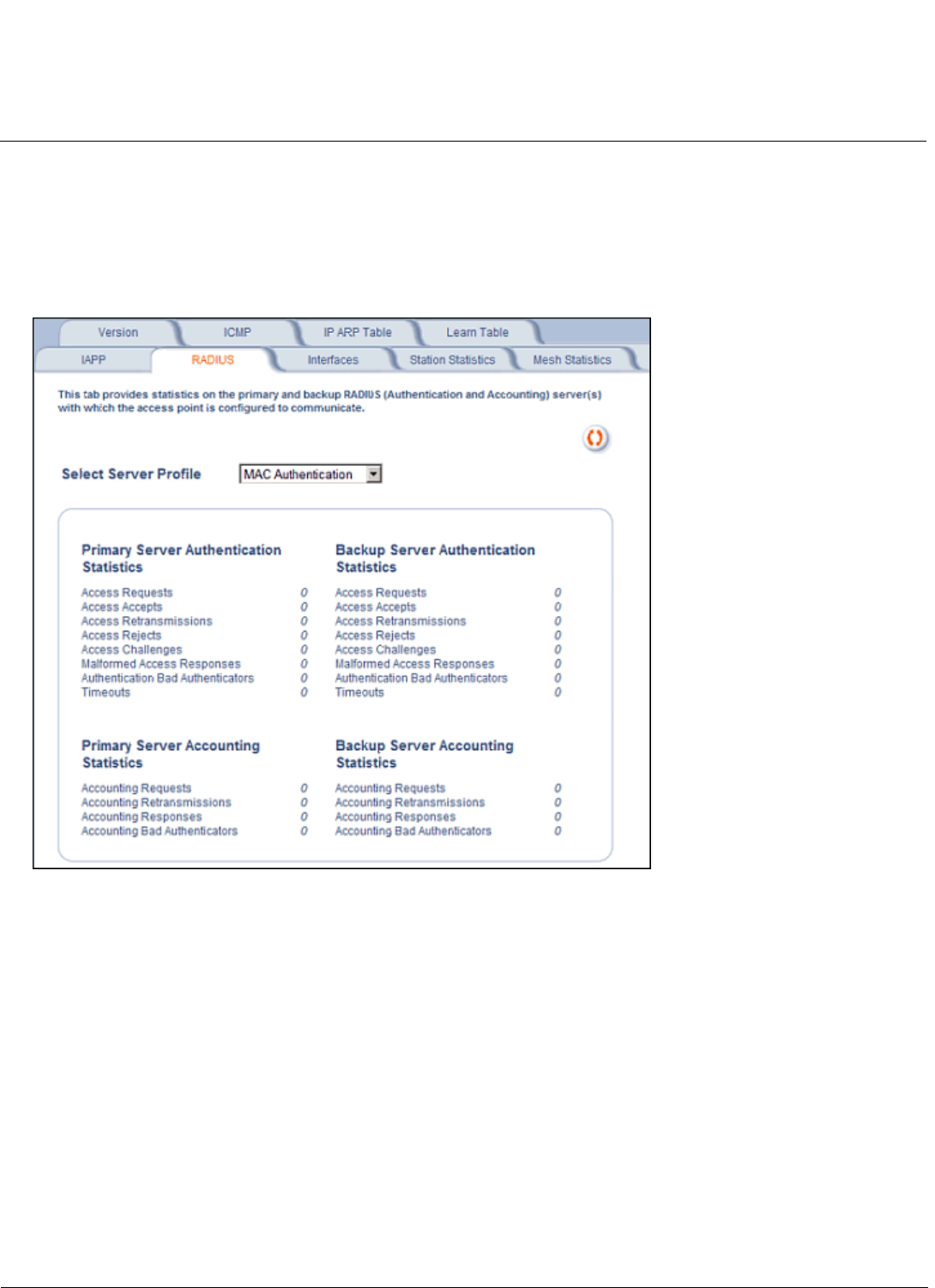
Monitoring AP-700 User Guide
RADIUS
131
RADIUS
This tab provides RADIUS authentication, EAP/802.1x authentication, and accounting information for both the Primary
and Backup RADIUS servers for each RADIUS Server Profile.
NOTE: Separate RADIUS servers can be configured for each RADIUS Server Profile.
Select the RADIUS Server Profile to view statistics on from the Select Server Profile drop-down menu.
Figure 5-7 RADIUS Monitoring Tab
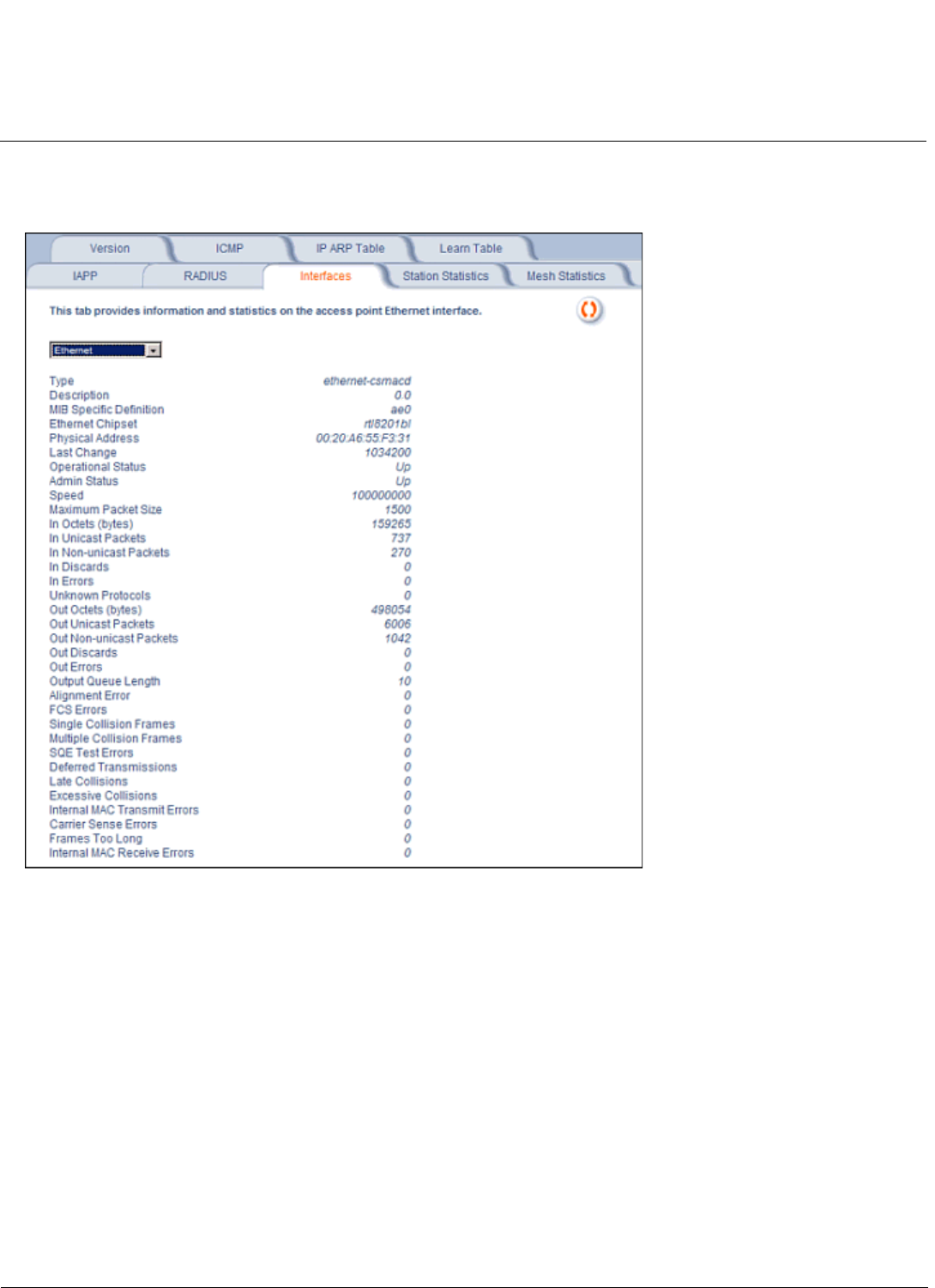
Monitoring AP-700 User Guide
Interfaces
132
Interfaces
This tab displays statistics for the Ethernet and wireless interfaces.
Figure 5-8 Interface Monitoring Tab (Ethernet)
Description of Interface Statistics
The following statistics are displayed for the Ethernet interface only, the wireless interface only, or for both the Ethernet
and Wireless interfaces:
•Admin Status (Ethernet/Wireless): The desired state of the interface: Up (ready to pass packets), Down (not ready to
pass packets, or Testing (testing and unable to pass packets).
•Alignment Error (Ethernet): The number of frames received that are not an integral number of octets in length and do
not pass the Frame Check Sequence check.
•Carrier Sense Errors (Ethernet): The number of times that the carrier sense condition was lost or never asserted
when attempting to transmit a frame. The count increments at most once per transmission attempt.
•Deferred Transmission (Ethernet): The number of frames for which the first transmission attempt is delayed because
the medium is busy.This number does not include frames involved in collisions.
•Description (Ethernet/Wireless): Information about the interface (e.g., the name of the manufacturer, the product
name and the version of the hardware interface).
•Duplicate Frame Count (Wireless): The number of duplicate frames received.

Monitoring AP-700 User Guide
Interfaces
133
•Ethernet Chipset (Ethernet): Identifies the chipset used to realize the interface.
•Excessive Collisions (Ethernet): The number of frames for which transmission fails due to excessive collisions.
•Failed ACK Count (Wireless): The number of times an acknowledgment (or ACK) is not received when expected.
•Failed Count (Wireless): The number of packets not transmitted successfully due to too many transmit attempts.
•Failed RTS Count (Wireless: The number of times a Clear to Send (CTS) is not received in response to a Request to
Send (RTS).
•FCS Error (Wireless): The number of Frame Check Sequence errors detected in received MAC Protocol Data Units
(MPDUs).
•FCS Errors (Ethernet): The number of frames received that are an integral number of octets in length but do not pass
the Frame Check Sequence check.
•Frames Too Long (Ethernet): The number of frames received that exceed the maximum permitted frame size.
•In Discards (Ethernet/Wireless): The number of error-free inbound packets that were chosen to be discarded to
prevent their being deliverable to a higher-layer protocol. One possible reason for discarding such a packet could be
to free up buffer space.
•In Errors (Ethernet/Wireless): The number of inbound packets that contained errors preventing them from being
deliverable to a higher-layer protocol.
•In Non-unicast Packets (Ethernet/Wireless): The number of non-unicast (i.e., subnetwork-broadcast or
subnetwork-multicast) packets delivered to a higher-layer protocol.
•In Octets (bytes) (Ethernet/Wireless): The total number of octets received on the interface, including framing
characters.
•In Unicast Packets (Ethernet/Wireless): The number of subnetwork unicast packets delivered to a higher-layer
protocol.
•Internal MAC Receive Errors (Ethernet): The number of frames for which reception fails due to an internal MAC
sublayer transmit error. A frame is only counted if it is not counted by the Frames Too Long, Alignment Error, or FCS
Error counters.
•Internal MAC Transmit Errors (Ethernet): The number of frames for which transmission fails due to an internal MAC
sublayer transmit error. A frame is only counted if it is not counted by Late Collision, Excession Collision, or Carrier
Sense Error counters.
•Last Change (Ethernet/Wireless): The value of the sysUpTime object at the time the interface entered its current
operational state.
•Late Collisions (Ethernet): The number of times that a collision is detected on a particular interface later than 512
bit-times into the transmission of a packet
•MAC Address (Wireless): The station's assigned, unique MAC address,
•Maximum Packet Size (Ethernet/Wireless): The size (in octets) of the largest datagram which can be sent/received
•MIB Specific Definition (Ethernet/Wireless): A reference to MIB definitions specific to the particular media being
used to realize the interface. For example, if the interface is an Ethernet interface, then this field refers to a document
defining objects specific to ethernet.
•Multicast Received Frame Count (Wireless): The number of multicast packets received.
•Multicast Transmitted Frame Count (Wireless): The number of multicast packets transmitted.
•Multiple Collision Frames (Ethernet): The number of successfully transmitted frames for which transmission is
inhibited by more than one collision.
•Multiple Retry Count (Wireless): The number of packets successfully transmitted after more than one
retransmission.
•Operational Status (Ethernet/Wireless): The current state of the interface: Up (ready to pass packets), Down (not
ready to pass packets, or Testing (testing and unable to pass packets).
•Out Discards (Ethernet/Wireless): The number of error-free outbound packets chosen to be discarded to prevent
their being transmitted. One possible reason for discarding such a packet could be to free up buffer space.

Monitoring AP-700 User Guide
Interfaces
134
•Out Errors (Ethernet/Wireless): The number of outbound packets that could not be transmitted because of errors.
•Out Non-unicast Packets (Ethernet/Wireless): The total number of packets that higher-level protocols requested be
transmitted to a non-unicast (i.e., a subnetwork-broadcast orsubnetwork-multicast) address, including those that were
discarded or not sent.
•Out Octets (bytes) (Ethernet/Wireless): The total number of octets transmitted out of the interface, including framing
characters.
•Out Unicast Packets (Ethernet/Wireless): The total number of packets that higher-level protocols requested be
transmitted to a subnetwork-unicast address, including those that were discarded or not sent.
•Output Queue Length (Ethernet/Wireless): The length of the output packet queue (in packets).
•Physical Address (Ethernet): The interface's address at the protocol layer immediately below the network layer in the
protocol stack.
•Received Fragment Count (Wireless): The number of successfully received Data or Management MAC Protocol
Data Units (MPDUs).
•Retry Count (Wireless): The number of packets successfully transmitted after one or more retransmissions.
•Single Collision Frames (Ethernet): The number of successfully transmitted frames for which transmission is
inhibited by exactly one collision
•Speed (Ethernet/Wireless): An estimate of the interface's current bandwidth in bits per second.
•SQE Test Errors (Ethernet): The number of times that the Signal Quality Error (SQE) Test Error message is
generated by the physical layer signalling (PLS) sublayer.
•Successful RTS Count (Wireless): The number of times a Clear to Send (CTS) is received in response to an
Request to Send (RTS).
•Transmitted Fragment Count (Wireless): The number of transmitted fragmented packets.
•Transmitted Frame Count (Wireless): This number of successfully transmitted packets.
•Type (Ethernet/Wireless): The type of interface, distinguished according to the physical/link protocol(s) immediately
below the network layer in the protocol stack.
•Unknown Protocols (Ethernet/Wireless): The number of packets received that were discarded because of an
unknown or unsupported protocol.
•WEP Undecryptable Count (Wireless): The number of undecryptable WEP frames received.
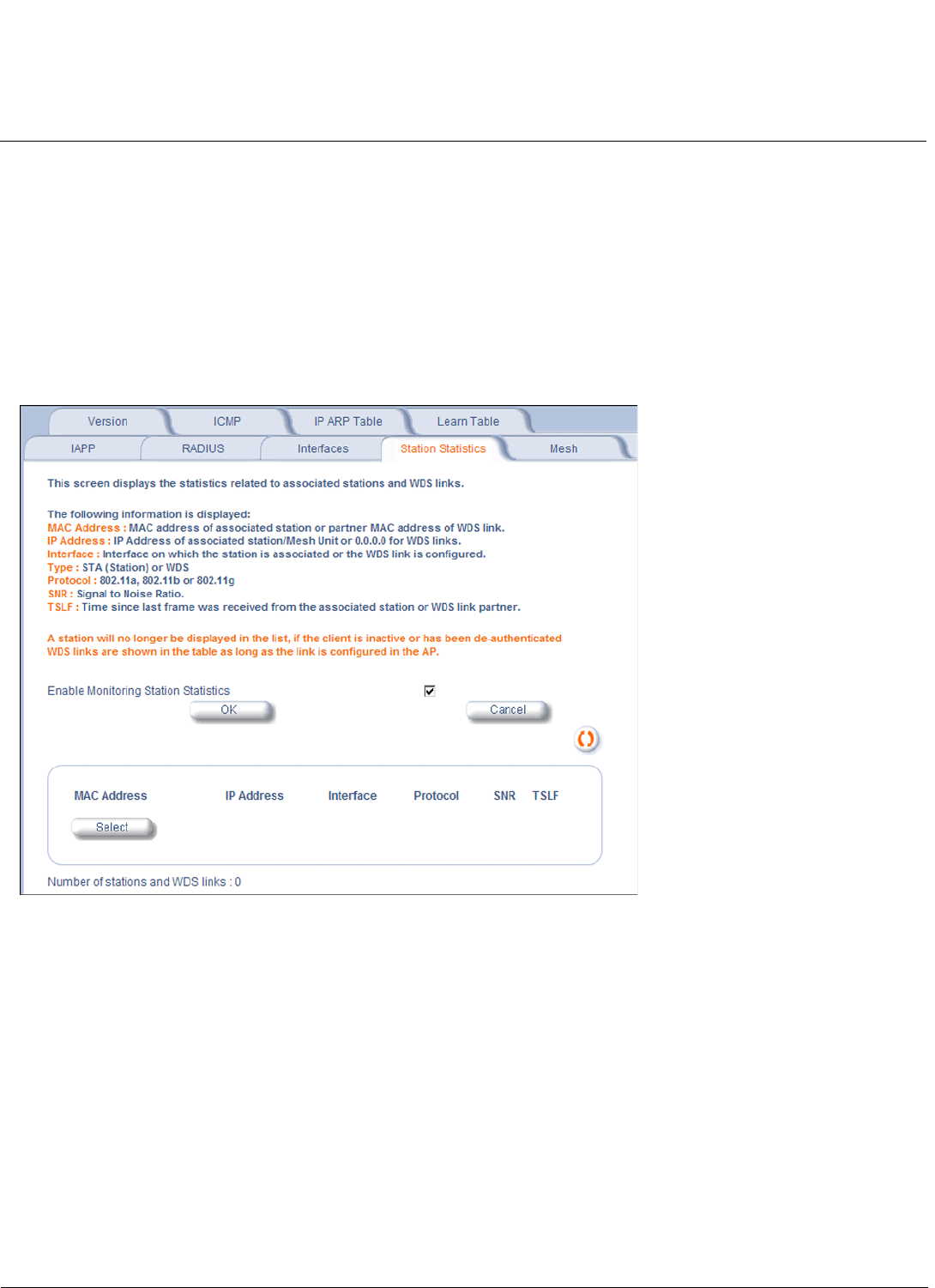
Monitoring AP-700 User Guide
Station Statistics
135
Station Statistics
This tab displays information on wireless clients attached to the AP and on Wireless Distribution System.
Enable the Monitoring Station Statistics feature (Station Statistics are disabled by default) by checking Enable
Monitoring Station Statistics and click OK.
You do not need to reboot the AP for the changes to take effect. If clients are connected to the device or WDS links are
configured for the device, the statistics will now be shown on the screen. Click Select to view the more detailed statistics
for a client.
Click on the Refresh button in the browser window to view the latest statistics. If any new clients associate to the AP, you
can see the statistics of the new clients after you click the refresh button.
Figure 5-9 Station Statistics Monitoring Tab
Description of Station Statistics
The following stations statistics are displayed:
•MAC Address: The MAC address of the wireless client for which the statistics are gathered. For WDS links, this is the
partner MAC address of the link.
•IP Address: The IP address of the associated wireless station for which the Statistics are gathered. (0.0.0.0 for WDS
links)
•Interface to which the Station is connected: The interface number on which the client is connected with the AP. For
WDS links this is the interface on which the link is configured.
•MAC Protocol: The MAC protocol for this wireless client (or WDS link partner). The possible values are 802.11a,
802.11b, 802.11g.
•Signal / Noise: The Signal /Noise Level measured at the AP when frames are received from the associated wireless
station (or WDS link partner).

Monitoring AP-700 User Guide
Station Statistics
136
•Time since Last Frame Received: The time elapsed since the last frame from the associated wireless station (or
WDS link partner) was received.
•Number of Stations and WDS Links: The number of stations and WDS links monitored.
The following stations statistics are available through SNMP:
•Octets Received: The number of octets received from the associated wireless station (or WDS link partner) by the
AP.
•Unicast Frames Received: The number of Unicast frames received from the associated wireless station (or WDS link
partner) by the AP.
•Non-Unicast Frames Received: The number of Non-Unicast frames received (i.e. broadcast or multicast) from the
associated wireless station (or WDS link partner) by the AP.
•Octets Transmitted: The number of octets sent to the associated wireless station (or WDS link partner) from the AP.
•Unicast Frames Transmitted: The number of Unicast frames transmitted to the associated wireless station (or WDS
link partner) from the AP.

138
AP-700 User Guide
6
Commands
This chapter contains information on the following Command functions:
•Introduction to File Transfer via TFTP or HTTP: Describes the available file transfer methods.
•Update AP: Download files via TFTP or HTTP to the AP.
•Retrieve File: Upload configuration files from the AP to a TFTP server.
•Reboot: Reboot the AP in the specified number of seconds.
•Reset: Reset all of the Access Point’s configuration settings to factory defaults.
•Help Link: Configure the location where the AP Help files can be found.
To perform commands using the HTTP/HTTPS interface, you must first log in to a web browser. See Logging In for
instructions.
You may also perform commands using the command line interface. See Command Line Interface (CLI) for more
information.
To perform commands via HTTP/HTTPS:
1. Click the Commands button located on the left-hand side of the screen.
Figure 6-1 Commands Main Screen
2. Click the tab that corresponds to the command you want to issue. For example, click Reboot to restart the unit.
Following a brief introduction to TFTP and HTTP file transfer, each Commands tab is described in the remainder of this
chapter.

Commands AP-700 User Guide
Introduction to File Transfer via TFTP or HTTP
139
Introduction to File Transfer via TFTP or HTTP
There are two methods of transferring files to or from the AP: TFTP or HTTP (or HTTPS if enabled):
• Downloading files (Configuration, AP Image, Bootloader, License, Private Key, Certificate, CLI Batch File) to the AP
using one of these two methods is called “Updating the AP.”
• Uploading files (Configuration, CLI Batch File, etc) from the AP is called “Retrieving Files.”
TFTP File Transfer Guidelines
A TFTP server must be running and configured to point to the directory containing the file.
If you do not have a TFTP server installed on your system, install the TFTP server from the installation CD.
HTTP File Transfer Guidelines
HTTP file transfer can be performed either with or without SSL enabled.
HTTP file transfers with SSL require enabling Secure Management and Secure Socket Layer. HTTP transfers that use
SSL may take additional time.
NOTE: SSL requires Internet Explorer version 6, 128 bit encryption, Service Pack 1, and patch Q323308.
Image Error Checking During File Transfer
The Access Point performs checks to verify that an image downloaded through HTTP or TFTP is valid. The following
checks are performed on the downloaded image:
• Zero Image size
• Large image size
• Non VxWorks image
• AP image
• Digital signature verification
If any of the above checks fail on the downloaded image, the Access Point deletes the downloaded image and retains the
old image. Otherwise, if all checks pass successfully, the AP deletes the old image and retains the downloaded image.
These checks are to ensure that the AP does not enter an invalid image state. The storage of the two images is only
temporary to ensure the proper verification; the two images will not be stored in the AP permanently.
Image error checking functions automatically in the background. No user configuration is required.
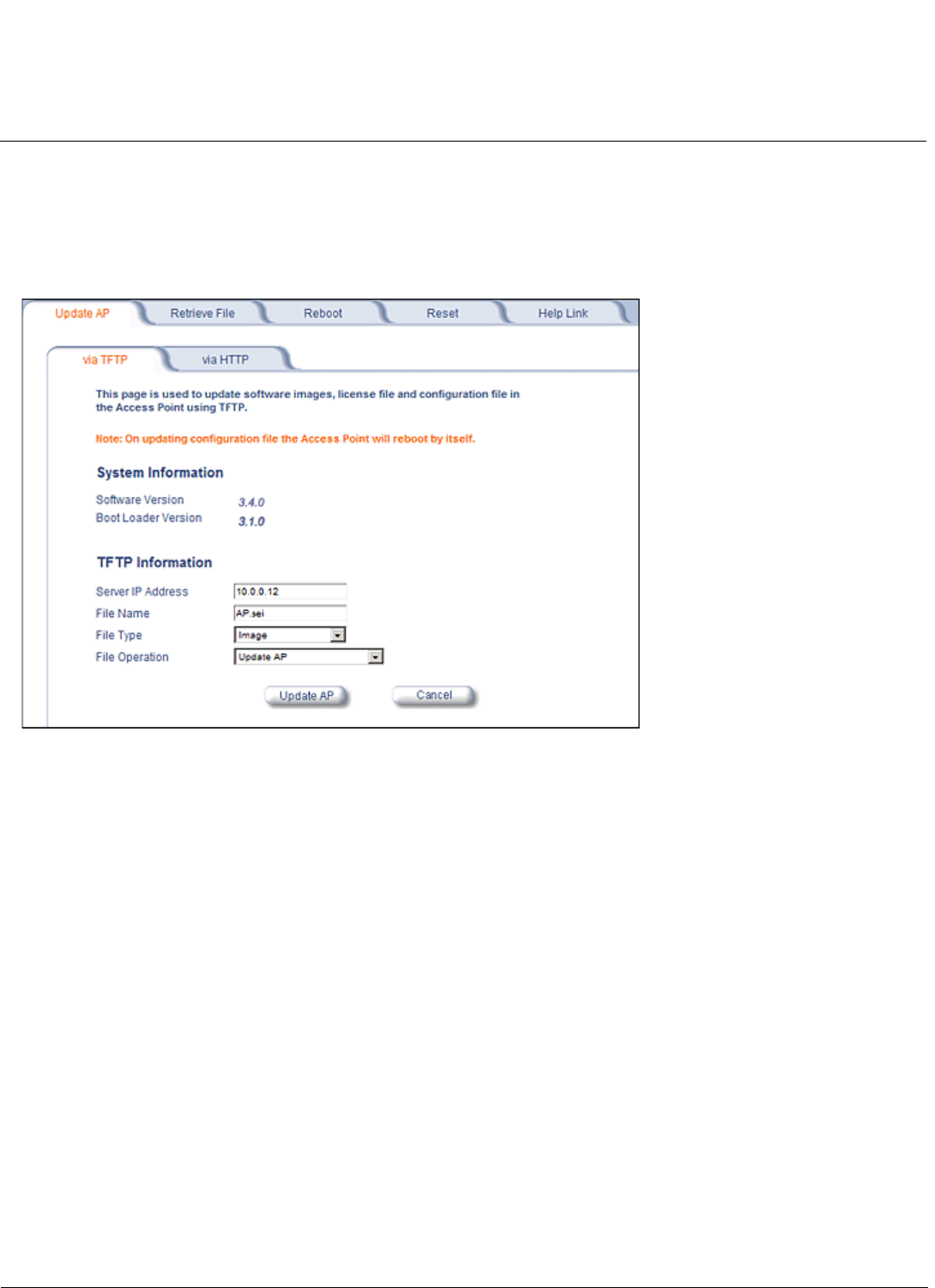
Commands AP-700 User Guide
Update AP
140
Update AP
Update AP via TFTP
Use the Update AP via TFTP tab to download Configuration, AP Image, Bootloader files, Certificate and Private Key files,
and CLI Batch File to the AP. A TFTP server must be running and configured to point to the directory containing the file.
Figure 6-2 Update AP via TFTP Command Screen
If you do not have a TFTP server installed on your system, install the TFTP server from the installation CD. You can either
install the TFTP server from the CD Wizard or run OEM-TFTP-Server.exe found in the CD’s Xtras/SolarWinds
sub-directory.
The Update AP via TFTP tab shows version information and allows you to enter TFTP information as described below.
•Server IP Address: Enter the TFTP server IP Address.
– Double-click the TFTP server icon on your desktop and locate the IP address assigned to the TFTP server.
NOTE: This is the IP address that will be used to point the Access Point to the AP Image file.
•File Name: Enter the name of the file to be downloaded (including the file extension).
– Copy the file to the TFTP server’s root folder.
•File Type: Select the proper file type. Choices include:
–Config: configuration information, such as System Name, Contact Name, and so on.
NOTE: The AP will reboot automatically when downloading a Config file.
–Image: AP Image (executable program).
–Upgrade BspBl: Bootloader software.
–SSL Certificate: the digital certificate for authentication in SSL communications.
–SSL Private Key: the private key for encryption in SSL communications.
–SSH Public Key: the public key in SSH communications. See Secure Shell (SSH) Settings for more information.
–SSH Private Key: the private key in SSH communications. See Secure Shell (SSH) Settings for more information.
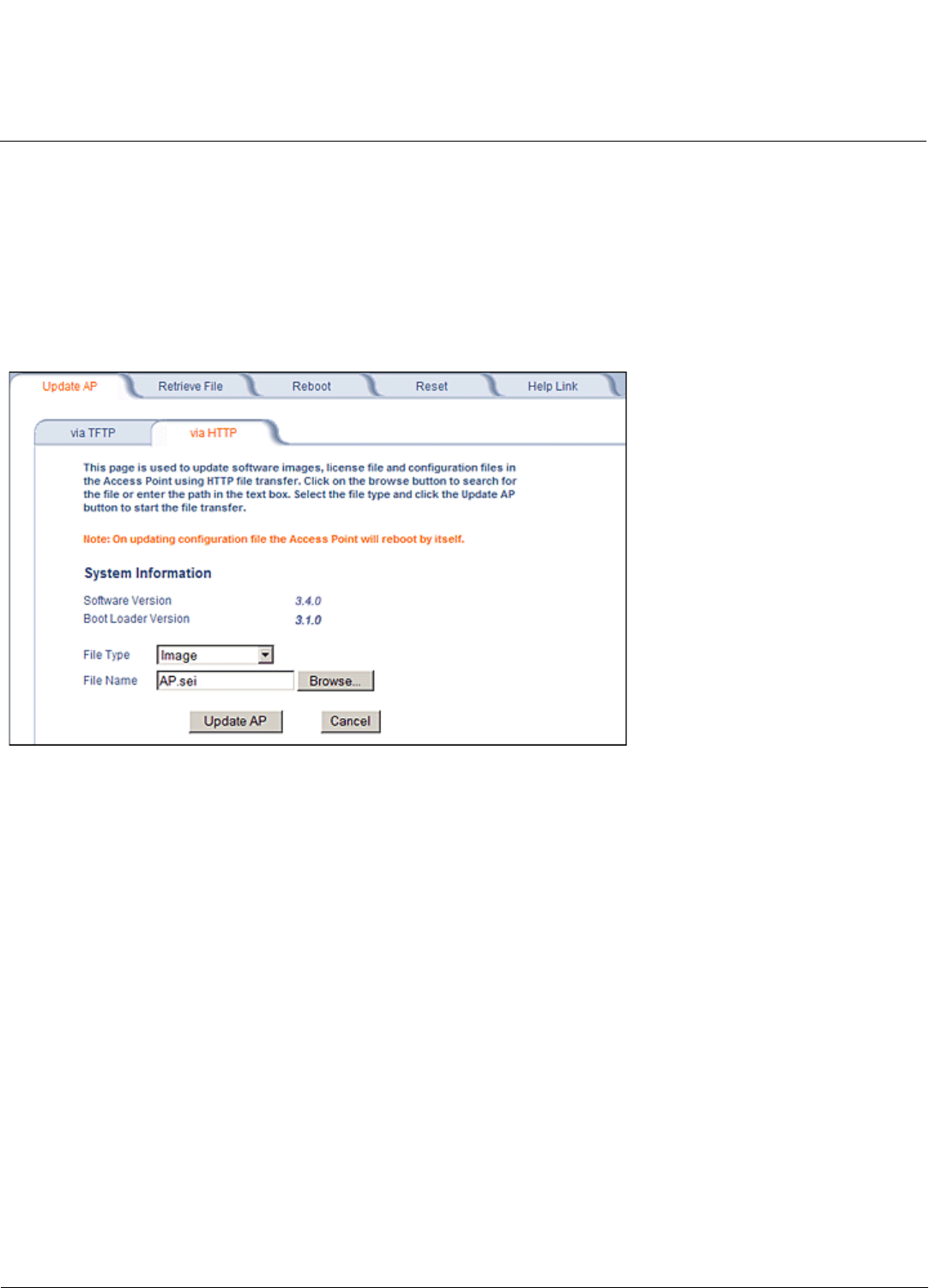
Commands AP-700 User Guide
Update AP
141
–CLI Batch File: a CLI Batch file that contains CLI commands to configure the AP. This file will be executed by the
AP immediately after being uploaded. See CLI Batch File for more information.
•File Operation: Select either Update AP or Update AP & Reboot. You should reboot the AP after downloading files.
Update AP via HTTP
Use the Update AP via HTTP tab to download Configuration, AP Image, Bootloader files, and Certificate and Private Key
files to the AP.
Once on the Update AP screen, click on the via HTTP tab.
Figure 6-3 Update AP via HTTP Command Screen
The Update AP via HTTP tab shows version information and allows you to enter HTTP information as described below.
1. Select the File Type that needs to be updated from the drop-down box. Choices include:
–Image for the AP Image (executable program).
–Config for configuration information, such as System Name, Contact Name, and so on.
NOTE: The AP will reboot automatically when downloading a Config file.
–SSL Certificate: the digital certificate for authentication in SSL communications.
–SSL Private Key: the private key for encryption in SSL communications.
–Upgrade BSPBL: the Bootloader software.
–CLI Batch File: a CLI Batch file that contains CLI commands to configure the AP. This file will be executed by the
AP immediately after being uploaded. See CLI Batch File for more information.
–SSH Public Key: the public key in SSH communications. See Secure Shell (SSH) Settings for more information.
–SSH Private Key: the private key in SSH communications. See Secure Shell (SSH) Settings for more information.
2. Use the Browse button or manually type in the name of the file to be downloaded (including the file extension) in the
File Name field. If typing the file name, you must include the full path and the file extension in the file name text box.
3. To initiate the HTTP Update operation, click the Update AP button.
A warning message gets displayed that advises the user that a reboot of the device will be required for changes to
take effect.

Commands AP-700 User Guide
Update AP
142
Figure 6-4 Warning Message
4. Click OK to continue with the operation or Cancel to abort the operation.
NOTE: An HTTP file transfer using SSL may take extra time.
If the operation completes successfully the following screen appears.
Figure 6-5 Update AP Successful
If the operation did not complete successfully the following screen appears, and the reason for the failure is displayed.
Figure 6-6 Update AP Unsuccessful
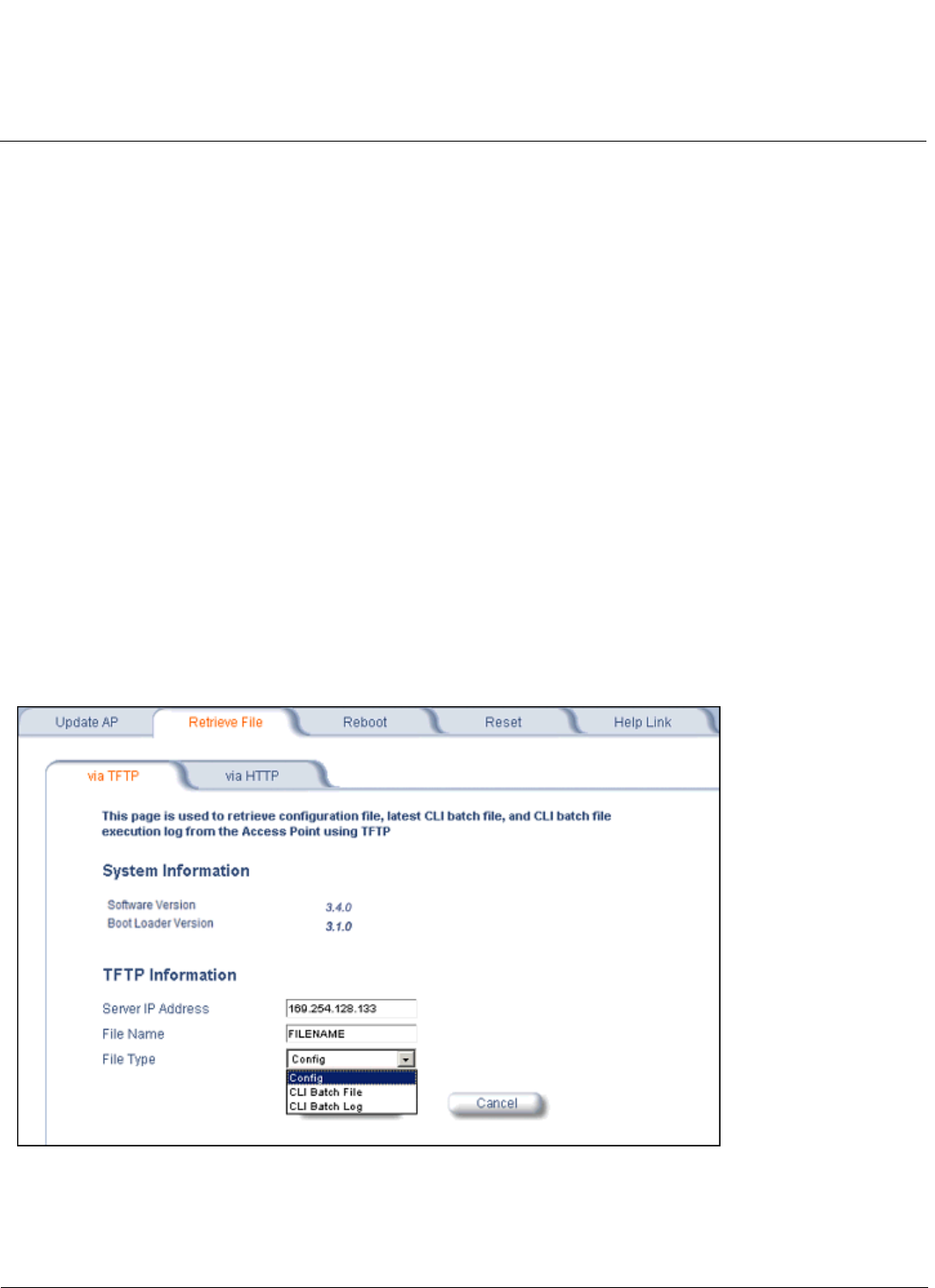
Commands AP-700 User Guide
Retrieve File
143
Retrieve File
Retrieve File via TFTP
Use the Retrieve File via TFTP tab to upload files from the AP to the TFTP server. The TFTP server must be running
and configured to point to the directory to which you want to copy the uploaded file. We suggest you assign the file a
meaningful name, which may include version or location information.
If you don’t have a TFTP server installed on your system, install the TFTP server from the installation CD. You can either
install the TFTP server from the CD Wizard or run OEM-TFTP-Server.exe found in the CD’s Xtras/SolarWinds
sub-directory.
The Retrieve AP via TFTP tab shows version information and allows you to enter TFTP information as described below.
•Server IP Address: Enter the TFTP server IP Address.
– Double-click the TFTP server icon on your desktop and locate the IP address assigned to the TFTP server.
•File Name: Enter the name of the file to be uploaded.
•File Type: Select the type of file to be uploaded: Config file, CLI Batch File, or CLI Batch (Error) Log.
Use the following procedure to retrieve a file from an AP to a TFTP server:
1. If retrieving a Config file, configure all the required parameters in their respective tabs. Reboot the device.
2. Retrieve and store the file. Click the Retrieve File button to initiate the upload of the file from the AP to the TFTP
server.
3. If you retrieved a Configuration file, update the file as necessary.
4. If you retrieved a CLI Batch File or CLI Batch Log, you can examine the file using a standard text editor. For more
information on CLI Batch Files, see CLI Batch File.
Figure 6-7 Retrieve File via TFTP Command Screen
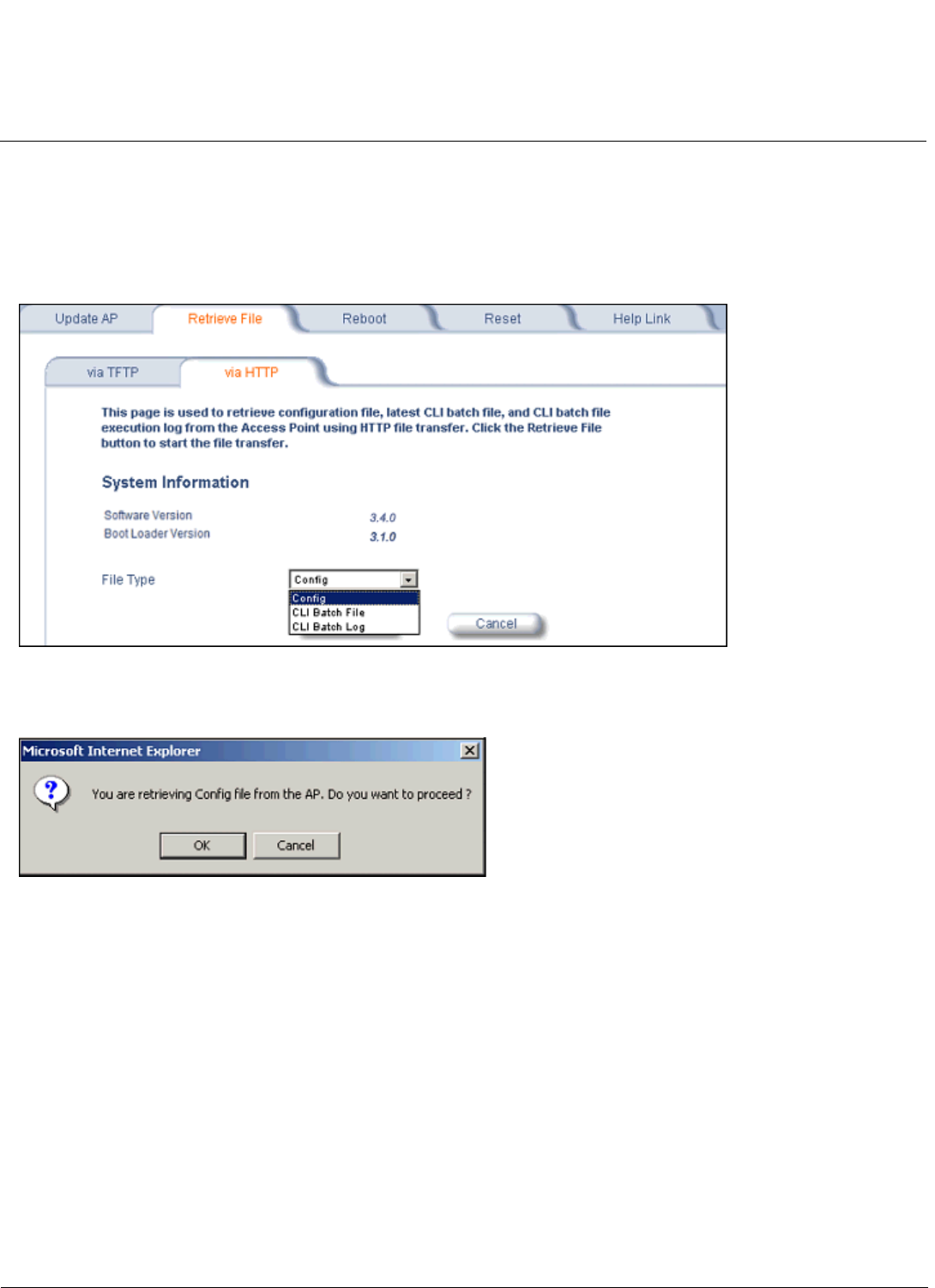
Commands AP-700 User Guide
Retrieve File
144
Retrieve File via HTTP
Use the Retrieve File via HTTP tab to retrieve configuration files, CLI Batch Files, or CLI Batch Logs from the AP. For
more information on CLI Batch Files and CLI Batch Logs see CLI Batch File.
1. Select the type of file (Config, CLI Batch File, CLI Batch Log) from the File Type drop-down menu.
2. Click on the Retrieve File button to initiate the operation.
Figure 6-8 Retrieve File via HTTP Command Screen
A confirmation message is displayed, asking if the user wants to proceed with retrieving the file.
Figure 6-9 Retrieve File Confirmation Dialog
3. Click OK to continue with the operation or Cancel to abort the operation. On clicking OK, the File Download window
appears.
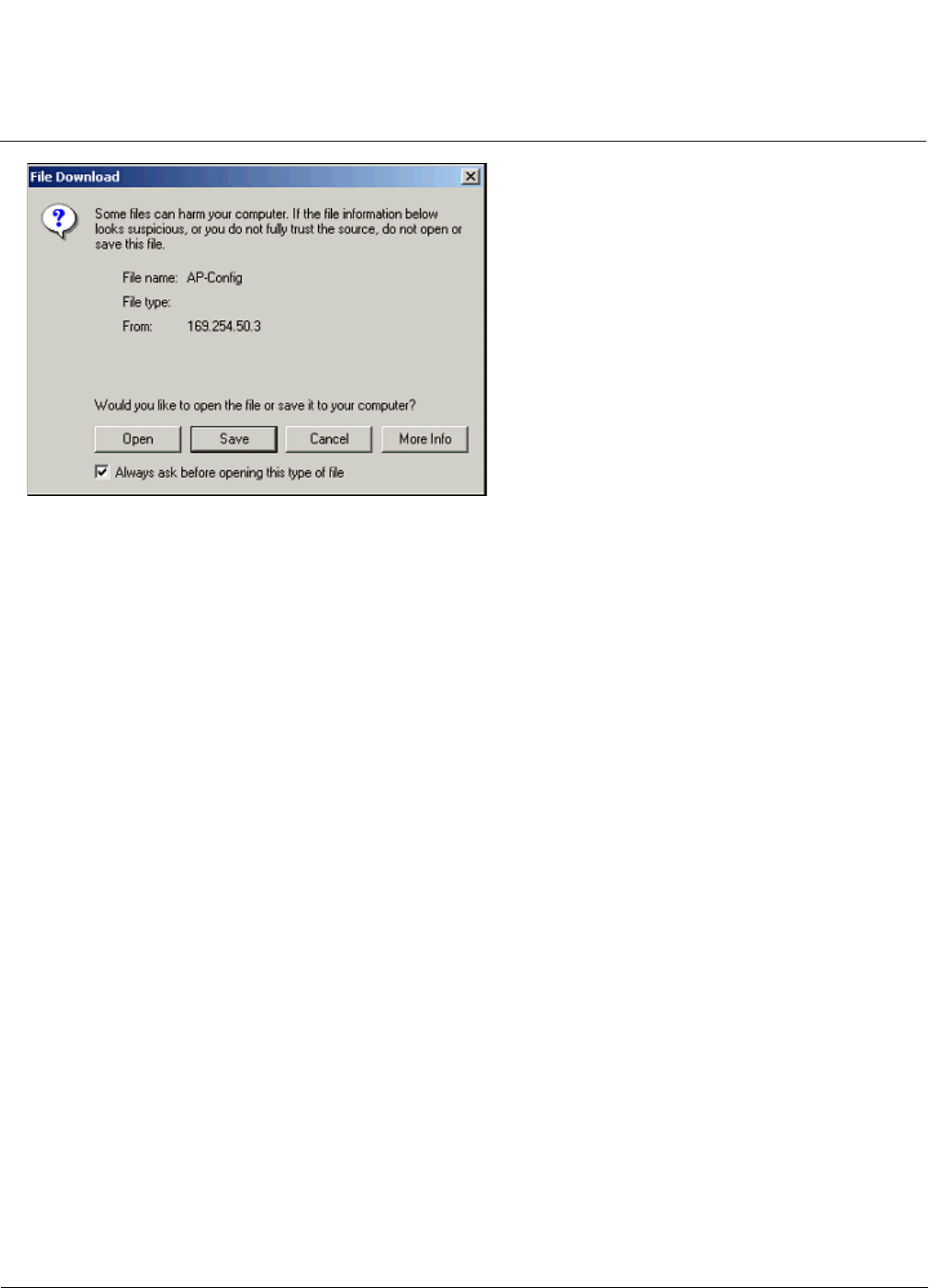
Commands AP-700 User Guide
Retrieve File
145
Figure 6-10 File Download Dialog Box
4. On clicking the Save button the Save As window displays. Select an appropriate filename and location and click OK.
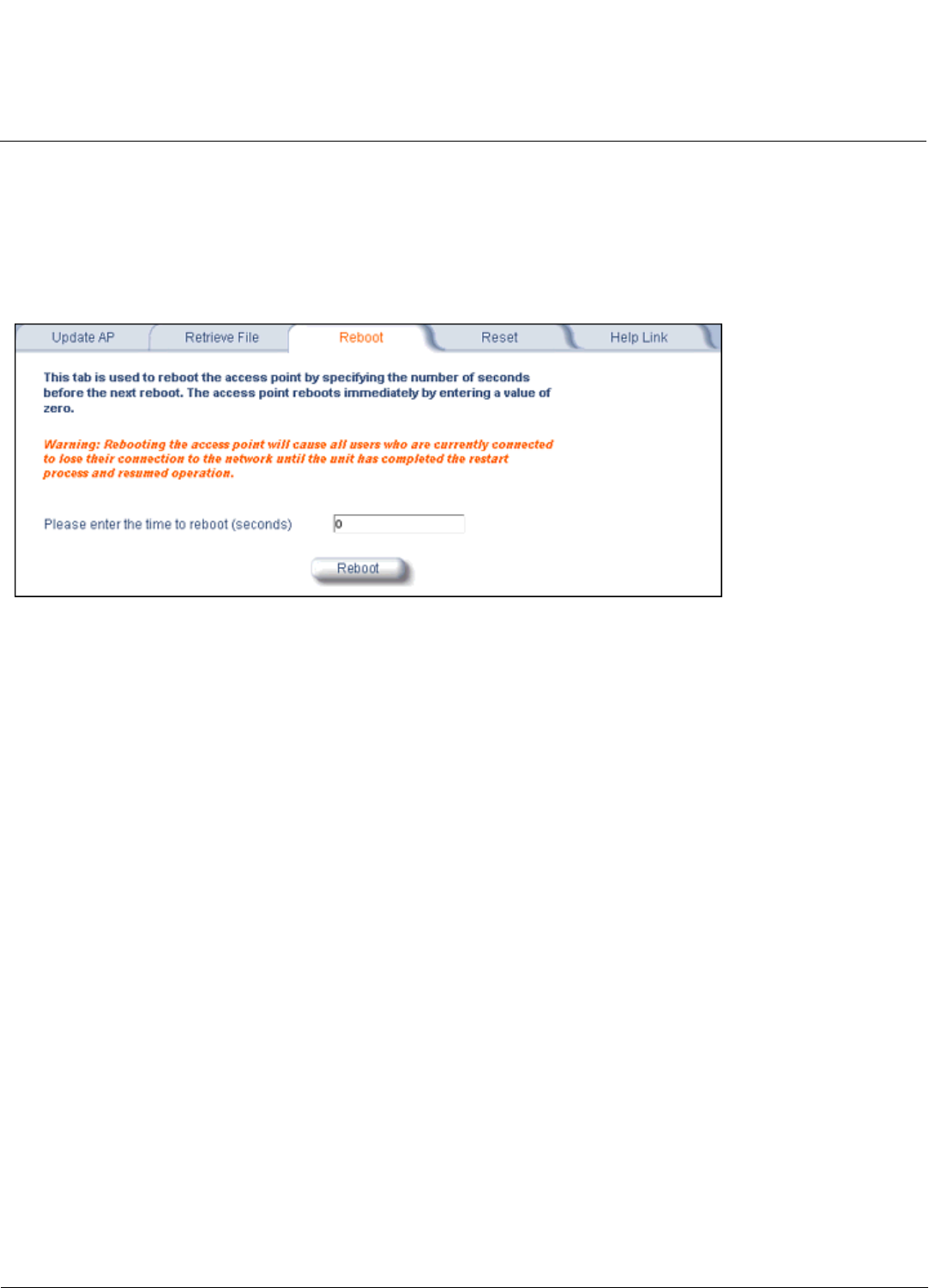
Commands AP-700 User Guide
Reboot
146
Reboot
Use the Reboot tab to save configuration changes (if any) and reset the AP. Enter a value between 0 and 65535
seconds; entering a value of 0 (zero) seconds causes an immediate reboot. Note that Reset, described below, does not
save configuration changes.
CAUTION: Rebooting the AP will cause all users who are currently connected to lose their connection to the network
until the AP has completed the restart process and resumed operation.
Figure 6-11 Reboot Command Screen

Commands AP-700 User Guide
Reset
147
Reset
Use the Reset tab to restore the AP to factory default conditions. Since this will reset the AP’s current IP address, a new
IP address must be assigned. See Initialization for more information.
CAUTION: Resetting the AP to its factory default configuration will permanently overwrite all changes that have made to
the unit. The AP will reboot automatically after this command has been issued.
Figure 6-12 Reset to Factory Defaults Command Screen
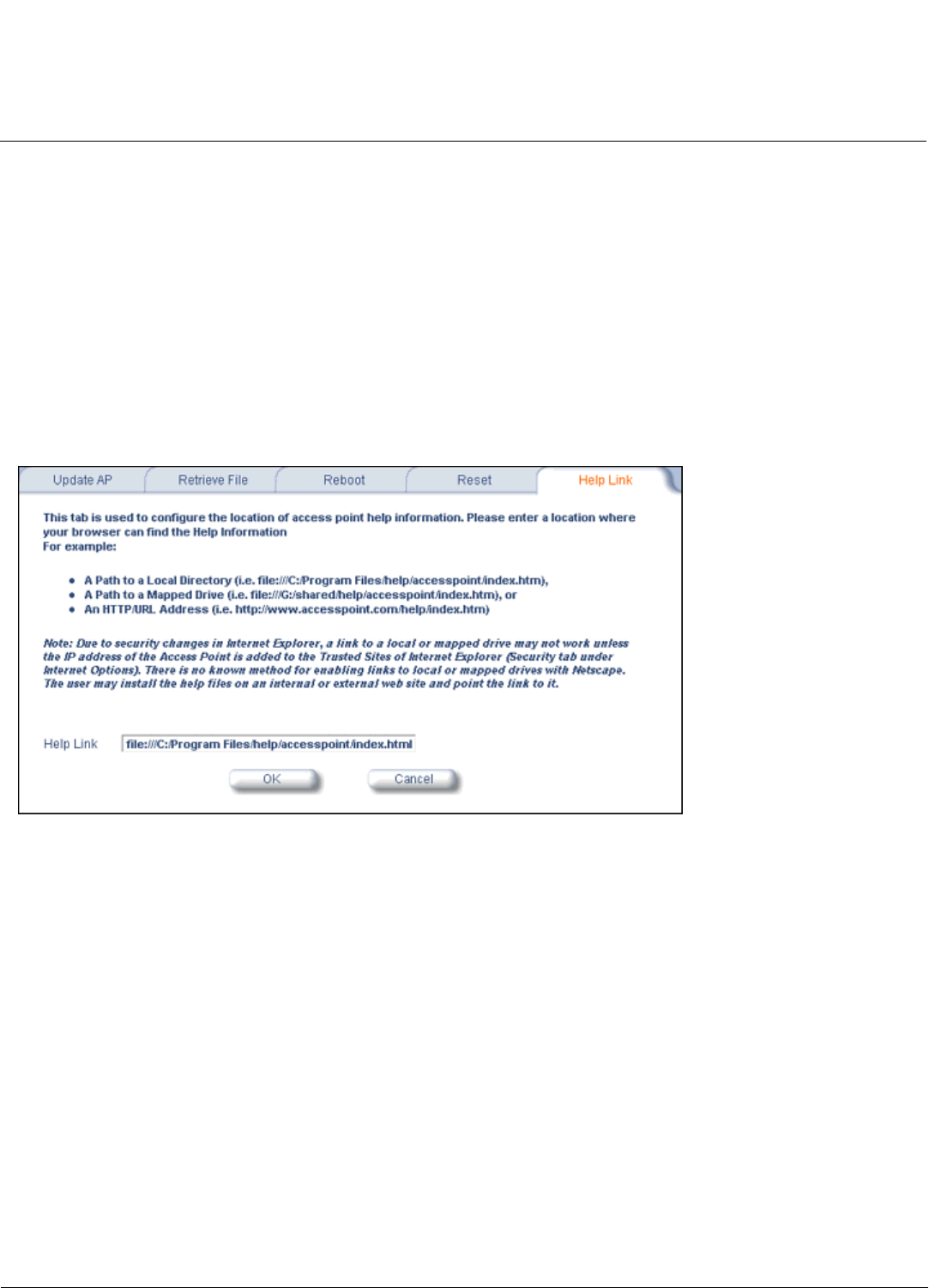
Commands AP-700 User Guide
Help Link
148
Help Link
Use the Help tab to configure the location of the AP Help files.
During initialization, the AP on-line help files are downloaded to the default location:
C:/Program Files/ORiNOCO/AP700/HTML/index.htm.
To enable the Help button on each page of the Web interface to access the help files, however, copy the entire Help
folder to a web server, then specify the new HTTP path in the Help Link box.
NOTE: The configured Help Link must point to an HTTP address in order to enable the Help button on each page of the
Web interface.
NOTE: Use the forward slash character ("/") rather than the backslash character ("\") when configuring the Help Link
location.
NOTE: Add the AP’s management IP address into the Internet Explorer list of Trusted Sites.
Figure 6-13 Help Link Configuration Screen

149
AP-700 User Guide
7
Troubleshooting
This chapter provides information on the following:
•Troubleshooting Concepts
•Symptoms and Solutions
•Recovery Procedures
•Related Applications
NOTE: This section helps you locate problems related to the AP device setup. For details about RADIUS, TFTP, serial
communication programs (such as HyperTerminal), Telnet applications, or web browsers, please see the
documentation that came with the respective application for assistance.
Troubleshooting Concepts
The following list identifies important troubleshooting concepts and topics. The most common initialization and
installation problems relate to IP addressing. For example, you must have valid IP addresses for both the AP and the
management computer to access the unit’s HTTP interface.
•IP Address management is fundamental.
•Factory default units are set for “Dynamic” (DHCP) IP Address assignment. The default IP address for the AP is
169.254.128.132 if your network does not have a DHCP server. If you connect the AP to a network with an active
DHCP server, then use ScanTool to locate the IP address of your unit. If a DHCP server is not active on your subnet,
then use ScanTool to assign a static IP address to the unit.
•The Trivial File Transfer Protocol (TFTP) provides a means to download and upload files. These files include
the AP Image (executable program) and configuration files.
•If the AP password is lost or forgotten, you will need to reset to default values. The Soft Reset to Factory
Defaults or Hard Reset to Factory Defaults procedures reset the configuration, but do not change the current AP
Image.
•The AP Supports a Command Line Interface (CLI). If you are having trouble locating your AP on the network,
connect to the unit directly using the serial interface and see Command Line Interface (CLI) for CLI command syntax
and parameter names.
•ScanTool does not work over routers. You must be connected to the same subnet/physical LAN segment to use
ScanTool. Note that ScanTool also works over the wireless interface; you can run it on a wireless client connected to
the target AP or an AP connected to the same LAN segment/subnet.
•If all else fails… Use the Forced Reload procedure to erase the current AP Image and configuration file and then
download a new image.

Troubleshooting AP-700 User Guide
Symptoms and Solutions
150
Symptoms and Solutions
Connectivity Issues
Connectivity issues include any problem that prevents you from powering up or connecting to the AP.
AP Unit Will Not Boot - No LED Activity
1. Make sure your power source is operating.
2. Make sure all cables are connected to the AP correctly.
3. If you are using PoE, make sure you are using a Category 5, foiled, twisted pair cable to power the AP.
Serial Link Does Not Work
1. Make sure you are using a standard, straight-through, 9-pin serial cable.
2. Double-check the physical network connections.
3. Make sure your PC terminal program (such as HyperTerminal) is active and configured to the following values:
– Com Port: (COM1, COM2, etc. depending on your computer);
– Baud rate: 9600; Data bits: 8; Stop bits: 1; Flow Control: None; Parity: None;
– Line Feeds with Carriage Returns
(In HyperTerminal select: File > Properties > Settings > ASCII Setup > Send Line Ends with Line Feeds)
Ethernet Link Does Not Work
1. Double-check the physical network connections. Use a known-good unit to make sure the network connection is
present. Once you have the AP IP address, you can use the “Ping” command over Ethernet to test the IP Address. If
the AP responds to the Ping, then the Ethernet Interface is working properly.
2. By default, the Access Point will attempt to automatically detect the Ethernet settings. However, if you are having
problems with the Ethernet link, manually configure the Access Point’s Ethernet settings. For example, if your switch
operates at 100 Mbits/sec/Full Duplex, manually configure the Access Point to use these settings (see Ethernet). If
you cannot access the unit over Ethernet, then use the CLI interface over the serial port to configure the Ethernet port
(see Command Line Interface (CLI) and Set Ethernet Speed and Transmission Mode).
3. Perform network infrastructure troubleshooting (check switches, routers, etc.).
Basic Software Setup and Configuration Problems
Lost AP, Telnet, or SNMP Password
1. Perform the Soft Reset to Factory Defaults in this guide. This procedure resets system and network parameters, but
does not affect the AP Image. The default AP HTTP, Telnet, and SNMP passwords are all public.
Client Computer Cannot Connect
1. Client computers should have the same Network Name and security settings as the AP.
2. Network Names should be allocated and maintained by the Network Administrator.
3. See the documentation that came with your client card for additional troubleshooting suggestions.
AP Has Incorrect IP Address
1. Default IP Address Assignment mode is dynamic (DHCP). If you do not have a DHCP server on your network, the
default IP Address is 169.254.128.132. If you have more than one unintialized AP connected to the network, they will
all have the same default IP address and you will not be able to communicate with them (due to an IP address
conflict). In this case, assign each AP a static IP address via the serial cable or turn off all units but one and change
the IP address using ScanTool one at a time.

Troubleshooting AP-700 User Guide
Symptoms and Solutions
151
2. The AP only contacts a DHCP server during boot-up. If your network’s DHCP server is not available while the AP is
booting, the device will use the default IP address (169.254.128.132). Reboot the AP once your DHCP server is
on-line again or use the ScanTool to find the Access Point’s current IP address.
3. To find the unit’s current IP address if using DHCP, open the IP Client Table in the DHCP Server and match the
Access Point’s IP address to its MAC address (found on the product label). Alternatively, use ScanTool to identify an
Access Point’s current IP address.
4. Once you have the current IP address, use the HTTP or CLI Interface to change the unit’s IP settings, if necessary.
5. If you use static IP Address assignments, and cannot access the unit over Ethernet, use the Initializing the IP Address
using CLI procedure. Once the IP Address is set, you can use the Ethernet Interface to complete configuration.
6. Perform the Soft Reset to Factory Defaults in this guide. This will reset the unit to “DHCP” mode. If there is a DHCP
Server on the network, the DHCP Server will assign an IP Address to the AP.
HTTP Interface or Telnet Interface Does Not Work
1. Make sure you are using a compatible browser:
– Microsoft Internet Explorer 6 with Service Pack 1 or later
– Netscape 7.1 or later
2. Make sure you have the proper IP address. Enter your Access Point’s IP Address in the browser address bar, similar
to this example:
http://192.168.1.100
When the Enter Network Password window appears, leave the User Name field empty and enter the HTTP
password in the Password field. The default HTTP password is public.
3. Use the CLI over the serial port to check the IP Access Table, which can be restricting access to Telnet and HTTP.
HTML Help Files Do Not Appear
1. Verify that the HTML Help files are installed in the default directory:
C:/Program Files/ORiNOCO/AP700/HTML.
If the Help files are not located in this folder, contact your network administrator to find out where the Help files are
located on your server.
2. Copy the entire folder to your Web server.
3. Perform the following steps to specify the path for the Help files:
a. Click the Commands button in the HTTP interface.
b. Select the Help tab located at the top of the screen.
c. Enter the pathname where the Help files are located in the Help Link box. This must be an HTTP address.
d. Click OK.
Telnet CLI Does Not Work
1. Make sure you have the proper IP Address. Enter your AP IP address in the Telnet connection dialog, from a DOS
prompt, type:
C:\> telnet <AP IP Address>
2. Use the CLI over the serial port to check the IP Access Table, which can be restricting access to Telnet and HTTP.
TFTP Server Does Not Work
1. Make sure the TFTP Server has been started.
2. Verify the IP address of the TFTP Server. The server may be local or remote, so long as it has a valid IP address.
3. Configure the TFTP Server to “point” to the folder containing the file to be downloaded (or to the folder in which the file
is to be uploaded).
4. Verify that you have entered the proper AP Image file name (including the file extension) and directory path (if
needed).

Troubleshooting AP-700 User Guide
Symptoms and Solutions
152
5. If you have a problem uploading a file, verify that the TFTP server is configured to allow uploads (typically the default
setting is to allow only downloads).
Client Connection Problems
Client Software Finds No Connection
Make sure you have configured your client software with the proper Network Name and Security settings. Network
Names and WEP Keys are typically allocated and maintained by your network administrator.
Client PC Card Does Not Work
1. Make sure you are using the latest PC Card driver software.
2. Download and install the latest ORiNOCO client software from http://support.proxim.com.
Intermittent Loss of Connection
1. Make sure you are within range of an active AP.
2. You can check the signal strength using the signal strength gauge on your client software.
Client Does Not Receive an IP Address - Cannot Connect to Internet
1. If the AP is configured as a DHCP server, open the Web-browser Interface and select the Configure button and then
the Network tab to make sure the proper DHCP settings are being used.
2. If you are not using the DHCP server feature on the AP, then make sure that your local DHCP server is accessible
from the Access Point’s subnet.
3. If using PoE, make sure you are not using a crossover Ethernet cable between the AP and the hub.
VLAN Operation Issues
Verifying Proper Operation of the VLAN Feature
The correct VLAN configuration can be verified by “pinging” both wired and wireless hosts from both sides of the AP
device and the network switch. Traffic can be “sniffed” on both the wired (Ethernet) and wireless (WDS) backbones (if
configured). Bridge frames generated by wireless clients and viewed on one of the backbones should contain IEEE
802.1Q compliant VLAN headers or tags. The VLAN ID in the headers should correspond to one of the VLAN User IDs
configured for the AP.
NOTE: The AP-700 supports 16 VLAN/SSID pairs, each with a configured security profile.
VLAN Workgroups
The correct VLAN assignment can be verified by pinging the AP to ensure connectivity, by pinging the switch to ensure
VLAN properties, and by pinging hosts past the switch to confirm the switch is functional. Ultimately, traffic can be
“sniffed” on the Ethernet or WDS interfaces (if configured) using third-party packages. Most problems can be avoided by
ensuring that 802.1Q compliant VLAN tags containing the proper VLAN ID have been inserted in the bridged frames. The
VLAN ID in the header should correspond to the user’s assigned network name.
What if network traffic is being directed to a nonexistent host?
• All sessions are disconnected, traffic is lost, and a Forced Reload is necessary.
• Workaround: you can configure the switch to mimic the nonexistent host.
I have just configured the Management ID and now I can't manage the AP?
• Check to ensure your password is correct. If your password is incorrect or all inbound packets do NOT have the
correct tag, then a Forced Reload is necessary.

Troubleshooting AP-700 User Guide
Symptoms and Solutions
153
CAUTION: The Forced Reload procedure disconnects all users and resets all values to factory defaults.
Power-Over-Ethernet (PoE)
The AP Does Not Work
1. Verify that you are using a standard UTP Category 5 cable.
2. Try a different port on the same PoE hub (remember to move the input port accordingly) – if it works, there is probably
a faulty port or bad RJ-45 port connection.
3. If possible, try to connect the AP to a different PoE hub.
4. Try using a different Ethernet cable – if it works, there is probably a faulty connection over the long cable, or a bad
RJ-45 connection.
5. Check power plug and hub.
6. If the Ethernet link goes down, check the cable, cable type, switch, and hub.
There Is No Data Link
1. Verify that the indicator for the port is “on.”
2. Verify that the PoE hub is connected to the Ethernet network with a good connection.
3. Verify that the Ethernet cable is Category 5 or better and is less than 100 meters (approximately 325 feet) in length
from the Ethernet source to the AP.
4. Try to connect a different device to the same port on the PoE hub – if it works and a link is established, there is
probably a faulty data link in the AP.
5. Try to re-connect the AP to a different output port (remember to move the input port accordingly) – if it works, there is
probably a faulty output or input port in the PoE hub or a bad RJ-45 connection.
“Overload” Indications
1. Verify that you are not using a cross-over cable between the PoE output port and the AP.
2. Verify that there is no short over any of the twisted pair cables.
3. Move the device into a different output port (remember to move the input port accordingly); if it works, there is
probably a faulty port or bad RJ-45 connection.

Troubleshooting AP-700 User Guide
Recovery Procedures
154
Recovery Procedures
The most common installation problems relate to IP addressing. For example, without the TFTP server IP Address, you
will not be able to download a new AP Image to the AP. IP Address management is fundamental. We suggest you create
a chart to document and validate the IP addresses for your system.
If the password is lost or forgotten, you will need to reset the AP to default values. The Soft Reset to Factory Defaults and
Hard Reset to Factory Defaults procedures reset configuration settings, but do not change the current AP Image.
If the AP has a corrupted software image, follow the Forced Reload procedure to erase the current AP Image and
download a new image.
Soft Reset to Factory Defaults
Use this procedure to reset the network configuration values, including the password, IP address, and subnet mask. The
current AP Image is not deleted.
1. Click Commands > Reset.
2. Click Reset to Factory Default; the device is reset to its factory default state.
3. If not using DHCP, use the ScanTool or use CLI over a serial connection to set the IP address, subnet mask, and other
IP parameters. See Command Line Interface (CLI) for CLI information.
If you do not have access to the HTTP or CLI interfaces, use the procedure described in Hard Reset to Factory Defaults.
Hard Reset to Factory Defaults
If you cannot access the unit or you have lost its password, you can reset the unit to the factory default settings using the
Reload button on the unit, as described below.
1. Using the end of a paper clip or pin, depress and hold the Reload button on the back of the unit for a minimum of 5
seconds but no more than 10 seconds. The configuration is deleted from the unit and the unit reboots, using a factory
default configuration.
NOTE: You need to use a pin or the end of a paperclip to press the button.
CAUTION: If you hold the Reload button for longer than 20 seconds, you may go into Forced Reload mode, which
erases the unit’s embedded software. This software must be reloaded through an Ethernet connection
with access to a TFTP server. See Forced Reload below for instructions.
2. If not using DHCP, use the ScanTool or use CLI over a serial connection to set the IP address, subnet mask, and other
IP parameters. See Command Line Interface (CLI) for CLI information.
Forced Reload
With Forced Reload, you bring the unit into bootloader mode by erasing the embedded software. Use this procedure only
as a last resort if the unit does not boot and the procedure did not help.
CAUTION: By completing this procedure, the embedded software in the AP will be erased. You will need to reload the
software before the unit is operational.
To do a forced reload:
1. While the unit is running, use a pin or the end of a paperclip to press the RESET button.
The AP reboots and the indicators begin to flash.
2. Press and hold the RELOAD button for about 20 seconds until the POWER LED turns amber.
The AP deletes the current AP Image.
3. Follow one of the procedures below to load a new AP Image to the Access Point:
–Download a New Image Using ScanTool

Troubleshooting AP-700 User Guide
Recovery Procedures
155
–Download a New Image Using the Bootloader CLI
Because the CLI option requires a physical connection to the unit’s serial port, Proxim recommends the ScanTool
option.
Download a New Image Using ScanTool
To download the AP Image, you will need an Ethernet connection to the computer on which the TFTP server resides and
to a computer that is running ScanTool (this is either two separate computers connected to the same network or a single
computer running both programs).
ScanTool detects if an Access Point does not have a valid software image installed. In this case, the TFTP Server and
Image File Name parameters are enabled in the ScanTool’s Change screen so you can download a new image to the
unit. (These fields are grayed out if ScanTool does not detect a software image problem.)
Preparing to Download the AP Image
Before starting, you need to know the Access Point’s IP address, subnet mask, the TFTP Server IP Address, and the AP
Image file name. Make sure the TFTP server is running and configured to point to the folder containing the image to be
downloaded.
Download Procedure
Follow these steps to use ScanTool to download a software image to an Access Point with a missing image:
1. Download the latest software from http://support.proxim.com. See Download the Software for more detailed
instructions.
1. Copy the latest software updates to your TFTP server.
2. Launch ScanTool.
3. Highlight the entry for the AP you want to update and click Change.
4. Set IP Address Type to Static.
NOTE: You need to assign static IP information temporarily to the Access Point since its DHCP client functionality is not
available when no image is installed on the device.
5. Enter an unused IP address that is valid on your network in the IP Address field. You may need to contact your
network administrator to get this address.
6. Enter the network’s Subnet Mask in the field provided.
7. Enter the network’s Gateway IP Address, if necessary. You may need to contact your network administrator to get
this address. You should only need to enter the default gateway address (169.254.128.133) if the Access Point and
the TFTP server are separated by a router.
8. Enter the IP address of your TFTP server in the field provided.
9. Enter the Image File Name (including the file extension). Enter the full directory path and file name. If the file is
located in the default TFTP directory, you need enter only the file name.
10.Click OK.
The Access Point will reboot and the download will begin automatically. You should see downloading activity begin
after a few seconds within the TFTP server’s status screen.
11.Click OK when prompted that the device has been updated successfully to return to the Scan List screen.
12.Click Cancel to close the ScanTool.
13.When the download process is complete, configure the AP.
Download a New Image Using the Bootloader CLI
To download the AP Image, you will need an Ethernet connection to the computer on which the TFTP server resides.
This can be any computer on the LAN or connected to the AP with a cross-over Ethernet cable.

Troubleshooting AP-700 User Guide
Recovery Procedures
156
You must also connect the AP to a computer with a standard serial cable and use a terminal client, such as
HyperTerminal. From the terminal, enter CLI Commands to set the IP address and download an AP Image.
Preparing to Download the AP Image
Before starting, you need to know the Access Point’s IP address, subnet mask, the TFTP Server IP Address, and the AP
Image file name. Make sure the TFTP server is running and configured to point to the folder containing the image to be
downloaded.
Download Procedure
1. Download the latest software from http://support.proxim.com. See Download the Software for more detailed
instructions.
2. Copy the latest software updates to your TFTP server’s default directory.
3. Use a straight-through serial cable to connect the Access Point’s serial port to your computer’s serial port.
4. Open your terminal emulation program (like HyperTerminal) and set the following connection properties:
• Com Port: <COM1, COM2, etc., depending on your computer>
• Baud rate: 9600
•Data Bits: 8
• Stop bits: 1
• Flow Control: None
• Parity: None
5. Under File > Properties > Settings > ASCII Setup, enable the Send line ends with line feeds option.
HyperTerminal sends a line return at the end of each line of code.
6. Press the RESET button on the AP.
The terminal display shows Power On Self Tests (POST) activity. After approximately 30 seconds, a message
indicates: Sending Traps to SNMP manager periodically. After this message appears, press the ENTER key
repeatedly until the following prompt appears:
[Device name]>
7. Enter only the following statements:
[Device name]> show (to view configuration parameters and values)
[Device name]> set ipaddrtype static
[Device name]> set ipaddr <Access Point IP Address>
[Device name]> set ipsubmask <IP Mask>
[Device name]> set tftpipaddr <TFTP Server IP Address>
[Device name]> set tftpfilename <AP Image File Name, including file extension>
[Device name]> set ipgw <Gateway IP Address>
[Device name]> show (to confirm your new settings)
[Device name]> reboot
Example:
[Device name]> show
[Device name]> set ipaddrtype static
[Device name]> set ipaddr 10.0.0.12
[Device name]> set ipsubmask 255.255.255.0
[Device name]> set tftpipaddr 10.0.0.20
[Device name]> set tftpfilename MyImage.bin
[Device name]> set ipgw 10.0.0.30

Troubleshooting AP-700 User Guide
Recovery Procedures
157
[Device name]> show
[Device name]> reboot
The AP will reboot and then download the image file. You should see downloading activity begin after a few seconds
within the TFTP server’s status screen.
8. When the download process is complete, configure the AP.
Setting IP Address using Serial Port
Use the following procedure to set an IP address over the serial port using the CLI. The network administrator typically
provides the AP IP address.
Hardware and Software Requirements
• Standard straight-through serial data (RS-232) cable (not included with shipment).
• ASCII Terminal software, such as HyperTerminal.
Attaching the Serial Port Cable
1. Connect one end of the serial cable to the AP and the other end to a serial port on your computer.
2. Power on the computer and AP, if necessary.
Initializing the IP Address using CLI
After installing the serial port cable, you may use the CLI to communicate with the AP. CLI supports most generic terminal
emulation programs, such as HyperTerminal (which is included with the Windows operating systems). In addition, many
web sites offer shareware or commercial terminal programs you can download. Once the IP address has been assigned,
you can use the HTTP interface or the CLI over Telnet to complete configuration.
Follow these steps to assign the AP an IP address:
1. Open your terminal emulation program (like HyperTerminal) and set the following connection properties:
• Com Port: <COM1, COM2, etc., depending on your computer>
• Baud rate: 9600
•Data Bits: 8
• Stop bits: 1
• Flow Control: None
• Parity: None
2. Under File > Properties > Settings > ASCII Setup, enable the Send line ends with line feeds option.
HyperTerminal sends a line return at the end of each line of code.
3. Press the RESET button on the AP.
The terminal display shows Power On Self Tests (POST) activity, and then displays a CLI prompt, similar to the
example below. This process may take up to 90 seconds.
[Device name]> Please enter password:
4. Enter the CLI password (default is public).
The terminal displays a welcome message and then the CLI Prompt:
[Device name]>
5. Enter show ip. Network parameters appear:

Troubleshooting AP-700 User Guide
Recovery Procedures
158
Figure 7-1 Result of “show ip” CLI Command
6. Change the IP address and other network values using set and reboot CLI commands, similar to the example below
(use your own IP address and subnet mask). Note that IP Address Type is set to Dynamic by default. If you have a
DHCP server on your network, you should not need to manually configure the Access Point’s IP address; the Access
Point will obtain an IP address from the network’s DHCP server during boot-up.
After each entry the CLI reminds you to reboot; however wait to reboot until all commands have been entered.
[Device name]> set ipaddrtype static
[Device name]> set ipaddr <IP Address>
[Device name]> set ipsubmask <IP Subnet Mask>
[Device name]> set ipgw <Default Gateway IP Address>
[Device name]> show ip (to confirm your new settings)
[Device name]> reboot 0
7. After the AP reboots, verify the new IP address by reconnecting to the CLI and enter a show ip command.
Alternatively, you can ping the AP from a network computer to confirm that the new IP address has taken effect.
8. When the proper IP address is set, use the HTTP interface or CLI over Telnet to configure the rest of the unit’s
operating parameters.

Troubleshooting AP-700 User Guide
Related Applications
159
Related Applications
RADIUS Authentication Server
If you enabled RADIUS Authentication on the AP, make sure that your network’s RADIUS servers are operational.
Otherwise, clients will not be able to log in. There are several reasons the authentication server services might be
unavailable, here are two typical things to check:
• Make sure you have the proper RADIUS authentication server information setup configured in the AP. Check the
RADIUS Authentication Server’s Shared Secret and Destination Port number (default is 1812; for RADIUS
Accounting, the default is 1813).
• Make sure the RADIUS authentication server RAS setup matches the AP.
TFTP Server
The “Trivial File Transfer Protocol” (TFTP) server allows you to transfer files across a network. You can upload
configuration files from the AP for backup or copying, and you can download configuration files or new software images.
The TFTP software is located on the installation CD.
If a TFTP server is not configured and running, you will not be able to download and upload images and configuration
files to/from the AP. Remember that the TFTP server does not have to be local, so long as you have a valid TFTP IP
address. Note that you do not need a TFTP server running unless you want to transfer files to or from the AP.
After the TFTP server is installed:
• Check to see that TFTP is configured to point to the directory containing the AP Image.
• Make sure you have the proper TFTP server IP Address, the proper AP Image file name, and that the TFTP server is
connected.
• Make sure the TFTP server is configured to both Transmit and Receive files (on the TFTP server’s Security tab), with
no automatic shutdown or time-out (on the Auto Close tab).

160
AP-700 User Guide
A
Command Line Interface (CLI)
This section discusses the following:
•General Notes
•Command Line Interface (CLI) Variations
•CLI Command Types
•Using Tables and Strings
•Configuring the AP using CLI commands
•CLI Monitoring Parameters
•Parameter Tables
•CLI Batch File
CLI commands can be used to initialize, configure, and manage the Access Point.
• CLI commands may be entered in real time through a keyboard or submitted with CLI scripts.
•A CLI Batch file is a user-editable configuration file that provides a user-friendly way to change the AP configuration
through a file upload. The CLI Batch file is an ASCII file that facilitates Auto Configuration because it does not require
the user to access one of the AP’s management interfaces to make configuration changes as is required with the
proprietary LTV format configuration file.
• The CLI is available through both the Serial Port interface and over the Ethernet interface using Telnet.
NOTE: All CLI commands and parameters are case-sensitive.

Command Line Interface (CLI) AP-700 User Guide
General Notes
161
General Notes
Prerequisite Skills and Knowledge
To use this document effectively, you should have a working knowledge of Local Area Networking (LAN) concepts,
network access infrastructures, and client-server relationships. In addition, you should be familiar with software setup
procedures for typical network operating systems and servers.
Notation Conventions
• Computer prompts are shown as constant width type. For example: [Device-Name]>
• Information that you input as shown is displayed in bold constant width type. For example:
[Device name]> set ipaddr 10.0.0.12
• The names of keyboard keys, software buttons, and field names are displayed in bold type. For example: Click the
Configure button.
• Screen names are displayed in bold italics. For example, the System Status screen.
Important Terminology
• Configuration Files - Database files containing the current Access Point configuration. Configuration items include the
IP Address and other network-specific values. Config files may be downloaded to the Access Point or uploaded for
backup or troubleshooting.
• Download vs. Upload - Downloads transfer files to the Access Point. Uploads transfer files from the Access Point. The
TFTP server performs file transfers in both directions.
• Group - A logical collection of network parameter information. For example, the System Group is composed of several
related parameters. Groups can also contain Tables. All items for a given Group can be displayed with a show
<Group> CLI Command.
• Image File - The Access Point software executed from RAM. To update an Access Point you typically download a new
Image File. This file is often referred to as the “AP Image”.
• Parameter - A fundamental network value that can be displayed and may be changeable. For example, the Access
Point must have a unique IP Address and the Wireless interface must be assigned an SSID. Change parameters with
the CLI set Command, and view them with the CLI show Command.
• Table - Tables hold parameters for several related items. For example, you can add several potential managers to the
SNMP Table. All items for a given Table can be displayed with a show <Table> CLI Command.
• TFTP - Refers to the TFTP Server, used for file transfers.
Navigation and Special Keys
This CLI supports the following navigation and special key functions to move the cursor along the prompt line.
Key Combination Operation
Delete or Backspace Delete previous character
Ctrl-A Move cursor to beginning of line
Ctrl-E Move cursor to end of line
Ctrl-F Move cursor forward one character
Ctrl-B Move cursor back one character
Ctrl-D Delete the character the cursor is on
Ctrl-U Delete all text to left of cursor
Ctrl-P Go to the previous line in the history buffer
Ctrl-N Go to the next line in the history buffer
Ctrl-W Delete the previous word

Command Line Interface (CLI) AP-700 User Guide
General Notes
162
CLI Error Messages
The following table describes the error messages associated with improper inputs or expected CLI behavior.
Tab Complete the command line
? List available commands
Error Message Description
Syntax Error Invalid syntax entered at the command prompt.
Invalid Command A non-existent command has been entered at the command prompt.
Invalid Parameter Name An invalid parameter name has been entered at the command prompt.
Invalid Parameter Value An invalid parameter value has been entered at the command prompt.
Invalid Table Index An invalid table index has been entered at the command prompt.
Invalid Table Parameter An invalid table parameter has been entered at the command prompt.
Invalid Table Parameter Value An invalid table parameter value has been entered at the command prompt.
Read Only Parameter User is attempting to configure a read-only parameter.
Incorrect Password An incorrect password has been entered in the CLI login prompt.
Download Unsuccessful The download operation has failed due to incorrect TFTP server IP Address or file
name.
Upload Unsuccessful The upload operation has failed due to incorrect TFTP server IP Address or file
name.
Key Combination Operation
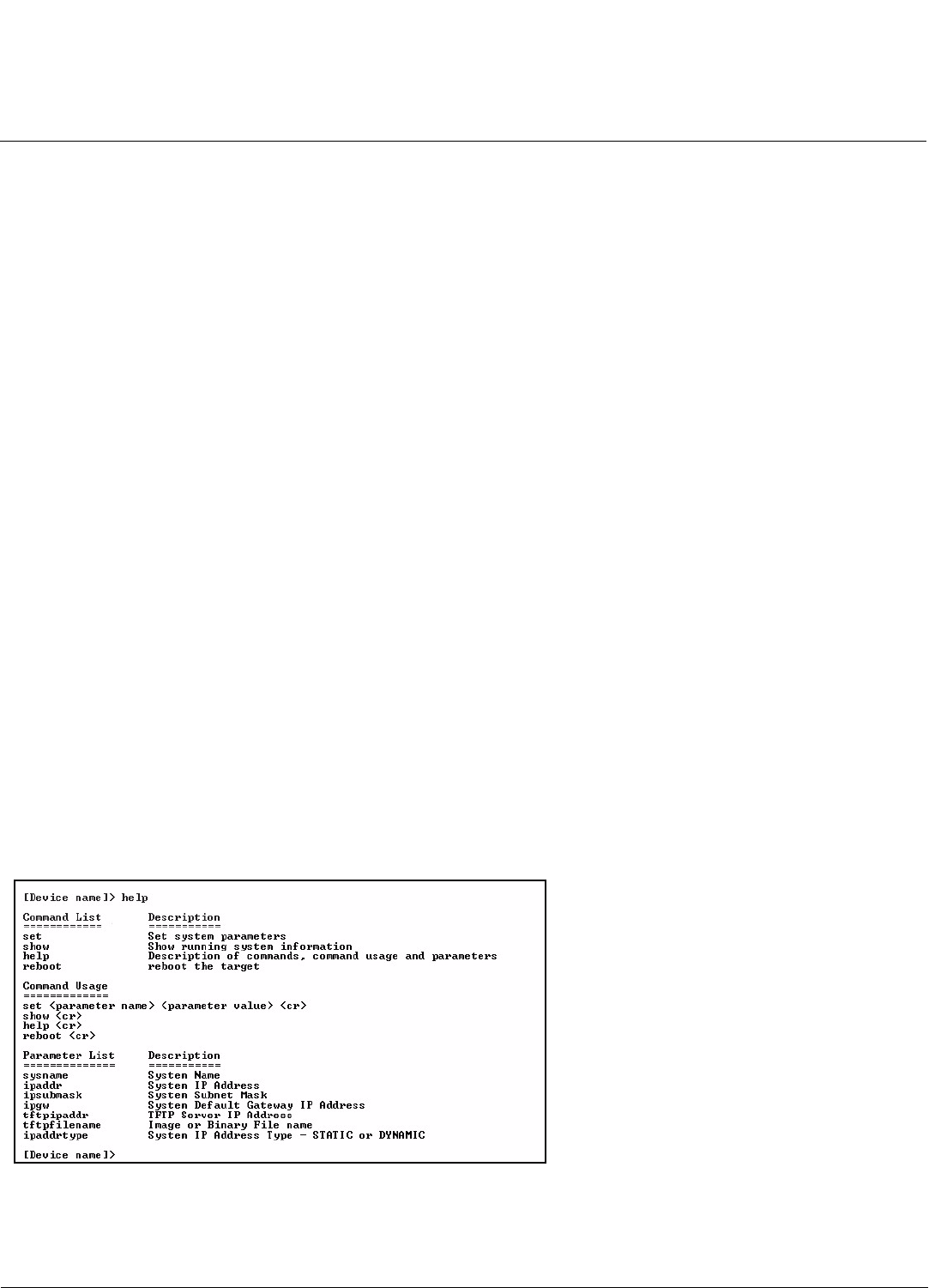
Command Line Interface (CLI) AP-700 User Guide
Command Line Interface (CLI) Variations
163
Command Line Interface (CLI) Variations
Administrators use the CLI to control Access Point operation and monitor network statistics. The AP supports two types
of CLI: the Bootloader CLI and the normal CLI. The Bootloader CLI provides a limited command set, and is used when
the current AP Image is bad or missing. The Bootloader CLI allows you to assign an IP Address and download a new
image. Once the image is downloaded and running, the Access Point uses the normal CLI. This guide covers the normal
CLI unless otherwise specified.
Bootloader CLI
The Bootloader CLI is a minimal subset of the normal CLI used to perform initial configuration of the AP. This interface is
only accessible via the serial interface if the AP does not contain a software image or a download image command over
TFTP has failed.
The Bootloader CLI provides you with the ability to configure the initial setup parameters as well as download a software
image to the device.
The following functions are supported by the Bootloader CLI:
• configuration of initial device parameters using the set command
•show command to view the device’s configuration parameters
•help command to provide additional information on all commands supported by the Bootloader CLI
•reboot command to reboot the device
The parameters supported by the Bootloader CLI (for viewing and modifying) are:
• System Name
• IP Address Assignment Type
• IP Address
•IP Mask
• Gateway IP Address
• TFTP Server IP Address
• Image File Name (including the file extension)
The following lists display the results of using the help command in the Bootloader CLI:
Figure A-1 Results of “help” bootloader CLI command
The following lists display the results of using the show command in the Bootloader CLI:

Command Line Interface (CLI) AP-700 User Guide
Command Line Interface (CLI) Variations
164
Figure A-2 Results of “show” bootloader CLI command

Command Line Interface (CLI) AP-700 User Guide
CLI Command Types
165
CLI Command Types
This guide divides CLI Commands into two categories: Operational and Parameter Controls.
Operational CLI Commands
These commands affect Access Point behavior, such as downloading, rebooting, and so on. After entering commands
(and parameters, if any) press the Enter key to execute the Command Line.
Operational commands include:
•?: Typing a question mark lists CLI Commands or parameters, depending on usage (you do not need to type Enter
after typing this command)
•done, exit, quit: Terminates the CLI session
•download: Uses a TFTP server to download “image” files, “config” files, “bootloader upgrade” files, a “license” file,
“SSL certificates”, “SSL private keys”, “SSH public keys”, “SSH private keys”, or “CLI Batch Files” to the Access Point
•help: Displays general CLI help information or command help information, such as command usage and syntax
•history: Remembers commands to help avoid re-entering complex statements
•passwd: Sets the Access Point’s CLI password
•reboot: Reboots the Access Point in the specified time
•search: Lists the parameters in a specified Table
•upload: Uses TFTP server to upload “config” files from Access Point to TFTP default directory or specified path
? (List Commands)
This command can be used in a number of ways to display available commands and parameters.
The following table lists each operation and provides a basic example. Following the table are detailed examples and
display results for each operation.
Example 1. Display Command list
To display the Command List, enter ?.
[Device-Name]>?
Figure A-3 Result of “?” CLI command
Operation Basic Example
Display the Command List (Example 1) [Device-Name]>?
Display commands that start with specified letters
(Example 2)
[Device-Name]>s?
Display parameters for set and show Commands
(Examples 3a and 3b)
[Device-Name]>set ?
[Device-Name]>show ipa?
Prompt to enter successive parameters for
Commands (Example 4)
[Device-Name]>download ?
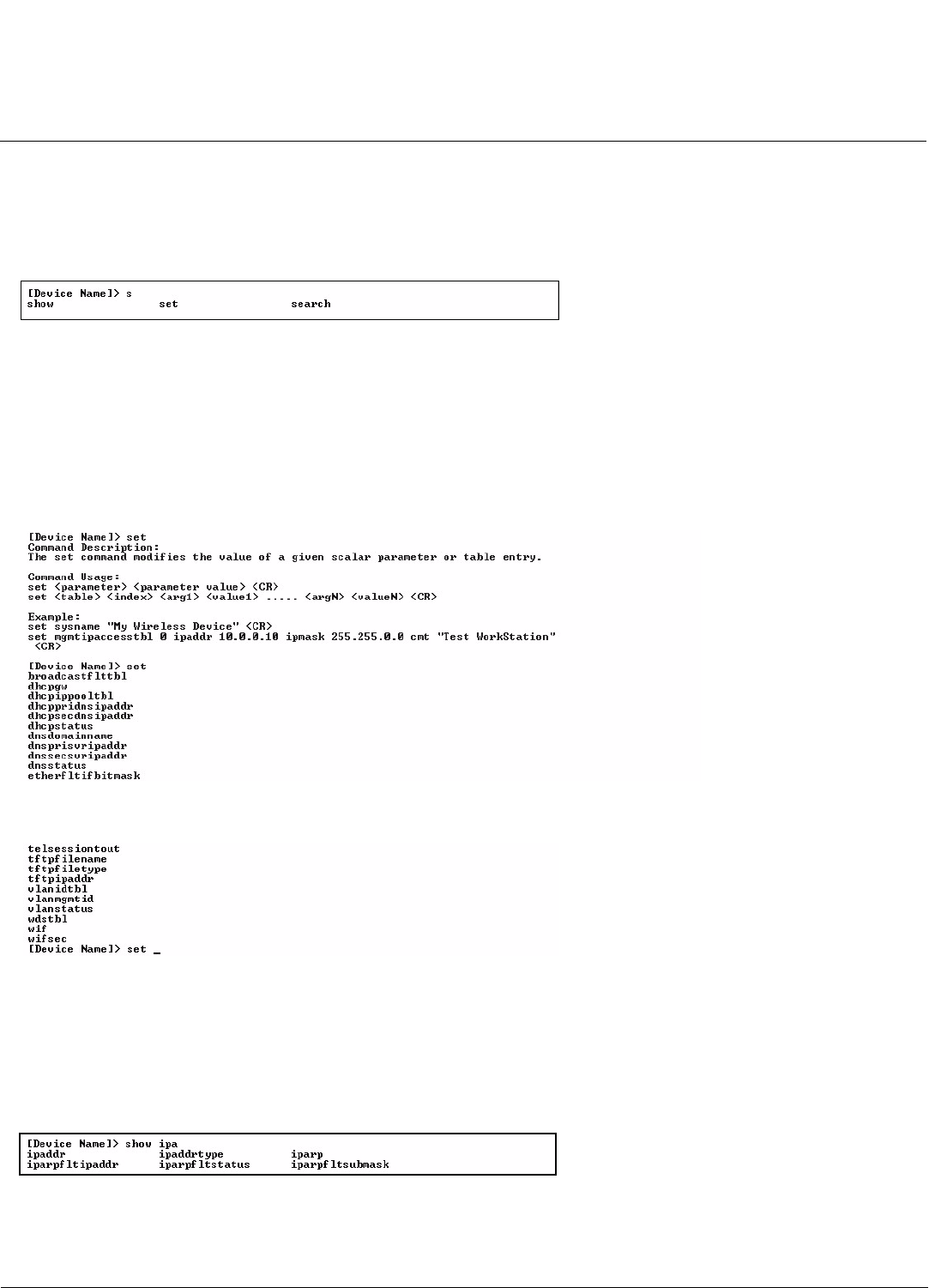
Command Line Interface (CLI) AP-700 User Guide
CLI Command Types
166
Example 2. Display specific Commands
To show all commands that start with specified letters, enter one or more letters, then ? with no space between letters
and ?.
[Device-Name]>s?
Figure A-4 Result of “s?” CLI command
Example 3. Display parameters for set and show
Example 3a allows you to see every possible parameter for the set (or show) commands. Notice from example 3a that
the list is very long. Example 3b shows how to display a subset of the parameters based on initial parameter letters.
Example 3a. Display every parameter that can be changed
[Device-Name]>set ?
Figure A-5 Result of “set ?” CLI command
Example 3b. Display parameters based on letter sequence
This example shows entries for parameters that start with the letter “i”. The more letters you enter, the fewer the results
returned. Notice that there is no space between the letters and the question mark.
[Device-Name]> show ipa?
Figure A-6 Result of “show ipa?” CLI command
[Device-Name]> show iparp?
.
.
.
.

Command Line Interface (CLI) AP-700 User Guide
CLI Command Types
167
Figure A-7 Result of “show iparp?” CLI command
Example 4. Display Prompts for Successive Parameters
Enter the command, a space, and then ?. Then, when the parameter prompt appears, enter the parameter value. The
parameter is changed and a new CLI line is echoed with the new value (in the first part of the following example, the
value is the IP Address of the TFTP server).
After entering one parameter, you may add another ? to the new CLI line to see the next parameter prompt, and so on
until you have entered all of the required parameters. The following example shows how this is used for the download
Command. The last part of the example shows the completed download Command ready for execution.
[Device-Name]> download ?
<TFTP IP Address>
[Device-Name]> download 192.168.0.101 ?
<File Name>
[Device-Name]> download 192.168.0.101 apimage ?
<file type (config/img/bootloader)>
[Device-Name]> download 192.168.0.101 apimage img <CR>
done, exit, quit
Each of the following commands ends a CLI session:
[Device-Name]> done
[Device-Name]> exit
[Device-Name]> quit
download
Downloads the specified file from a TFTP server to the Access Point. Executing download in combination with the
asterisks character (“*”) will make use of the previously set TFTP parameters. Executing download without parameters
will display command help and usage information.
1. Syntax to download a file:
[Device-Name]>download <tftp server address> <path and filename> <file type>
Example:
[Device-Name]>download 192.168.1.100 APImage2 img
2. Syntax to display help and usage information:
[Device-Name]>download
3. Syntax to execute the download Command using previously set (stored) TFTP Parameters:
[Device-Name]>download *
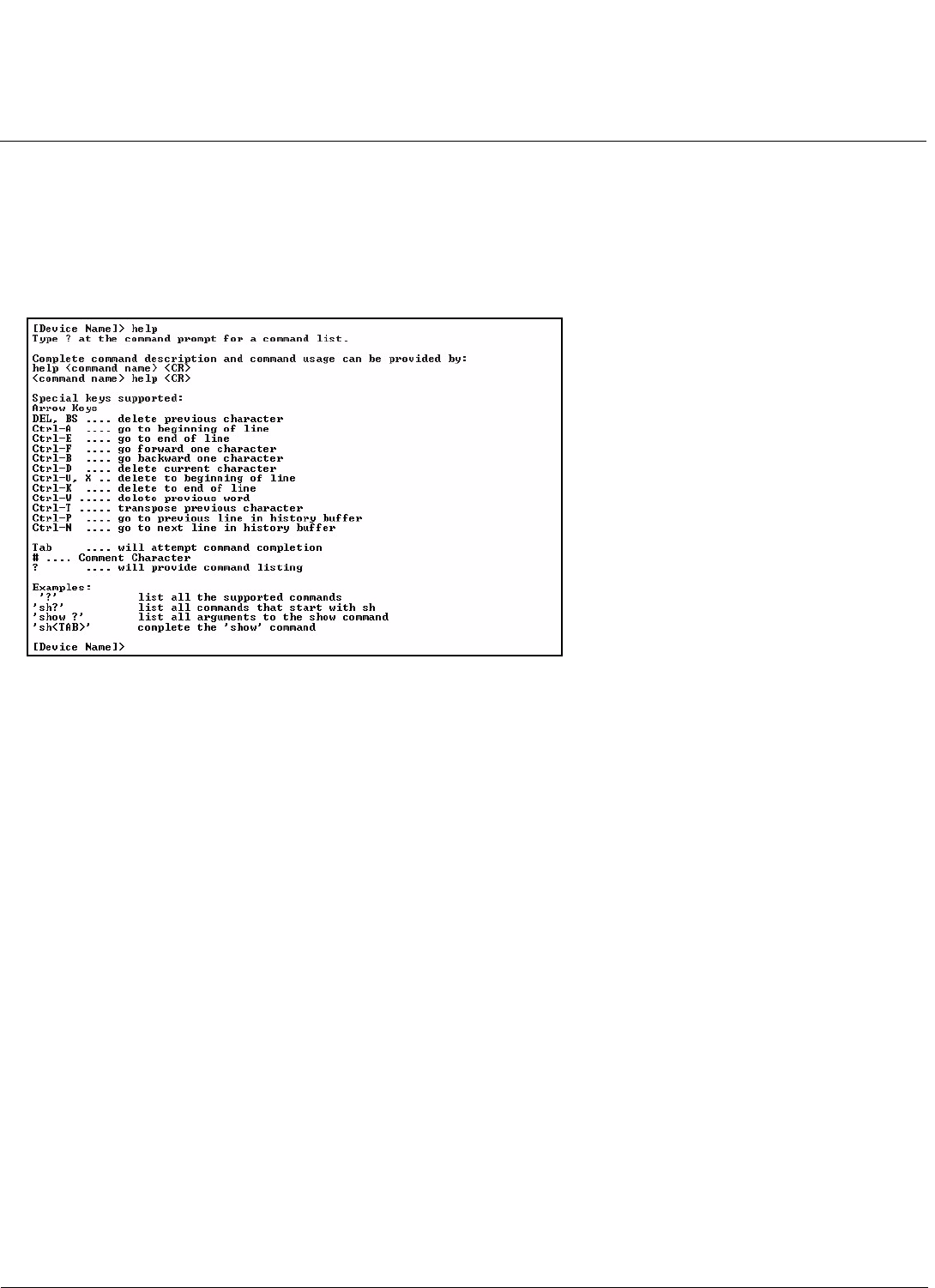
Command Line Interface (CLI) AP-700 User Guide
CLI Command Types
168
help
Displays instructions on using control-key sequences for navigating a Command Line and displays command information
and examples.
1. Using help as the only argument:
[Device-Name]>help
Figure A-8 Results of “help” CLI command
2. Complete command description and command usage can be provided by:
[Device-Name]>help <command name>
[Device-Name]><command name> help
history
Shows content of Command History Buffer. The Command History Buffer stores command statements entered in the
current session. To avoid re-entering long command statements, use the keyboard “up arrow” (Ctrl-P) and “down arrow”
(Ctrl-N) keys to recall previous statements from the Command History Buffer. When the desired statement reappears,
press the Enter key to execute, or you may edit the statement before executing it.
[Device-Name]> history
passwd
Changes the CLI Password.
[Device-Name]> passwd oldpassword newpassword newpassword
reboot
Reboots Access Point after specified number of seconds. Specify a value of 0 (zero) for immediate reboot.
[Device-Name]> reboot 0
[Device-Name]> reboot 30

Command Line Interface (CLI) AP-700 User Guide
CLI Command Types
169
search
Lists the parameters supported by the specified table. This list corresponds to the table information displayed in the
HTTP interface. In this example, the CLI returns the list of parameters that make up an entry in the IP Access Table.
[Device-Name]> search mgmtipaccesstbl
Figure A-9 Results of “search mgmtipaccesstbl” CLI command
upload
Uploads a text-based configuration file from the AP to the TFTP Server. Executing upload with the asterisk character
(“*”) will make use of the previously set/stored TFTP parameters. Executing upload without parameters will display
command help and usage information.
1. Syntax to upload a file:
[Device-Name]>upload <tftp server address> <path and filename> <filetype>
Example:
[Device-Name]>upload 192.168.1.100 APconfig.sys config
2. Syntax to display help and usage information:
[Device-Name]>help upload
3. Syntax to execute the upload command using previously set (stored) TFTP Parameters:
[Device-Name]>upload *
Parameter Control Commands
The following sections cover the two Parameter Control Commands (show and set) and include several tables showing
parameter properties. These commands allow you to view (show) all parameters and statistics and to change (set)
parameters.
•show: To see any Parameter or Statistic value, you can specify a single parameter, a Group, or a Table.
•set: Use this CLI Command to change parameter values. You can use a single CLI statement to modify Tables, or you
can modify each parameter separately.
“show” CLI Command
Displays the value of the specified parameter, or displays all parameter values of a specified group (parameter table).
Groups contain Parameters and Tables. Tables contain parameters for a series of similar entities.
To see a definition and syntax example, type only show and then press the Enter key. To see a list of available
parameters, enter a question mark (?) after show (example: show ?).
Syntax:
[Device-Name]>show <parameter>
[Device-Name]>show <group>
[Device-Name]>show <table>
Examples:
[Device-Name]>show ipaddr

Command Line Interface (CLI) AP-700 User Guide
CLI Command Types
170
[Device-Name]>show network
[Device-Name]>show mgmtipaccesstbl
“set” CLI Command
Sets (modifies) the value of the specified parameter. To see a definition and syntax example, type only set and then press
the Enter key. To see a list of available parameters, enter a space, then a question mark (?) after set (example: set?).
Syntax:
[Device-Name]>set <parameter> <value>
[Device-Name]>set <table> <index> <argument 1> <value 1> ... <argument N> <value N>
Example:
[Device-Name]>set sysloc “Main Lobby”
[Device-Name]>set mgmtipaccesstbl 0 ipaddr 10.0.0.10 ipmask 255.255.0.0
Configuring Objects that Require Reboot
Certain objects supported by the Access Point require a device reboot in order for the changes to take effect. In order to
inform the end-user of this behavior, the CLI provides informational messages when the user has configured an object
that requires a reboot. The following messages are displayed as a result of the configuring such object or objects.
Example 1: Configuring objects that require the device to be rebooted
The following message is displayed every time the user has configured an object that requires the device to be rebooted.
[Device-Name]>set ipaddr 135.114.73.10
The following elements require reboot
ipaddr
Example 2: Executing the “exit”, “quit”, or “done” commands when an object that requires reboot has been
configured
In addition to the above informational message, the CLI also provides a message as a result of the exit, quit, or done
command if changes have been made to objects that require reboot. If you make changes to objects that require reboot
and execute the exit command the following message is displayed:
[Device-Name]>exit<CR> OR quit<CR> OR done<CR>
Modifications have been made to parameters that require the device to be rebooted. These changes will only take effect after the next reboot.
“set” and “show” Command Examples
In general, you will use the CLI show Command to view current parameter values and use the CLI set Command to
change parameter values. As shown in the following examples, parameters may be set individually or all parameters for a
given table can be set with a single statement.
Example 1 - Set the Access Point IP Address Parameter
Syntax:
[Device-Name]>set <parameter name> <parameter value>
Example:
[Device-Name]> set ipaddr 10.0.0.12
IP Address will be changed when you reboot the Access Point. The CLI reminds you when rebooting is required for a
change to take effect. To reboot immediately, enter reboot 0 (zero) at the CLI prompt.

Command Line Interface (CLI) AP-700 User Guide
CLI Command Types
171
Example 2 - Create a table entry or row
Use 0 (zero) as the index to a table when creating an entry. When creating a table row, only the mandatory table elements
are required (comment is usually an optional table element). For optional table elements, the default value is generally
applied if you do not specify a value.
Syntax:
[Device-Name]>set <table name> <table index> <element 1> <value 1> …
<element n> <value n>
Example:
[Device-Name]> set mgmtipaccesstbl 0 ipaddr 10.0.0.10 ipmask 255.255.0.0
A new table entry is created for IP address 10.0.0.10 with a 255.255.0.0 subnet mask.
Example 3 - Modify a table entry or row
Use the index to be modified and the table elements you would like to modify. For example, suppose the IP Access Table
has one entry and you wanted to modify the IP address:
[Device-Name]>set mgmtipaccesstbl 1 ipaddr 10.0.0.11
You can also modify several elements in the table entry. Enter the index number and specific table elements you would
like to modify. (Hint: Use the search Command to see the elements that belong to the table.)
[Device-Name]>set mgmtipaccesstbl 1 ipaddr 10.0.0.12 ipmask 255.255.255.248
cmt “First Row”
Example 4 - Enable, Disable, or Delete a table entry or row
The following example illustrates how to manage the second entry in a table.
Syntax:
[Device-Name]>set <Table> index status <enable, disable, delete>
[Device-Name]>set <Table> index status <1=enable, 2=disable, 3=delete>
Example:
[Device-Name]>set mgmtipaccesstbl 2 status enable
[Device-Name]>set mgmtipaccesstbl 2 status disable
[Device-Name]>set mgmtipaccesstbl 2 status delete
[Device-Name]>set mgmtipaccesstbl 2 status 2
NOTE: You may need to enable a disabled table entry before you can change the entry’s elements.
Example 5 - Show the Group Parameters
This example illustrates how to view all elements of a group or table.
Syntax:
[Device-Name]> show <group name>
Example:
[Device-Name]>show network
The CLI displays network group parameters. Note show network and show ip return the same data.
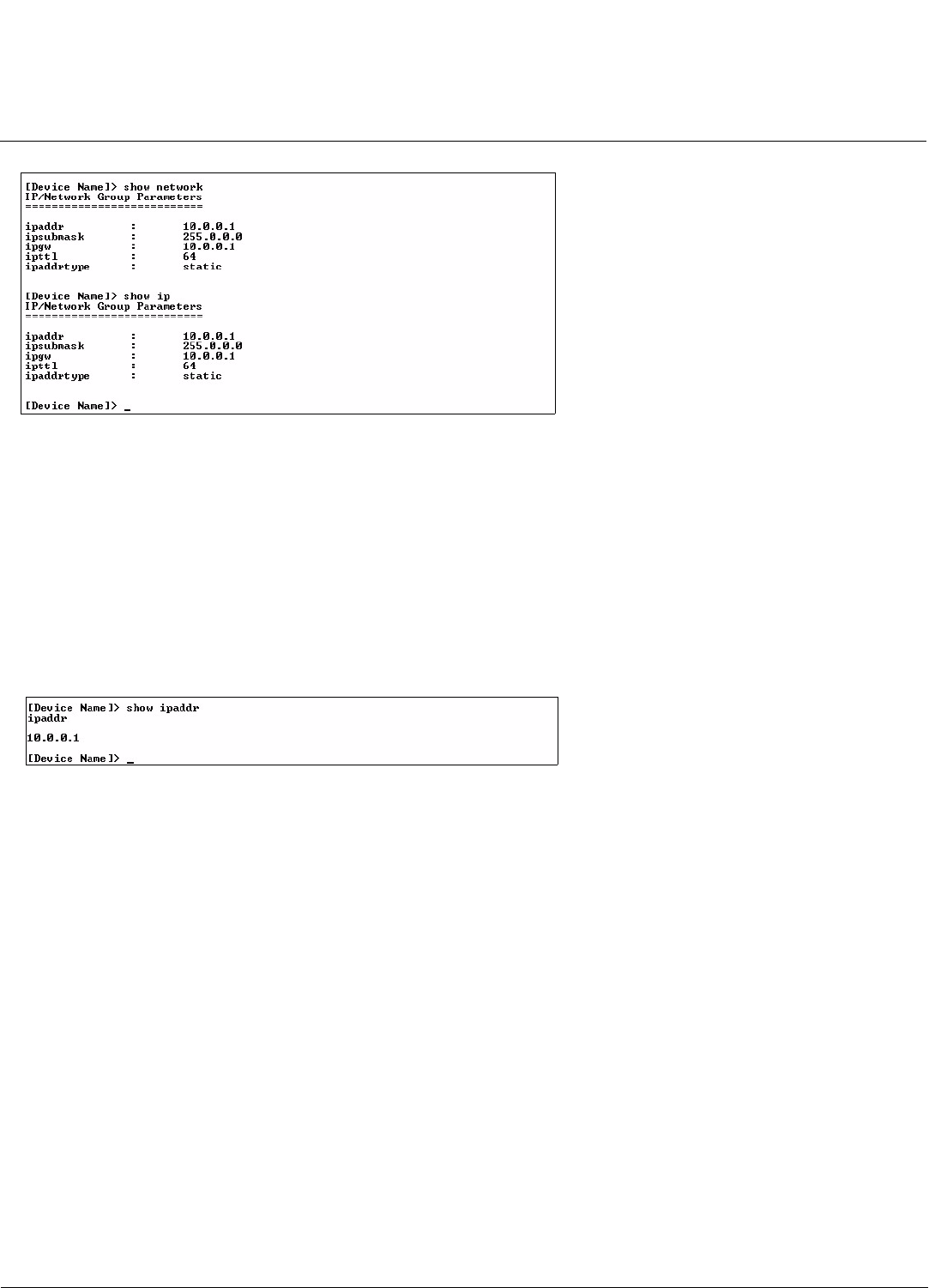
Command Line Interface (CLI) AP-700 User Guide
CLI Command Types
172
Figure A-10 Results of “show network” and “show ip” CLI Commands
Example 6 - Show Individual and Table Parameters
1. View a single parameter.
Syntax:
[Device-Name]>show <parameter name>
Example:
[Device-Name]> show ipaddr
Displays the Access Point IP address.
Figure A-11 Result of “show ipaddr” CLI Command
2. View all parameters in a table.
Syntax:
[Device-Name]> show <table name>
Example: [Device-Name]> show mgmtipaccesstbl
The CLI displays the IP Access Table and its entries.

Command Line Interface (CLI) AP-700 User Guide
Using Tables and Strings
173
Using Tables and Strings
Working with Tables
Each table element (or parameter) must be specified, as in the example below.
[Device-Name]>set mgmtipaccesstbl 0 ipaddr 10.0.0.10 ipmask 255.255.0.0
Below are the rules for creating, modifying, enabling/disabling, and deleting table entries.
•Creation
– The table name is required.
– The table index is required – for table entry/instance creation the index is always zero (0).
– The order in which the table arguments or objects are entered in not important.
– Parameters that are not required can be omitted, in which case they will be assigned the default value.
• Modification
– The table name is required.
– The table index is required – to modify the table, “index” must be the index of the entry to be modified.
– Only the table objects that are to be modified need to be specified. Not all the table objects are required.
– If multiple table objects are to be modified the order in which they are entered is not important.
– If the entire table entry is to be modified, all the table objects have to be specified.
• Enabling/Disabling
– The table name is required.
– The table index is required – for table enabling/disabling the index should be the index of the entry to be
enabled/disabled.
– The entry’s new state (either “enable” or “disable”) is required.
• Deletion
– The table name is required.
– The table index is required – for table deletion the index should be the index of the entry to be deleted.
– The word “delete” is required.
Using Strings
Since there are several string objects supported by the AP, a string delimiter is required for the strings to be interpreted
correctly by the command line parser. For this CLI implementation, the single quote or double quote character can be
used at the beginning and at the end of the string.
For example:
[Device-Name]> set sysloc Lobby - Does not need quote marks
[Device-Name]> set sysloc “Front Lobby” - Requires quote marks.
The scenarios supported by this CLI are:
“My Desk in the office” Double Quotes
‘My Desk in the office’ Single Quotes
“My ‘Desk’ in the office” Single Quotes within Double Quotes
‘My “Desk” in the office’ Double Quotes within Single Quotes
“Daniel’s Desk in the office” One Single Quote within Double Quotes
‘Daniel”s Desk in the office’ One Double Quote within Single Quotes

Command Line Interface (CLI) AP-700 User Guide
Using Tables and Strings
174
The string delimiter does not have to be used for every string object. The single quote or double quote only has to be
used for string objects that contain blank space characters. If the string object being used does not contain blank spaces,
then the string delimiters, single or double quotes, mentioned in this section are not required.

Command Line Interface (CLI) AP-700 User Guide
Configuring the AP using CLI commands
175
Configuring the AP using CLI commands
Log into the AP using HyperTerminal
1. Open your terminal emulation program (like HyperTerminal) and set the following connection properties:
• Com Port: <COM1, COM2, etc., depending on your computer>
• Baud rate: 9600
• Data Bits: 8
• Stop bits: 1
• Flow Control: None
• Parity: None
2. Under File > Properties > Settings > ASCII Setup, enable the Send line ends with line feeds option.
HyperTerminal sends a line return at the end of each line of code.
3. Enter the CLI password (default is public).
NOTE: Proxim recommends changing your default passwords immediately. To perform this operation using CLI
commands, see Change Passwords.
Log into the AP using Telnet
The CLI commands can be used to access, configure, and manage the AP using Telnet. Follow these steps:
1. Confirm that your computer’s IP address is in the same IP subnet as the AP.
NOTE: If you have not previously configured the Access Point’s IP address and do not have a DHCP server on
the network, the Access Point will default to an IP address of 169.254.128.132.
2. Go to the DOS command prompt on your computer.
3. Type telnet <IP Address of the unit>.
4. Enter the CLI password (default is public).
NOTE: Proxim recommends changing your default passwords immediately. To perform this operation using CLI
commands, see Change Passwords.
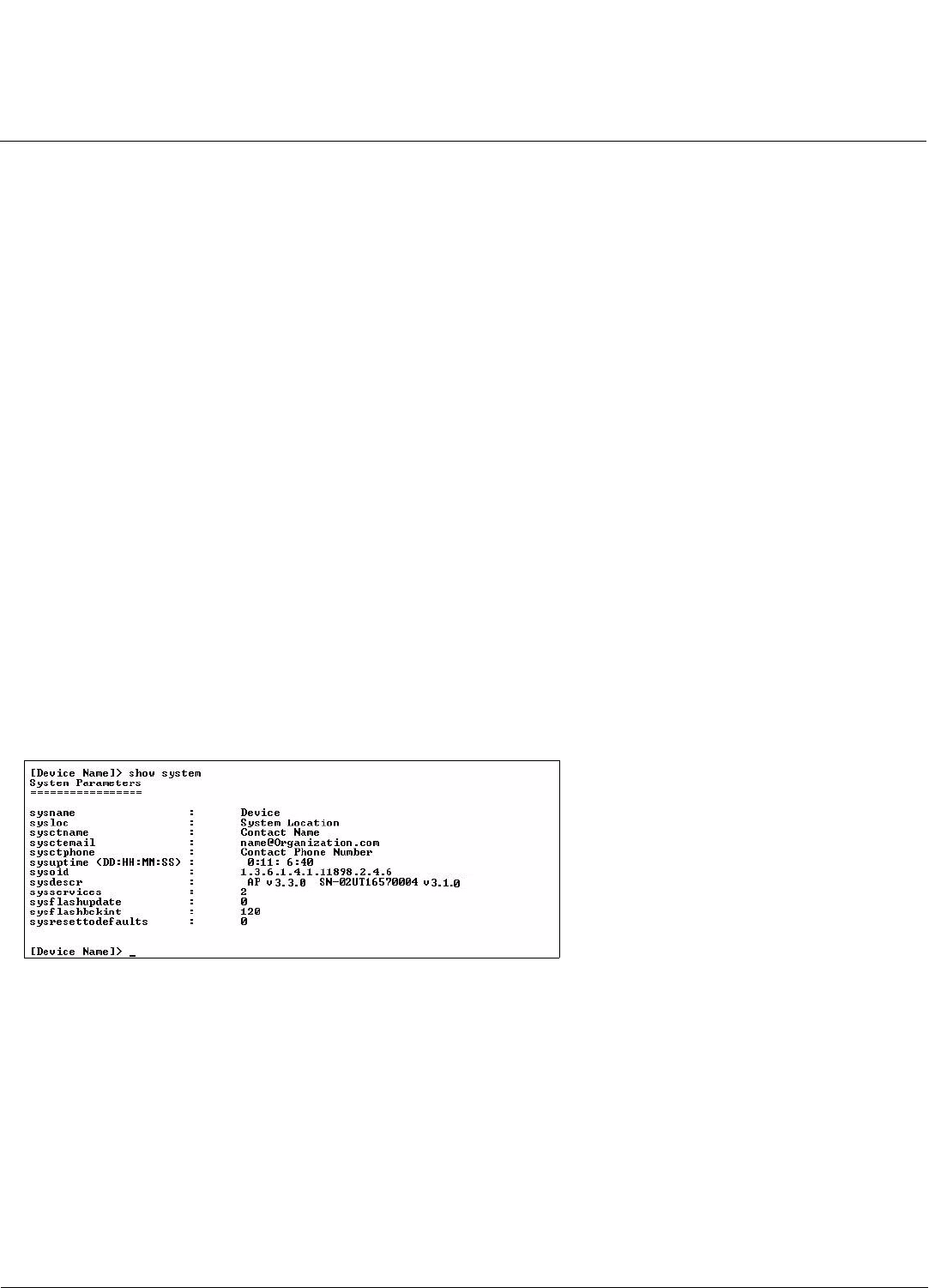
Command Line Interface (CLI) AP-700 User Guide
Configuring the AP using CLI commands
176
Set Basic Configuration Parameters using CLI Commands
There are a few basic configuration parameters that you may want to setup right away when you receive the AP. For
example:
•Set System Name, Location and Contact Information
•Set Static IP Address for the AP
•Download an AP Configuration File from your TFTP Server
•Set up Auto Configuration
•Set Network Names for the Wireless Interface
•Enable 802.11d Support and Set the Country Code
•Enable and Configure TX Power Control for the Wireless Interface
•Configure SSIDs (Network Names), VLANs, and Profiles
•Download an AP Configuration File from your TFTP Server
•Backup your AP Configuration File
Set System Name, Location and Contact Information
NOTE: System name must:
•Contain only letters, numbers, and hyphens.
•Be limited to 31 characters.
•Not begin with a number or hyphen.
•Not contain blank spaces.
[Device-Name]>set sysname <Name> sysloc <Unit Location>
[Device-Name]>set sysctname <Contact Name>
[Device-Name]>set sysctphone <Contact Phone Number> sysctemail <Contact E-mail address>
[Device-Name]>show system
Figure A-12 Result of “show system” CLI Command
Set Static IP Address for the AP
NOTE: The IP Subnet Mask of the AP must match your network’s Subnet Mask.
[Device-Name]>set ipaddrtype static
[Device-Name]>set ipaddr <fixed IP address of unit>
[Device-Name]>set ipsubmask <IP Mask>
[Device-Name]>set ipgw <gateway IP address>
[Device-Name]>show network
Change Passwords
[Device-Name]>passwd <Old Password> <New Password> <Confirm Password> (CLI password)
[Device-Name]>set httppasswd <New Password> (HTTP interface password)
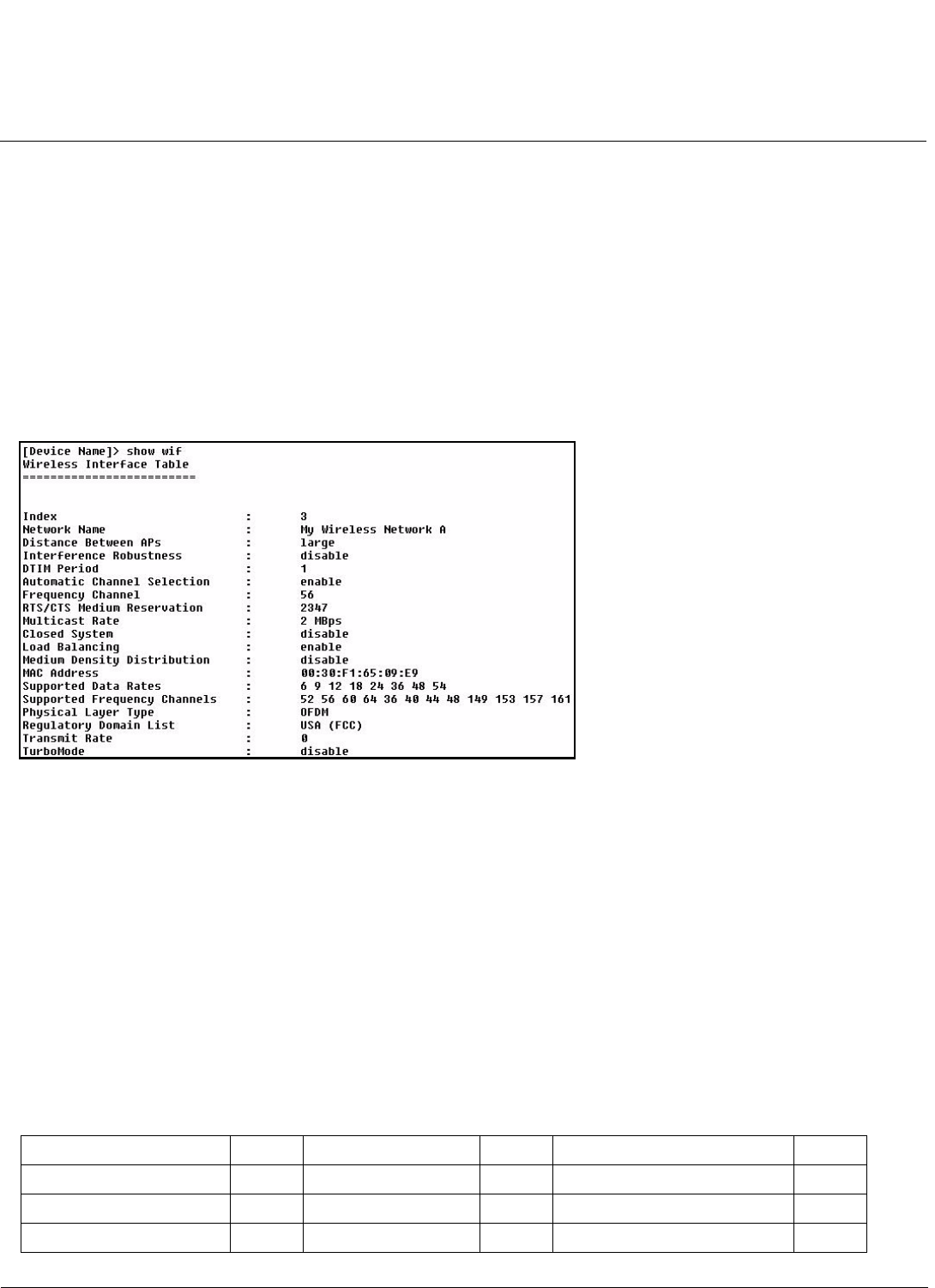
Command Line Interface (CLI) AP-700 User Guide
Configuring the AP using CLI commands
177
[Device-Name]>set snmprpasswd <New Password> (SNMP read password)
[Device-Name]>set snmprwpasswd <New Password> (SNMP read/write)
[Device-Name]>set snmpv3authpasswd <New Password> (SNMPv3 authentication password)
[Device-Name]>set snmpv3privpasswd <New Password> (SNMPv3 privacy password)
[Device-Name]>reboot 0
CAUTION: Proxim strongly urges you to change the default passwords to restrict access to your network devices to
authorized personnel. If you lose or forget your password settings, you can always perform the Soft Reset to
Factory Defaults.
Set Network Names for the Wireless Interface
[Device-Name]>set wif 3 netname <Network Name (SSID) for wireless interface>
[Device-Name]>show wif
Figure A-13 Results of “show wif” CLI command for an AP
Enable 802.11d Support and Set the Country Code
NOTE: On APs with model numbers ending in -WD, these commands are not available.
Perform the following command to enable 802.11d IEEE 802.11d support for additional regulatory domains.
[Device-Name]>set wif 3 dot11dstatus <enable/disable>
Perform the following command to set a country code:
[Device-Name]>set syscountrycode <country code>
Select a country code from the following table, derived from ISO 3166. Available countries will vary based on regulatory
domain. Refer to the ISO/IEC 3166-1 CountryCode drop-down menu on the Configure > Interfaces > Operational
Mode page; this menu contains a list of all the available countries in your regulatory domain.
NOTE: If you select a country code that is not supported in your regulatory domain, clients may attempt to connect to a
channel that is not supported by your AP.
Country Code Country Code Country Code
Algeria DZ Honduras HN Panama PA
Albania AL Hong Kong HK Papua New Guinea PG
Argentina AR Hungary HU Peru PE

Command Line Interface (CLI) AP-700 User Guide
Configuring the AP using CLI commands
178
Enable and Configure TX Power Control for the Wireless Interface
The TX Power Control feature lets the user configure the transmit power level of the card in the AP.
Armenia AM Iceland IS Philippines PH
Australia AU India IN Poland PL
Austria AT Indonesia ID Portugal PT
Azerbaijan AZ Ireland 5.8 GHz I1 Puerto Rico PR
Bahrain BH Israel IL Qatar QA
Belarus BY Italy IT Romania RO
Belgium BE Jamaica JM Russia RU
Belize BZ Japan JP Samoa WS
Bolivia BO Japan2 J2 Saudi Arabia SA
Brazil BR Jordan JO Singapore SG
Brunei Darussalam BN Kazakhstan KZ Slovak Republic SK
Bulgaria BG North Korea KP Slovenia SI
Canada CA Korea Republic KR South Africa ZA
Chile CL Korea Republic2 K2 South Korea KR
China CN Kuwait KW Spain ES
Colombia CO Latvia LV Sweden SE
Costa Rica CR Lebanon LB Switzerland CH
Croatia HR Liechtenstein LI Syria SY
Cyprus CY Lithuania LT Taiwan TW
Czech Republic CZ Luxembourg LU Thailand TH
Denmark DK Macau MO Turkey TR
Dominican Republic DO Macedonia MK Ukraine UA
Ecuador EC Malaysia MY United Arab Emirates AE
Egypt EG Malta MT United Kingdom GB
El Salvador SV Mexico MX United Kingdom 5.8 GHz G1
Estonia EE Monaco MC United States US
Finland FI Morocco MA United States World UW
France FR Netherlands NL United States DFS U1
Georgia GE New Zealand NZ Uruguay UY
Germany DE Nicaragua NI Venezuela VE
Greece GR Norway NO Vietnam VN
Guam GU Oman OM
Guatemala GT Pakistan PK
Country Code Country Code Country Code

Command Line Interface (CLI) AP-700 User Guide
Configuring the AP using CLI commands
179
Perform the following commands to enable TX Power Control and set the transmit power level:
[Device-Name]>set txpowercontrol enable
[Device-Name]>set wif <interface number> currentbackofftpcvalue <0-9 dBm1-35 dBm>
Configure SSIDs (Network Names), VLANs, and Profiles
Perform the following command to configure SSIDs and VLANS, and to assign Security and RADIUS Profiles.
[Device-Name]>set wifssidtbl <Wireless Interface Index.SSID Index> ssid <Network Name>
vlanid <-1 to 1094> ssidauth <enable/disable> acctstatus <enable/disable> secprofile
<Security Profile Nmuber> radmacprofile <MAC Authentication Profile Name> radeapprofile
<EAP Authentication Profile Name> radacctprofile <Accounting Profile Name>
radmacauthstatus <enable/disable> aclstatus <enable/disable>
Example:
[Device-Name]>set wifssidtbl 3.1 ssid accesspt1 vlanid 22 ssidauth enable acctstatus
enable secprofile 1 radmacprofile "MAC Authentication" radeapprofile "EAP Authentication"
radacctprofile "Accounting" radmacauthstatus enable aclstatus enable
Download an AP Configuration File from your TFTP Server
Start the Solarwinds TFTP program (available on the installation CD), and click on the Security tab to verify that the TFTP
server is configured to both transmit and receive files. (Note that TFTP programs other than Solarwinds may also require
this setting.) Then enter the following commands:
[Device-Name]>set tftpfilename <file name> tftpfiletype config
tftpipaddr <IP address of your TFTP server>
[Device-Name]>show tftp (to ensure the filename, file type, and the IP address are correct)
[Device-Name]>download *
[Device-Name]>reboot 0
After following the complete process (above) once, you can download a file of the same name (so long as all the other
parameters are the same), with the following command:
[Device-Name]>download *
Backup your AP Configuration File
Start the Solarwinds TFTP program (available on the installation CD), and click on the Security tab to verify that the TFTP
server is configured to both transmit and receive files. (Note that TFTP programs other than Solarwinds may also require
this setting.) Then enter the following commands:
[Device-Name]>upload <TFTP Server IP address> <tftpfilename (such as “config.sys”)> config
[Device-Name]>show tftp (to ensure the filename, file type, and the IP address are correct)
After setting the TFTP parameters, you can backup your current file (so long as all the other parameters are the same),
with the following command:
[Device-Name]>upload *
Set up Auto Configuration
The Auto Configuration feature which allows an AP to be automatically configured by downloading a specific
configuration file from a TFTP server during the boot up process.
Perform the following commands to enable and set up automatic configuration:

Command Line Interface (CLI) AP-700 User Guide
Configuring the AP using CLI commands
180
NOTE: The configuration filename and TFTP server IP address are configured only when the AP is configured for Static
IP. If the AP is configured for Dynamic IP these parameters are not used and obtained from DHCP.
The default filename is “config”. The default TFTP IP address is “169.254.128.133”.
[Device-Name]>set autoconfigstatus <enable/disable>
[Device-Name]>set autoconfigfilename <configuration file name>
[Device-Name]>set autoconfigTFTPaddr <TFTP IP address>

Command Line Interface (CLI) AP-700 User Guide
Configuring the AP using CLI commands
181
Other Network Settings
There are other configuration settings that you may want to set for the AP. Some of them are listed below.
•Configure the AP as a DHCP Server
•Configure the DNS Client
•Configure DHCP Relay and Configure DHCP Relay Servers
•Maintain Client Connections using Link Integrity
•Change Wireless Interface Settings
•Set Ethernet Speed and Transmission Mode
•Set Interface Management Services
•Configure Wireless Distribution System
•Configure MAC Access Control
•Set RADIUS Parameters
•Set Rogue Scan Parameters
•Set Hardware Configuration Reset Parameters
•Set VLAN/SSID Parameters
•Set Security Profile Parameters
NOTE: See Advanced Configuration for more information on these settings.
Configure the AP as a DHCP Server
NOTE: You must have at least one entry in the DHCP Server IP Address Pool Table before you can set the DHCP
Server Status to Enable.
[Device-Name]>set dhcpstatus disable
[Device-Name]>set dhcpippooltbl 0 startipaddr <start ip address>
endipaddr <end ip address>
[Device-Name]>set dhcpgw <gateway ip address>
[Device-Name]>set dhcppridnsipaddr <primary dns ip address>
[Device-Name]>set dhcpsecdnsipaddr <secondary dns ip address>
[Device-Name]>set dhcpstatus enable
[Device-Name]>reboot 0
CAUTION: Before enabling this feature, confirm that the IP address pools you have configured are valid addresses on
the network and do not overlap the addresses assigned by any other DHCP server on the network. Enabling
this feature with incorrect address pools will cause problems on your network.
Configure the DNS Client
[Device-Name]>set dnsstatus enable
[Device-Name]>set dnsprisvripaddr <IP address of primary DNS server>
[Device-Name]>set dnssecsvripaddr <IP address of secondary DNS server>
[Device-Name]>set dnsdomainname <default domain name>
[Device-Name]>show dns
Figure A-14 Results of “show dns” CLI command

Command Line Interface (CLI) AP-700 User Guide
Configuring the AP using CLI commands
182
Configure DHCP Relay
Perform the following command to enable or disable DHCP Relay Agent Status.
NOTE: You must have at least one entry in the DHCP Relay Server Table before you can set the DHCP Relay Status to
Enable.
[Device-Name]>set dhcprelaystatus enable
Configure DHCP Relay Servers
Perform the following command to configure and enable a DHCP Relay Server. The AP allows the configuration of a
maximum of 10 server settings in the DHCP Relay Agents server table.
[Device-Name]>set dhcprlyindex 1 dhcprlyipaddr <ip address> dhcprlycmt <comment>
dhcprlystatus 1 (1 to enable, 2 to disable, 3 to delete, 4 to create)
Maintain Client Connections using Link Integrity
[Device-Name]>show linkinttbl (this shows the current links)
[Device-Name]>set linkinttbl <1–5 (depending on what table row you wish to address)>
ipaddr <ip address of the host computer you want to check>
[Device-Name]>set linkintpollint <the interval between link integrity checks>
[Device-Name]>set linkintpollretx <number of times to retransmit before considering the
link down>
[Device-Name]>set linkintstatus enable
[Device-Name]>show linkinttbl (to confirm new settings)
[Device-Name]>reboot 0
Change Wireless Interface Settings
See Interfaces for information on the parameters listed below. The AP uses index 3.
Operational Mode
[Device-Name]>set wif 3 mode <see table>
Autochannel Select (ACS)
ACS is enabled by default. Reboot after disabling or enabling ACS.
[Device-Name]>set wif 3 autochannel <enable/disable>
[Device-Name]>reboot 0
Enable/Disable Closed System
[Device-Name]>set wif 3 closedsys <enable/disable>
Mode Operational Mode
1 dot11b-only
2 dot11g-only
3 dot11bg
4 dot11a-only
5 dot11g-wifi

Command Line Interface (CLI) AP-700 User Guide
Configuring the AP using CLI commands
183
Shutdown/Resume Wireless Service
[Device-Name]>set wif 3 wssstatus <1 (resume)/2 (shutdown)>
Set Load Balancing Maximum Number of Clients
[Device-Name]>set wif 3 lbmaxclients <1–63>
Set the Multicast Rate (802.11a/b/g)
[Device-Name]>set wif 3 multrate <6, 12, 24 (Mbits/sec)>
Enable/Disable Super Mode (802.11a/g only)
[Device-Name]>set wif 3 supermode <enable/disable>
Enable/Disable Turbo Mode (802.11a/g only)
[Device-Name]>set wif 3 turbo <enable/disable>
NOTE: Super mode must be enabled on the interface before Turbo mode can be enabled.
Configure Antenna Diversity
[Device-Name]>set wif 3 atdiversity <1, 2, 5(auto)> (see below)
[Device-Name]>reboot 0
NOTE: See Antennas for more information on internal and external antenna ports.
Set the Distance Between APs
[Device-Name]>set wif 3 distaps <1–5> (see below)
[Device-Name]>reboot 0
Value Corresponding Antenna Enabled
1 802.11a/b/g (connector 1)
2 802.11a/b/g (connector 2)
5 (auto) Both antennas
Value Distance Between APs
1 Large
2Medium
3Small
4Mini
5Micro

Command Line Interface (CLI) AP-700 User Guide
Configuring the AP using CLI commands
184
Set Ethernet Speed and Transmission Mode
[Device-Name]>set etherspeed <value> (see below)
[Device-Name]>reboot 0
Set Interface Management Services
Edit Management IP Access Table
[Device-Name]>set mgmtipaccesstbl <index> ipaddr <IP address> ipmask <subnet mask>
Configure Management Ports
[Device-Name]>set snmpifbitmask <(see below)>
[Device-Name]>set httpifbitmask <(see below)>
[Device-Name]>set telifbitmask <(see below)>
Choose from the following values:
Set Communication Ports
[Device-Name]>set httpport <HTTP port number (default is 80)>
[Device-Name]>set telport <Telnet port number (default is 23)>
Configure Secure Socket Layer (HTTPS)
Enabling SSL and configuring a passphrase allows encrypted Secure Socket Layer communications to the AP through
the HTTPS interface.
[Device-Name]>set sslstatus <enable/disable>
The user must change the SSL passphrase when uploading a new certificate/private key pair, which will have a
corresponding passphrase.
[Device-Name]>set sslpassphrase <SSL certificate passphrase>
[Device-Name]>show http (to view all HTTP configuration information including SSL.)
Ethernet Speed and
Transmission Mode
Value
10 Mbits/sec - half duplex 10halfduplex
10 Mbits/sec - full duplex 10fullduplex
10 Mbits/sec - auto duplex 10autoduplex
100 Mbits/sec - half duplex 100halfduplex
100 Mbits/sec - full duplex 100fullduplex
Auto Speed - half duplex autohalfduplex
Auto Speed - auto duplex autoautoduplex (default)
Interface Bitmask Description
0 or 2 = Disable (all interfaces) All management channels disabled
1 or 3 = Ethernet only Ethernet only enabled
4 or 6 = Wireless only Wireless A only enabled
5 or 7 = Enable all interfaces All management channels enabled
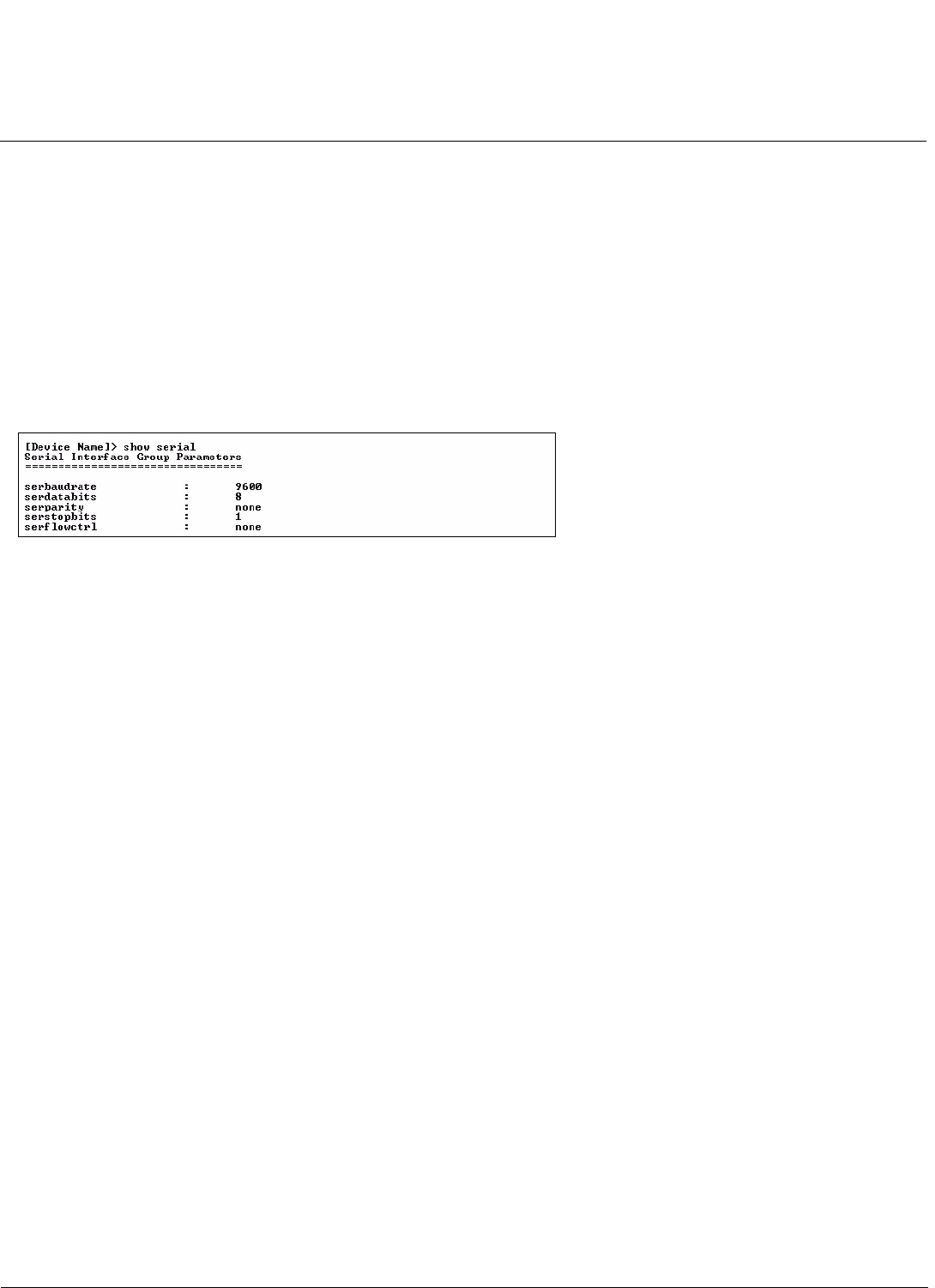
Command Line Interface (CLI) AP-700 User Guide
Configuring the AP using CLI commands
185
Set Telnet Session Timeouts
[Device-Name]>set tellogintout <time in seconds between 1 and 300 (default is 30)>
[Device-Name]>set telsessiontout <time in seconds between 1 and 36000 (default is 900)>
Configure Serial Port Interface
NOTE: To avoid unexpected performance issues, leave Flow Control at the default setting (none) unless you are sure
what this setting should be.
[Device-Name]>set serbaudrate <2400, 4800, 9600, 19200, 38400, 57600>
[Device-Name]>set serflowctrl <none, xonxoff>
[Device-Name]>show serial
Figure A-15 Result of “show serial” CLI Command
Configure Syslog
[Device-Name]>set syslogpriority <1–7 (default is 6)>
[Device-Name]>set syslogstatus <enable/disable>
[Device-Name]>set sysloghbstatus <enable/disable> (default is disable)
[Device-Name]>set sysloghbinterval <1–604800> (default is 900 seconds)
[Device-Name]>set sysloghosttbl <index> ipaddr <ipaddress> cmt <comment> status
<enable/disable>
Configure Intra BSS
[Device-Name]>set intrabssoptype <passthru (default)/block)>
Configure Wireless Distribution System
Create/Enable WDS
[Device-Name]>set wdstbl <Index> partnermacaddr <MAC Address> status enable
Enable/Disable WDS
[Device-Name]>set wdstbl <Index> status <enable/disable>
NOTE: <Index> is 3.1–3.6. To determine the index, type show wdstbl at the prompt.
NOTE: When WDS is enabled, spanning tree protocol is automatically enabled. It may be manually disabled. If Spanning
Tree protocol is enabled by WDS and WDS is subsequently disabled, Spanning tree will remain enabled until it is
manually disabled. See Spanning Tree Parameters.
Configure MAC Access Control
Setup MAC (Address) Access Control
[Device-Name]>set wifssidtbl <index> aclstatus enable/disable
[Device-Name]>set macacloptype <passthru, block>
[Device-Name]>reboot 0

Command Line Interface (CLI) AP-700 User Guide
Configuring the AP using CLI commands
186
Add an Entry to the MAC Access Control Table
[Device-Name]>set macacltbl 0 macaddr <MAC Address> status enable
[Device-Name]>show macacltbl
Disable or Delete an Entry in the MAC Access Control Table
[Device-Name]>set macacltbl <index> status <disable/delete>
[Device-Name]>show macacltbl
NOTE: For larger networks that include multiple Access Points, you may prefer to maintain this list on a centralized
location using the RADIUS parameters (see Set RADIUS Parameters).
Set RADIUS Parameters
Configure RADIUS Authentication servers
Perform the following command to configure a RADIUS Server and assign it to a VLAN. The RADIUS Server Profile
index is specified by the index parameter and the subindex parameter specifies whether you are configuring a primary or
secondary RADIUS server.
[Device-Name]>set radiustbl <Index> profname <Profile Name> seraddrfmt <1 - IP Address 2
- Name> sernameorip <IP Address or Name> port <value> ssecret <value> responsetm <value>
maxretx <value> acctupdtintrvl <value> macaddrfmt <value> authlifetm <value>
radaccinactivetmr <value> vlanid <vlan id -1 to 4094> status enable
NOTE: To create a new RADIUS profile, use 0 for <Index>.
Examples of Configuring Primary and Secondary RADIUS Servers and Displaying the RADIUS Configuration
Primary server configuration:
[Device-Name]>set radiustbl 1.1 profname "MAC Authentication" seraddrfmt 1 sernameorip
20.0.0.20 port 1812 ssecret public responsetm 3 maxretx 3 acctupdtintrvl 0 macaddrfmt 1
authlifetm 900 radaccinactivetmr 5 vlanid 22 status enable
Secondary server configuration:
[Device-Name]>set radiustbl 1.2 profname "MAC Authentication" seraddrfmt 1 sernameorip
20.0.0.30 port 1812 ssecret public responsetm 3 maxretx 3 acctupdtintrvl 0 macaddrfmt 1
authlifetm 900 radaccinactivetmr 5 vlanid 33 status enable
[Device-Name]>show radiustbl
Index : 1
Primary/Backup : Primary
Profile Name : MAC Authentication
Server Status : notReady
Server Addressing Format : ipaddr
IP Address/Host Name : 0.0.0.0
Destination Port : 1812
VLAN Identifier : -1
MAC Address Format : dashdelimited
Response Time : 3
Maximum Retransmission : 3
Authorization Lifetime : 0
Accounting Update Interval : 0
Accounting Inactivity Timer : 5

Command Line Interface (CLI) AP-700 User Guide
Configuring the AP using CLI commands
187
Index : 1
Primary/Backup : Backup
Profile Name : MAC Authentication
Server Status : notReady
Server Addressing Format : ipaddr
IP Address/Host Name : 0.0.0.0
Destination Port : 1812
VLAN Identifier : -1
MAC Address Format : dashdelimited
Response Time : 3
Maximum Retransmission : 3
.
.
.
Index : 4
Primary/Backup : Backup
Profile Name : Management Access
Server Status : notReady
Server Addressing Format : ipaddr
IP Address/Host Name : 0.0.0.0
Destination Port : 1812
VLAN Identifier : -1
MAC Address Format : dashdelimited
Response Time : 3
Maximum Retransmission : 3
Authorization Lifetime : 0
Accounting Update Interval : 0
Accounting Inactivity Timer : 5
Figure A-16 Result of “showradiustbl” CLI Command
Set Rogue Scan Parameters
Perform the following command to enable or disable Rogue Scan on a wireless interface and configure the scanning
parameters.
The cycletime parameter is only configured for background scanning mode.
[Device-Name]>set rscantbl 3 mode <1 for background scanning, 2 for continuous scanning>
cycletime <cycletime from 1–1440 minutes> status <enable/disable>
NOTE: Rogue Scan cannot be enabled on a wireless interface when the Wireless Service Status on that interface is
shutdown. First, resume service on the wireless interface.
Set Hardware Configuration Reset Parameters
The Hardware Configuration Reset commands allows you to enable or disable the hardware reset functionality and to
change the password to be used for configuration reset during boot up.
To disable hardware configuration reset, enter:
[Device-Name]>set hwconfigresetstatus disable
To enable hardware configuration reset, enter:
[Device-Name]>set hwconfigresetstatus enable

Command Line Interface (CLI) AP-700 User Guide
Configuring the AP using CLI commands
188
To define the Configuration Reset Password to be used for configuration reset during boot up, enter the following
command
[Device-Name]>set configresetpasswd <password>
It is important to safely store the
NOTE: It is important to safely store the configuration reset password. If a user forgets the configuration reset password,
the user will be unable to reset the AP to factory default configuration if the AP becomes inaccessible and the
hardware configuration reset functionality is disable.
Set VLAN/SSID Parameters
Enable VLAN Management
[Device-Name]>set vlanstatus enable
[Device-Name]>set vlanmgmtid <1–4094>
[Device-Name]>show wifssidtbl (to review your settings)
[Device-Name]>reboot 0
Disable VLAN Management
[Device-Name]>set vlanstatus disable or
[Device-Name]>set vlanmgmtid -1
[Device-Name]>reboot 0
Add a Entry to the WIFSSID Table
[Device-Name]>set wifssidtbl <index> ssid <Network Name> vlanid <-1 (untagged) or 1–4094>
status enable
Set Security Profile Parameters
Configure a Security Profile with Non Secure Security Mode
[Device-Name]>set secprofiletbl <index> secmode nonsecure status enable
Example:
[Device-Name]>set secprofiletbl 2 secmode nonsecure status enable
Configure a Security Profile with WEP Security Mode
[Device-Name]>set secprofiletbl <index> secmode wep encryptkey<0-3> <value>
encryptkeylength <value> encryptkeytx <value> status enable
Example:
[Device-Name]>set secprofiletbl 3 secmode wep encryptkey0 12345 encryptkeylength 1
encryptkeytx 0 status enable
Configure a Security Profile with 802.1x Security Mode
[Device-Name]>set secprofiletbl <index> secmode 802.1x encryptkeylength <value> status
enable
Example:
[Device-Name]>set secprofiletbl 4 secmode 802.1x encryptkeylength 1 status enable
Configure a Security Profile with WPA Security Mode
[Device-Name]>set secprofiletbl <index> secmode wpa status enable

Command Line Interface (CLI) AP-700 User Guide
Configuring the AP using CLI commands
189
Example:
[Device-Name]>set secprofiletbl 5 secmode wpa status enable
Configure a Security Profile with WPA-PSK Security Mode
[Device-Name]>set secprofiletbl <index> secmode wpa-psk passphrase <value> status enable
Example:
[Device-Name]>set secprofiletbl 6 secmode wpa-psk passphrase 12345678 status enable
Configure a Security Profile with 802.11i Security Mode
[Device-Name]>set secprofiletbl <index> secmode 802.11i status enable
Example:
[Device-Name]>set secprofiletbl 7 secmode 802.11i status enable
Configure a Security Profile with 802.11i-PSK Security Mode
[Device-Name]>set secprofiletbl <index> secmode 802.11i-psk passphrase <value> status
enable
Example:
[Device-Name]>set secprofiletbl 8 secmode 802.11i-psk passphrase 12345678 status enable

Command Line Interface (CLI) AP-700 User Guide
CLI Monitoring Parameters
190
CLI Monitoring Parameters
Using the show command with the following table parameters will display operating statistics for the AP (these are the
same statistics that are described in the Monitoring section).
•staticmp: Displays the ICMP statistics.
•statarptbl: Displays the IP ARP Table statistics.
•statbridgetbl: Displays the Learn Table.
•statiapp: Displays the IAPP statistics.
•statradius: Displays the RADIUS Authentication statistics.
•statif: Displays information and statistics about the Ethernet and wireless interfaces.
•stat802.11: Displays additional statistics for the wireless interfaces.
•statethernet: Displays additional statistics for the Ethernet interface.
•statmss: Displays station statistics and Wireless Distribution System links.

Command Line Interface (CLI) AP-700 User Guide
Parameter Tables
191
Parameter Tables
Objects contain groups that contain both parameters and parameter tables. Use the following Tables to configure the
Access Point. Columns used on the tables include:
• Name - Parameter, Group, or Table Name
• Type - Data type
• Value - Value range, and default value, if any
• Access = access type, R = Read Only (show), RW = Read-Write (can be “set”), W = Write Only
• CLI Parameter - Parameter name as used in the Access Point
Access Point network objects are associated with Groups. The network objects are listed below and associated
parameters are described in the following Parameter Tables:
•System Parameters - Access Point system information
–Inventory Management Information - Hardware, firmware, and software version information
•Network Parameters - IP and Network Settings
–IP Configuration Parameters - Configure the Access Point’s IP settings
•DNS Client for RADIUS Name Resolution - Configure the Access Point as a DNS client
–DHCP Server Parameters - Enable or disable dynamic host configuration
–SNTP Parameters - Configure
–Link Integrity Parameters - Monitor link status
•Interface Parameters - Configure Wireless and Ethernet settings
–Wireless Interface Parameters
•Wireless Distribution System (WDS) Parameters - Configure the WDS partnerships
–Wireless Interface SSID/VLAN/Profile Parameters - Configure the SSIDs, VLANs, and security modes. Up to 16
SSIDs are supported; different security settings can be applied to each SSID, and a unique VLAN can be
configured per SSID.
–Ethernet Interface Parameters - Set the speed and duplex of the Ethernet port.
•Management Parameters - Control access to the AP’s management interfaces
–SNMP Parameters - Set read and read/write passwords
–HTTP Parameters - Set up the graphical web browser interface. If required, enable SSL and configure the SSL
certificate passphrase.
–Telnet Parameters - Telnet Port setup
–Serial Port Parameters - Serial Port setup
–RADIUS Based Management Access Parameters - Configure RADIUS Based Management Access for HTTP and
Telnet access.
–SSH Parameters - Enable SSH and configure the host key.
–TFTP Server Parameters - Set up for file transfers; specify IP Address, file name, and file type
–IP Access Table Parameters - Configure range of IP addresses that can access the AP
–Auto Configuration Parameters - Configure the Auto Configuration feature which allows an AP to be automatically
configured by downloading a configuration file from a TFTP server during boot up.
•Filtering Parameters
–Ethernet Protocol Filtering Parameters - Control network traffic based on protocol type
–Static MAC Address Filter Table - Enable and disable specific addresses
–Proxy ARP Parameters - Enable or disable proxy ARP for wireless clients
–IP ARP Filtering Parameters - Control which ARP messages are sent to wireless clients based on IP settings
–Broadcast Filtering Table - Control the type of broadcast packets forwarded to the wireless network

Command Line Interface (CLI) AP-700 User Guide
Parameter Tables
192
–TCP/UDP Port Filtering - Filter IP packets based on TCP/UDP port
•Alarms Parameters
–SNMP Table Host Table Parameters - Enter the list of IP addresses that will receive alarms from the AP
–Syslog Parameters - Configure the AP to send Syslog information to network servers
•Bridge Parameters
–Spanning Tree Parameters - Used to help prevent network loops
–Storm Threshold Parameters - Set threshold for number of broadcast packets
–Intra BSS Subscriber Blocking - Enable or disable peer to peer traffic on the same AP
–Packet Forwarding Parameters - Redirect traffic from wireless clients to a specified MAC address
•RADIUS Parameters
–Set RADIUS Parameters - Configure RADIUS Servers and assign them to VLANs.
•Security Parameters - Access Point security settings
–MAC Access Control Parameters - Control wireless access based on MAC address
–Rogue Scan Configuration Table - Enable and configure Rogue Scan to detect Rogue APs and clients.
–802.1x Parameters - Configure 802.1X Supplicant Timeout parameter
–Hardware Configuration Reset - Disable or enable hardware configuration reset and configure a configuration
reset password.
–Other Parameters - Configure Security Profiles that define allowed security modes (wireless clients), and
encryption and authentication mechanisms.
•VLAN/SSID Parameters - Enable the configuration of multiple subnetworks based on VLAN ID and SSID.
•Other Parameters
–IAPP Parameters - Enable or disable the Inter-Access Point Protocol
–Wireless Multimedia Enhancements (WME)/Quality of Service (QoS) parameters - Enable and configure Wireless
Multimedia Enhancement/Quality of Service parameters, QoS policies, mapping priorities, and EDCA parameters.
Apply a configured QoS policy to a particular SSID.

Command Line Interface (CLI) AP-700 User Guide
Parameter Tables
193
System Parameters
* Available only on APs with model numbers ending in -WD. When available, this object must be configured before any interface parameters
can be set.
Country Identifiers
NOTE: All countries may not be available on your AP.
Name Type Value Access CLI Parameter
System Group N/A R system
Name DisplayString User Defined RW sysname
Location DisplayString User Defined RW sysloc
Country Identifier* DisplayString See Country Identifiers
below
RW sysworldcountrycode
Contact Name DisplayString User Defined RW sysctname
Contact E-mail DisplayString User Defined RW sysctemail
Contact Phone DisplayString User Defined
max 254 characters
RW sysctphone
FLASH Backup Interval Integer 0 - 65535 seconds RW sysflashbckint
Flash Update 0
1
RW sysflashupdate
System OID DisplayString N/A R sysoid
Descriptor DisplayString System Name, flash
version, S/N, bootloader
version
R sysdescr
Up Time Integer dd:hh:mm:ss
dd - days
hh - hours
mm - minutes
ss - seconds
Rsysuptime
System Security ID DisplayString Retrieved from flash ID R sysinvmgmtsecurityid
Emergency Restore to
defaults
Resets all parameters to
default factory values
RW sysresettodefaults
Note: You must enter the
following command twice to
reset to defaults:
set sysresettodefaults 1
Country Indoor/Outdoor Identifier
Austria Indoor AT1
Outdoor AT2
Belgium Indoor BE1
Outdoor BE2
Cyprus Indoor CY1
Outdoor CY2
Czech Republic Indoor CZ1
Outdoor CZ2
Denmark Indoor DK1
Outdoor DK2
Estonia Indoor EE1
Outdoor EE2

Command Line Interface (CLI) AP-700 User Guide
Parameter Tables
194
Finland Indoor FI1
Outdoor FI2
France Indoor FR1
Outdoor FR2
Germany Indoor DE1
Outdoor DE2
Greece Indoor GR1
Outdoor GR2
Hungary Indoor HU1
Outdoor HU2
Ireland Indoor IE1
Outdoor IE2
Italy Indoor IT1
Outdoor IT2
Latvia Indoor LV1
Outdoor LV2
Lithuania Indoor LT1
Outdoor LT2
Luxembourg Indoor LU1
Outdoor LU2
Malta Indoor MT1
Outdoor MT2
Netherlands Indoor NL1
Outdoor NL2
Norway Indoor NO1
Outdoor NO2
Poland Indoor PL1
Outdoor PL2
Portugal Indoor PT1
Outdoor PT2
Puerto Rico Indoor PR1
Outdoor PR2
Russia Indoor/Outdoor RU
Spain Indoor ES1
Outdoor ES2
Sweden Indoor SE1
Outdoor SE2
Switzerland Indoor CH1
Outdoor CH2
United Kingdom/
Great Britain
Indoor GB1
Outdoor GB2
Country Indoor/Outdoor Identifier

Command Line Interface (CLI) AP-700 User Guide
Parameter Tables
195
Inventory Management Information
The inventory management commands display advanced information about the AP’s installed components. You may be
asked to report this information to a representative if you contact customer support.
Network Parameters
IP Configuration Parameters
NOTE: The IP Address Assignment Type (ipaddrtype) must be set to static before the IP Address (ipaddr), IP Mask
(ipmask) or Default Gateway IP Address (ipgw) values can be entered.
Name Type Value Access CLI Parameter
System Inventory
Management
Subgroup N/A R sysinvmgmt
Component Table Subgroup N/A R sysinvmgmtcmptbl
Component Interface
Table
Subgroup N/A R sysinvmgmtcmpiftbl
Name Type Value Access CLI Parameter
Network Group N/A R network
IP Configuration Group N/A R ip (Note: The network and
ip parameters display the
same information)
IP Address IpAddress User Defined RW ipaddr
IP Mask IpAddress User Defined RW ipmask
Default Router IP
Address
IpAddress User Defined RW ipgw
Default TTL Integer User Defined (seconds)
0 - 255, 64 (default)
RW ipttl
Address Type Integer static
dynamic (default)
RW ipaddrtype

Command Line Interface (CLI) AP-700 User Guide
Parameter Tables
196
DNS Client for RADIUS Name Resolution
DHCP Server Parameters
* The DHCP Server (dhcpstatus) can only be enabled after a DHCP IP Pool table entry has been created.
DHCP Server table for IP pools
* IP addresses must be from within the same subnet as the AP.
† Set End IP Address or Width, but not both.
Name Type Value Access CLI Parameter
DNS Client Group N/A R dns
DNS Client status Integer enable
disable (default)
RW dnsstatus
Primary DNS Server IP
Address
IpAddress User Defined RW dnspridnsipaddr
Secondary DNS Server
IP Address
IpAddress User Defined RW dnssecdnsipaddr
Default Domain Name Integer32 User Defined (up to 254
characters)
RW dnsdomainname
Name Type Value Access CLI Parameter
DHCP Server Group N/A R dhcp
DHCP Server Status* Integer enable (1) (default)
disable (2)
delete (3)
RW dhcpstatus
Gateway IP Address IpAddress User Defined RW dhcpgw
Primary DNS IP Address IpAddress User Defined RW dhcppridnsipaddr
Secondary DNS IP
Address
IpAddress User Defined RW dhcpsecdnsipaddr
Number of IP Pool Table
Entries
Integer32 N/A R dhcpippooltblent
Name Type Value Access CLI Parameter
DHCP Server IP Address
Pool Table
Table N/A R dhcpippooltbl
Table Index Integer User Defined N/A index
Start IP Address* IpAddress User Defined RW startipaddr
End IP Address*†IpAddress User Defined RW endipaddr
Width†Integer User Defined RW width
Default Lease Time
(optional)
Integer32 300 - 86400 sec (default) RW defleasetm
Maximum Lease Time
(optional)
Integer32 300 - 86400 sec (default) RW maxleasetm
Comment (optional) DisplayString User Defined RW cmt
Status (optional) Integer enable (1)
disable (2)
delete (3)
RW status

Command Line Interface (CLI) AP-700 User Guide
Parameter Tables
197
DHCP Relay Group
The DHCP Relay Group allows you to enable or disable DHCP Relay Agent Status.
DHCP Relay Server Table
The DHCP Relay Server Table contains the commands to set the table entries. The AP supports the configuration of a
maximum of 10 server settings in the DHCP Relay Agents server table.
Name Type Value Access CLI Parameter
DHCP Relay Group Group N/A R dhcprelay
Status Integer enable
disable
RW dhcprelaystatus
DHCP Relay Server
Table
Table N/A R dhcprelaytbl
Name Type Value Access CLI Parameter
DHCP Relay Server
Table
Table N/A R dhcprelaytbl
DHCP Relay Server
Table Entry Index
Integer32 1 - 10 R dhcprlyindex
DHCP Relay Server
Table Entry IP Address
IpAddress User Defined RW dhcprlyipaddr
DHCP Relay Server
Table Entry Comment
DisplayString User Defined RW dhcprlycmt
DHCP Relay Server
Table Entry Status
Integer enable (1)
disable (2)
delete (3)
create (4)
RW dhcprlystatus

Command Line Interface (CLI) AP-700 User Guide
Parameter Tables
198
SNTP Parameters
Link Integrity Parameters
Link Integrity IP Target Table
Name Type Value Access CLI Parameter
SNTP Group Group N/A R sntp
SNTP Status Integer enable
disable
RW sntpstatus
Primary Server Name or
IP Address
DisplayString 0 - 255 characters RW sntpprisvr
Secondary Server Name
or IP Address
DisplayString 0 - 255 characters RW sntpsecsvr
Time Zone Integer See MIB for
requirements
RW sntptimezone
Daylight Savings Time Integer -2
-1
0
+1
+2
RW sntpdaylightsaving
Year Integer32 N/A RW sntpyear
Month Integer32 1 - 12 RW sntpmonth
Day Integer32 1 - 31 RW sntpday
Hour Integer32 0 - 23 RW sntphour
Minutes Integer32 0 - 59 RW sntpmins
Seconds Integer32 0 - 59 RW sntpsecs
Addressing Format Integer ipaddress
name
RW sntpaddrfmt
Name Type Value Access CLI Parameter
Link Integrity Group N/A R linkint
Link Integrity Status Integer enable
disable (default)
RW linkintstatus
Link Integrity Poll Interval Integer 500 - 15000 ms
(in increments of 500ms)
500 ms (default)
RW linkintpollint
Link Integrity Poll
Retransmissions
Integer 0 - 255
5 (default)
RW linkintpollretx
Name Type Value Access CLI Parameter
Link Integrity IP Target Table Table N/A R linkinttbl
Table Index Integer 1 - 5 N/A index
Target IP Address IpAddress User Defined RW ipaddr
Comment (optional) DisplayString User Defined (up to 254
characters)
RW cmt
Status (optional) Integer enable
disable (default)
delete
RW status

Command Line Interface (CLI) AP-700 User Guide
Parameter Tables
199
Interface Parameters
Wireless Interface Parameters
The wireless interface group parameter is wif. The wireless interface uses table index 3.
Common Parameters to 802.11a and 802.11b/g
* For 802.11a APs certified in the ETSI and TELEC regulatory domains and operating in the middle frequency band, disabling Auto Channel
Select will limit the available channels to those in the lower frequency band.
† Wireless Service Status cannot be shut down on an interface where Rogue Scan is enabled.
‡Distance Between APs allows the AP to perform better in high noise environments by increasing the receive sensitivity and transmit defer
threshold, as follows:
Name Type Value Access CLI Parameter
Wireless Interfaces Group N/A R wif
Table Index Integer 3 R index
Operational Mode Integer 1 = dot11b-only
2 = dot11g-only
3 = dot11bg
4 = dot11a
5 = dot11g-wifi
RW mode
Network Name DisplayString 1 - 32 characters
My Wireless Network (default)
RW netname
Auto Channel Select
(ACS)*
Integer enable (default)
disable
RW autochannel
DTIM Period Integer 1 - 255
1 = default
RW dtimperiod
RTS/CTS Medium
Reservation
Integer 0 - 2347
Default is 2347 (off)
RW medres
MAC Address PhyAddress 12 hex digits R macaddr
Wireless Service Status†Integer 1 = resume
2 = shutdown
RW wssstatus
Supported Frequency
Channels
Octet String Depends on Regulatory Domain R suppchannels
Load Balancing Max
Clients
Integer 1 - 63 RW lbmaxclients
Distance Between APs‡ Integer 1 (large) (default)
2 (medium)
3 (small)
4 (minicell)
5 (microcell)
RW distaps
Transmit Power Control Integer enable
disable
RW txpowercontrol
Transmit Power Control
Back-Off
Integer 0 - 35 (dBm) RW currentbackofftpcvalue
Antenna Diversity Integer 1 (Antenna 1)
2 (Antenna 2)
5 (Auto; both antennas)
(See Configure Antenna Diversity)
RW atdiversity
Distance Between
APs
Receive Sensitivity
Threshold (dBm)
Transmit Defer Threshold
(dBm)
Large -96 -62

Command Line Interface (CLI) AP-700 User Guide
Parameter Tables
200
802.11a Specific Parameters
* Available for the 5 GHz frequency band in the FCC regulatory domain only.
† Super mode must be enabled before Turbo mode can be enabled.
Medium -86 -62
Small -78 -52
Mini -70 -42
Micro -62 -36
Name Type Value Access CLI Parameter
Operating Frequency
Channel
Integer Varies by regulatory domain and
country. See Available Channels
RW channel
Supported Data Rates Octet String See Transmit Rate, below R suppdatarates
Transmit Rate Integer32 0 (Auto Fallback)
6 Mbits/sec
9 Mbits/sec
12 Mbits/sec
18 Mbits/sec
24 Mbits/sec
36 Mbits/sec
48 Mbits/sec
54 Mbits/sec
RW txrate
Physical Layer Type Integer ofdm (orthogonal frequency division
multiplexing)
Rphytype
Regulatory Domain List DisplayString Varies by regulatory domain:
USA -- FCC
Hong Kong -- HK
Australia -- AU
Europe -- ETSI
Russia -- RU
Japan -- TELEC
Singapore -- IDA
Taiwan -- TW
China -- CN
Asia
Brazil
Argentina
Saudi Arabia
World Mode -- WO
Undefined
R regdomain
Super Mode Integer enable
disable (default)
RW supermode
Turbo Mode*†Integer enable
disable (default)
RW turbo
Distance Between
APs
Receive Sensitivity
Threshold (dBm)
Transmit Defer Threshold
(dBm)

Command Line Interface (CLI) AP-700 User Guide
Parameter Tables
201
802.11b Specific Parameters
802.11b/g Specific Parameters
Name Type Value Access CLI Parameter
Operating Frequency
Channel
Integer 1 - 14; available channels vary by
regulatory domain/country; see
Available Channels
RW channel
Multicast Rate Integer 1 Mbits/sec (1)
2 Mbits/sec (2) (default)
5.5 Mbits/sec (3)
11 Mbits/sec (4)
RW multrate
Closed Wireless System Integer enable
disable (default)
RW closedsys
MAC Address PhyAddress 12 hex digits R macaddr
Supported Data Rates Octet String 1 Mbits/sec
2 Mbits/sec
5.5 Mbits/sec
11 Mbits/sec
R suppdatarates
Transmit Rate Integer32 0 (auto fallback; default)
1 Mbits/sec
2 Mbits/sec
5.5 Mbits/sec
11 Mbits/sec
RW txrate
Physical Layer Type Integer dsss (direct sequence spread
spectrum) for 802.11b
Rphytype
Regulatory Domain List DisplayString Varies by regulatory domain:
U.S./Canada -- FCC
Europe -- ETSI
Japan -- TELEC
R regdomain
Name Type Value Access CLI Parameter
Operating Frequency
Channel
Integer 1 - 14; available channels vary by
regulatory domain/country; see
Available Channels
RW channel
Supported Data Rates Octet String See Transmit Rate, below R suppdatarates

Command Line Interface (CLI) AP-700 User Guide
Parameter Tables
202
* Also for 802.11g-wifi mode. 802.11g-wifi has been defined for Wi-Fi testing purposes; it is not recommended for use in your wireless network
environment.
† Available in 802.11b/g or 802.11g modes only.
Transmit Rate Integer32 For 802.11b-only mode:
0 (auto fallback; default)
1 Mbits/sec
2 Mbits/sec
5.5 Mbits/sec
11 Mbits/sec
For 802.11g-only mode:*
0 (auto fallback; default)
6 Mbits/sec
9 Mbits/sec
12 Mbits/sec
18 Mbits/sec
24 Mbits/sec
36 Mbits/sec
48 Mbits/sec
54 Mbits/sec
For 802.11b/g mode:
0 (auto fallback; default)
1 Mbits/sec
2 Mbits/sec
5.5 Mbits/sec
11 Mbits/sec
6 Mbits/sec
9 Mbits/sec
12 Mbits/sec
18 Mbits/sec
24 Mbits/sec
36 Mbits/sec
48 Mbits/sec
54 Mbits/sec
RW txrate
Physical Layer Type Integer ERP (Extended Rate Protocol) R phytype
Regulatory Domain List DisplayString Varies by regulatory domain:
USA -- FCC
Europe -- ETSI
Russia -- RU
Japan -- TELEC
Brazil
Argentina
Saudi Arabia
Israel -- IL
World Mode -- WO
Undefined
R regdomain
Super Mode†Integer enable
disable (default)
RW supermode
Name Type Value Access CLI Parameter

Command Line Interface (CLI) AP-700 User Guide
Parameter Tables
203
Wireless Distribution System (WDS) Parameters
Wireless Distribution System (WDS) Security Table Parameters
The WDS Security Table manages WDS related security objects.
Wireless Interface SSID/VLAN/Profile Parameters
The Wireless Interface SSID table manages the SSIDs, VLANs, Security Profiles, and RADIUS Profiles associated to
each SSID.
For configuration examples, see Configure SSIDs (Network Names), VLANs, and Profiles.
Name Type Value Access CLI Parameter
WDS Table Table N/A R wdstbl
Port Index Integer 3.1 - 3.6 (Wireless) R portindex
Status Integer enable, disable RW status
Partner MAC Address PhysAddress User Defined RW partnermacaddr
Name Type Value Access CLI Parameter
WDS Security Table Table N/A R wdssectbl
Table Index Integer 3 R index
Security Mode Integer 1 or none
2 or wep
3 or aes
RW secmode
Shared Secret DisplayString 6–32 characters W sharedsecret
Encryption Key 0 WEPKeyType N/A W encryptkey0
Name Type Value Access CLI Parameter
Wireless Interface SSID
Table
Table N/A R wifssidtbl
Table Index Integer 3 R index
SSID Table Index Integer32 1 - 16 (SSID index) R ssidindex
SSID DisplayString 2 - 32 characters RW ssid
Broadcast Unique
Beacon
Integer enable
disable
RW bcastbeacon
Closed System Integer enable,
disable
RW denybcastprobereq
VLAN ID VlanId -1 - 4094 or untagged RW vlanid
Rekeying Interval Integer32 0 (disabled)
300 - 65535
Default = 900
RW reykeyint
Table Row Status RowStatus enable
disable
delete
RW status
SSID Authorization
Status per VLAN
Integer enable
disable
RW ssidauth
RADIUS Accounting
Status per VLAN
Integer enable
disable
RW acctstatus
MAC ACL Status per
VLAN
Integer enable
disable
RW aclstatus
Security Profile Integer32 User defined RW secprofile
RADIUS MAC Profile DisplayString User defined RW radmacprofile

Command Line Interface (CLI) AP-700 User Guide
Parameter Tables
204
Ethernet Interface Parameters
RADIUS EAP Profile DisplayString User defined RW radeapprofile
RADIUS Accounting
Profile
DisplayString User defined RW radacctprofile
QoS Policy Integer32 User defined RW qospolicy
Name Type Value Access CLI Parameter
Ethernet Interface Group N/A R ethernet
Speed Integer 1 (10halfduplex)
2 (10fullduplex)
3 (10autoduplex)
4 (100halfduplex)
5 (100fullduplex)
6 (autohalfduplex)
7 (autoautoduplex)
(default)
RW etherspeed
MAC Address PhyAddress N/A R ethermacaddr
Name Type Value Access CLI Parameter

Command Line Interface (CLI) AP-700 User Guide
Parameter Tables
205
Management Parameters
Secure Management Parameters
SNMP Parameters
HTTP Parameters
* The help link must be set to an HTTP address. Use the forward slash character ("/") rather than the backslash character ("\") when configuring
the Help Link location.
Name Type Value Access CLI Parameter
Secure Management Integer 1 (enable)
2 (disable)
RW securemgmtstatus
Name Type Value Access CLI Parameter
SNMP Group N/A R snmp
SNMP Management
Interface Bitmask
Interface Bitmask 0 or 2 = No interfaces
(disable)
1 or 3 = Ethernet
4 or 6 = Wireless
5 or 7 = All interfaces
(default is 7)
RW snmpifbitmask
Read Password DisplayString User Defined
public (default)
6 - 32 characters
W snmprpasswd
Read/Write Password DisplayString User Defined
public (default)
6 - 32 characters
W snmprwpasswd
SNMPv3 Authentication
Password
DisplayString User Defined
public (default)
6 - 32 characters
W snmpv3authpasswd
SNMPv3 Privacy
Password
DisplayString User Defined
public (default)
6 - 32 characters
W snmpv3privpasswd
Name Type Value Access CLI Parameter
HTTP Group N/A R http
HTTP Management
Interface Bitmask
Interface Bitmask 0 or 2 = No interfaces
(disable)
1 or 3 = Ethernet
4 or 6 = Wireless
5 or 7 = All interfaces
(default is 7)
RW httpifbitmask
HTTP Password DisplayString User Defined (6 - 32
characters)
W httppasswd
HTTP Port Integer User Defined
Default = 80
RW httpport
Help Link* DisplayString User Defined RW httphelplink
SSL Status Integer enable/disable RW sslstatus
SSL Certificate
Passphrase
DisplayString User Defined W sslpassphrase

Command Line Interface (CLI) AP-700 User Guide
Parameter Tables
206
Telnet Parameters
Serial Port Parameters
RADIUS Based Management Access Parameters
The RADIUS Based Management Access parameters allow you to enable HTTP or Telnet Radius Management Access,
enable or disable local user access, and configure the local user password.
The default local user ID is root and the default local user password is public. “Root” cannot be configured as a valid
user for RADIUS based management access when local user access is enabled.
SSH Parameters
The following commands enable or disable SSH and set the SSH host key.
Name Type Value Access CLI Parameter
Telnet Group N/A R telnet
Telnet Management
Interface Bitmask
Interface Bitmask 0 or 2 = No interfaces
(disable)
1 or 3 = Ethernet
4 or 6 = Wireless
5 or 7 = All interfaces
(default is 7)
RW telifbitmask
Telnet Port Integer User Defined
23 (default)
RW telport
Telnet Login Inactivity
Time-out
Integer 30 - 300 seconds
60 sec (default)
RW tellogintout
Telnet Session Idle
Time-out
Integer 60 - 36000 seconds
900 sec (default)
RW telsessiontout
Name Type Value Access CLI Parameter
Serial Group N/A R serial
Baud Rate Integer 2400, 4800,9600
(default), 19200, 38400,
57600
RW serbaudrate
Data Bits Integer 8 R serdatabits
Parity Integer none R serparity
Stop Bits Integer 1 R serstopbits
Flow Control Value none (default)
xonxoff
RW serflowctrl
Name Type Value Access CLI Parameter
Radius Local User Status Integer enable
disable
RW radlocaluserstatus
Radius Local User
Password
DisplayString User Defined RW radlocaluserpasswd
HTTP Radius
Management Access
Integer enable
disable
RW httpradiusmgmtaccess
Telnet Radius
Management Access
Integer enable
disable
RW telradiusmgmtaccess
Name Type Value Access CLI Parameter
SSH Status Integer enable
disable
RW sshstatus

Command Line Interface (CLI) AP-700 User Guide
Parameter Tables
207
The AP SSH feature, open-SSH, confirms to the SSH protocol, and supports SSH version 2. The following SSH clients
have been verified to interoperate with the AP’s server. The following table lists the clients, version number, and the
website of the client.
For key generation, only the OpenSSH client has been verified.
Auto Configuration Parameters
These parameters relate to the Auto Configuration feature which allows an AP to be automatically configured by
downloading a specific configuration file from a TFTP server during the boot up process.
TFTP Server Parameters
These parameters relate to upload and download commands.
When you execute an upload and/or download Command, the specified arguments are stored in TFTP parameters for
future use. If nothing is specified in the command line when issuing subsequent upload and/or download commands, the
stored arguments are used.
SSH Public Host Key
Fingerprint
DisplayString AP Generated RW sshkeyfprint
SSH Host Key Status Integer create
delete
RW sshkeystatus
Clients Version Website
OpenSSH V3.4-2 http://www.openssh.com
Putty Rel 0.53b http://www.chiark.greenend.org.uk
Zoc 5.00 http://www.emtec.com
Axessh V2.5 http://www.labf.com
Name Type Value Access CLI Parameter
Auto Configuration Group N/A R autoconfig
Auto Configuration Status Integer enable (default)
disable
RW autoconfigstatus
Auto Config File Name DisplayString User Defined RW autoconfigfilename
Auto Config TFTP Server
IP Address
IpAddress User Defined RW autoconfigTFTPaddr
Name Type Value Access CLI Parameter
TFTP Group N/A R tftp
TFTP Server IP Address IpAddress User Defined RW tftpipaddr
TFTP File Name DisplayString User Defined RW tftpfilename
TFTP File Type Integer img
config
bootloader
sslcertificate
sslprivatekey
sshprivatekey
sshpublickey
clibatchfile (CLI Batch
File)
cbflog (CLI Batch Error
Log)
RW tftpfiletype
Name Type Value Access CLI Parameter

Command Line Interface (CLI) AP-700 User Guide
Parameter Tables
208
IP Access Table Parameters
When creating table entries, you may either specify the argument name followed by argument value or simply enter the
argument value. When only the argument value is specified, then enter the values in the order depicted by the following
table. CLI applies default values to the omitted arguments. Due to the nature of the information, the only argument that
can be omitted is the “comment” argument.
Filtering Parameters
Ethernet Protocol Filtering Parameters
Ethernet Filtering Table
Identify the different filters by using the table index.
NOTE: The filter Operation Type (passthru or block) applies only to the protocol filters that are enabled in this table.
Static MAC Address Filter Table
Name Type Value Access CLI Parameter
IP Access Table Table N/A R mgmtipaccesstbl
Table Index Integer User Defined N/A index
IP Address IpAddress User Defined RW ipaddr
IP Mask IpAddress User Defined RW ipmask
Comment (optional) DisplayString User Defined RW cmt
Status (optional) Integer enable (default)
disable
delete
RW status
Name Type Value Access CLI Parameter
Ethernet Filtering Group N/A R etherflt
Filtering Interface
Bitmask
Interface Bitmask 0 or 2 = No interfaces
(disable)
1 or 3 = Ethernet
4 or 6 = Wireless
5 or 7 = All interfaces
(default is 7)
RW etherfltifbitmask
Operation Type passthru
block
RW etherfltoptype
Name Type Value Access CLI Parameter
Ethernet Filtering Table Table N/A R etherflttbl
Table Index N/A N/A R index
Protocol Number Octet String N/A RW protonumber
Protocol Name (optional) DisplayString RW protoname
Status (optional) Integer enable (1)
disable (2)
delete (3)
RW status
Name Type Value Access CLI Parameter
Static MAC Address Filter
Table
Table N/A R staticmactbl
Table Index N/A N/A R index

Command Line Interface (CLI) AP-700 User Guide
Parameter Tables
209
Proxy ARP Parameters
IP ARP Filtering Parameters
Broadcast Filtering Table
TCP/UDP Port Filtering
The following parameters are used to enable/disable the Port filter feature.
Static MAC Address on
Wired Network
PhysAddress User Defined RW wiredmacaddr
Static MAC Address
Mask on Wired Network
PhysAddress User Defined RW wiredmask
Static MAC Address on
Wireless Network
PhysAddress User Defined RW wirelessmacaddr
Static MAC Address
Mask on Wireless
Network
PhysAddress User Defined RW wirelessmask
Comment (optional) DisplayString max 255 characters RW cmt
Status (optional) Integer enable (default)
disable
delete
RW status
Name Type Value Access CLI Parameter
Proxy ARP Group N/A R parp
Status Integer enable
disable (default)
RW parpstatus
Name Type Value Access CLI Parameter
IP ARP Filtering Group N/A R iparp
Status Integer enable
disable (default)
RW iparpfltstatus
IP Address IpAddress User Defined RW iparpfltipaddr
Subnet Mask IpAddress User Defined RW iparpfltsubmask
Name Type Value Access CLI Parameter
Broadcast Filtering Table Table N/A R broadcastflttbl
Index Integer 1 - 5 N/A index
Protocol Name DisplayString N/A R protoname
Direction Integer ethertowireless
wirelesstoether
both (default)
RW direction
Status Integer enable
disable (default)
RW status
Name Type Value Access CLI Parameter
Port Filtering Group N/A R portflt
Port Filter Status Integer enable (default)
disable
RW portfltstatus
Name Type Value Access CLI Parameter

Command Line Interface (CLI) AP-700 User Guide
Parameter Tables
210
TCP/UDP Port Filtering Table
The following parameters are used to configure TCP/UDP Port filters.
Alarms Parameters
SNMP Table Host Table Parameters
When creating table entries, you may either specifying the argument name followed by argument value. CLI applies
default values to the omitted arguments. Due to the nature of the information, the only argument that can be omitted is
the “comment” argument.
Name Type Value Access CLI Parameter
Port Filtering Table Table N/A R portflttbl
Table Index N/A User Defined
(there are also 4
pre-defined indices, see
Port Number below for
more information)
R index
Port Type Octet String tcp
udp
tcp/udp
RW porttype
Port Number Octet String User Defined
(there are also 4
pre-defined protocols:
Index 1: NetBios Name
Service - 137, Index 2:
NetBios Datagram
Service - 138, Index 3:
NetBios Session Service
- 139, Index 4: SNMP
Service - 161)
RW portnum
Protocol Name DisplayString User Defined
(there are also 4
pre-defined protocols,
see Port Number above)
RW protoname
Interface Bitmask Integer32 0 or 2 = No interfaces
(disable)
1 or 3 = Ethernet
4 or 6 = Wireless
5 or 7 = All interfaces
(default is 7)
RW ifbitmask
Status (optional) Integer enable (default for new
entries)
disable (default for
pre-defined entries)
delete
RW status
Name Type Value Access CLI Parameter
SNMP Trap Host Table Table N/A R snmptraphosttbl
Table Index Integer User Defined N/A index
IP Address IpAddress User Defined RW ipaddr

Command Line Interface (CLI) AP-700 User Guide
Parameter Tables
211
Syslog Parameters
The following parameters configure the Syslog settings.
NOTE: When Heartbeat is enabled, the AP periodically sends a message to the Syslog server to indicate that it is active.
The frequency with which the heartbeat message is sent depends upon the setting of the Heartbeat Interval.
Syslog Host Table
The table described below configures the Syslog hosts that will receive message from the AP. You can configure up to ten
Syslog hosts.
Password DisplayString User Defined (up to 64
characters)
W passwd
Comment (optional) DisplayString User Defined (up to 254
characters)
RW cmt
Status (optional) Integer enable (default)
disable
delete
RW status
Name Type Value Access CLI Parameter
Syslog Group N/A R syslog
Syslog Status Integer enable
disable (default)
RW syslogstatus
Syslog Port Octet String 514 R syslogport
Syslog Lowest Priority
Logged
Integer 1 = LOG_ALERT
2 = LOG_CRIT
3 = LOG_ERR
4 = LOG_WARNING
5 = LOG_NOTICE
6 = LOG_INFO (default)
7 = LOG_DEBUG
RW syslogpritolog
Heartbeat Status Integer enable (1)
disable (2) (default)
RW sysloghbstatus
Heartbeat Interval
(seconds)
Integer 1 - 604800 seconds;
900 sec. (default)
RW sysloghbinterval
Name Type Value Access CLI Parameter
Syslog Host Table Table N/A R sysloghosttbl
Table Index Integer 1 - 10 N/A index
IP Address IpAddress User Defined RW ipaddr
Comment (optional) DisplayString User Defined RW cmt
Status (optional) Integer enable
disable
delete
RW status
Name Type Value Access CLI Parameter

Command Line Interface (CLI) AP-700 User Guide
Parameter Tables
212
Bridge Parameters
Spanning Tree Parameters
Spanning Tree Priority and Path Cost Table
Storm Threshold Parameters
Name Type Value Access CLI Parameter
Spanning Tree Group N/A R stp
Spanning Tree Status Integer enable
disable (default)
RW stpstatus
Bridge Priority Integer 0 - 65535
32768 (default)
RW stppriority
Maximum Age Integer 600 - 4000
(in 0.01 sec intervals;
i.e., 6 to 40 seconds)
2000 (default)
RW stpmaxage
Hello Time Integer 100 - 1000 (1/100
second; i.e., 1 to 10
seconds); enter values in
increments of 100
200 (default)
RW stphellotime
Forward Delay Integer 400 - 3000
(in 0.01 sec intervals;
i.e., 4 to 30 seconds)
1500 (default)
RW stpfwddelay
Name Type Value Access CLI Parameter
Spanning Tree Table Table N/A R stpbl
Table Index (Port) N/A 1 - 15 R index
Priority Integer 0 - 255
128 (default)
RW priority
Path Cost Integer 1 - 65535
100 (default)
RW pathcost
State Integer disable
blocking
listening
learning
forwarding
broken
R state
Status Integer enable
disable
RW status
Name Type Value Access CLI Parameter
Storm Threshold Group N/A (see below) N/A stmthres
Broadcast Threshold Integer 0 - 255 packets/sec
(default is 0)
RW stmbrdthres
Multicast Threshold Integer 0 - 255 packets/sec
(default is 0)
RW stmmultithres

Command Line Interface (CLI) AP-700 User Guide
Parameter Tables
213
Storm Threshold Table
Intra BSS Subscriber Blocking
The following parameters control the Intra BSS traffic feature, which prevent wireless clients that are associated with the
same AP from communicating with each other:
Packet Forwarding Parameters
The following parameters control the Packet Forwarding feature, which redirects wireless traffic to a specific MAC
address:
Name Type Value Access CLI Parameter
Storm Threshold Table Table N/A R stmthrestbl
Table Index Integer 1 = Ethernet
3 = Wireless
R index
Broadcast Threshold Integer 0 - 255 packets/sec
(default is 0)
RW bcast
Multicast Threshold Integer 0 - 255 packets/sec
(default is 0)
RW mcast
Name Type Value Access CLI Parameter
Intra BSS Traffic Group N/A R intrabss
Intra BSS Traffic
Operation
Integer passthru (default)
block
RW intrabssoptype
Name Type Value Access CLI Parameter
Packet Forwarding MAC
Address
Group N/A R pktfwd
Packet Forwarding MAC
Address
MacAddress User Defined RW pktfwdmacaddr
Packet Forwarding Status Integer enable
disable (default)
RW pktfwdstatus
Packet Forwarding
Interface Port
Integer 0 (any) (default)
1 (Ethernet)
2 (WDS 1)
3 (WDS 2)
4 (WDS 3)
5 (WDS 4)
6 (WDS 5)
7 (WDS 6)
RW pktfwdif

Command Line Interface (CLI) AP-700 User Guide
Parameter Tables
214
RADIUS Parameters
General RADIUS Parameters
RADIUS Server Configuration Parameters
NOTE: Use a server name only if you have enabled the DNS Client functionality. See DNS Client for RADIUS Name
Resolution.
Name Type Value Access CLI Parameter
RADIUS Group N/A R radius
Client Invalid Server
Address
Counter32 N/A R radcliinvsvradd
Name Type Value Access CLI Parameter
RADIUS Authentication Table N/A R radiustbl
Table Index (Profile
Index)
Integer N/A R index
Primary/Secondary Index Integer Primary (1)
Secondary (2)
R subindex
Status Integer enable
disable
RW status
Server Address Format Integer Ipaddr
Name
RW seraddrfmt
Server IP Address or
Name
IpAddress
DisplayString
User defined (enter an IP
address if seraddrfmt is
ipaddr or a name if set to
name; up to 254
characters if using a
name)
RW ipaddr
Port (optional) Integer User Defined
1812 (default)
RW port
Shared Secret DisplayString User Defined
6 - 32 characters
W ssecret
Response Time (optional) Integer 1 - 10 seconds
3 (default)
RW responsetm
Maximum
Retransmissions
(optional)
Integer 0 - 4
3 (default)
RW maxretx
RADIUS MAC Address
Format
Integer dashdelimited
colondelimited
singledashdelimited
nodelimiter
RW radmacaddrformat
RADIUS Accounting
Inactivity Timer
Integer32 1 - 60 minutes RW radaccinactivetmr
Authorization Lifetime Integer32 900 - 43200 seconds W radauthlifetm
RADIUS Accounting
Update Interval
Integer32 10 - 3600 minutes RW radacctupdinterval
VLAN ID vlanID -1 (untagged)
1 - 4094
RW radvlanid

Command Line Interface (CLI) AP-700 User Guide
Parameter Tables
215
Security Parameters
MAC Access Control Parameters
MAC Access Control Table
Rogue Scan Configuration Table
The Rogue Scan Configuration Table allows you to enable or disable Rogue Scan and configure the scanning
parameters.
802.1x Parameters
Hardware Configuration Reset
The Hardware Configuration Reset commands allows you to enable or disable the feature and to change the password to
be used for configuration reset during boot up.
Name Type Value Access CLI Parameter
MAC Address Control Group N/A R macacl
Status Integer enable
disable (default)
RW aclstatus
Operation Type Integer passthru (default)
block
RW macacloptype
Name Type Value Access CLI Parameter
MAC Address Control
Table
Table N/A R macacltbl
Table Index N/A N/A R index
MAC Address PhysAddress User Defined RW macaddr
Comment (optional) DisplayString User Defined
max 254 characters
RW cmt
Status (optional) Integer enable (default)
disable
delete
RW status
Name Type Value Access CLI Parameter
Rogue Scan
Configuration Table
Table N/A R rscantbl
Rogue Scan Mode Integer Bkscan (1)
Contscan (2)
RW mode
Rogue Scan Cycle Time Integer 1 - 1440 RW cycletime
Rogue Scan
Configuration Table Index
Integer 3 or 4 RW index
Rogue Scan Status Integer enable
disable
RW status
Name Type Value Access CLI Parameter
802.1x Group Group N/A R dot1xauthcfg
802.1x Supplicant
Timeout
Integer32 3 - 60 seconds
(recommended range)
RW dot1xsupptimeout

Command Line Interface (CLI) AP-700 User Guide
Parameter Tables
216
Security Profile Table
The Security Profile Table allows you to configure security profiles. A maximum of 16 security profiles are supported.
Each security profile can contain one or more enabled security modes (Non-secure station, WEP station, 802.1x station,
WPA station, WPA-PSK station, 802.11i, 802.11i-PSK). The WEP/PSK parameters are separately configurable for each
security mode. See the command examples in Set Security Profile Parameters.
Encryption Key Format
If WEP security mode is configured, then the appropriate key size must be configured. The AP supports 63-, 128-, and
152-bit encryption keys. Encryption keys may be configured using either hexadecimal or ASCII values, as described in
the following table.
Name Type Value Access CLI Parameter
Hardware Configuration
Reset Status
Integer enable (1)
disable (2)
R hwconfigresetstatus
Configuration Reset
Password
DisplayString User Defined RW configresetpasswd
Name Type Value Access CLI Parameter
Security Profile Table Table N/A R secprofiletbl
Table Index Integer 1 - 16 RW index
Security Mode Integer nonsecure
wep
802.1x
wpa
wpa-psk
802.11i
802.11i-psk
RW secmode
Authentication Mode Integer none
802.1x
psk
R authmode
Cipher Integer none
wep
tkip
aes
R ciphersuite
Encryption Key 0 Integer See Encryption Key
Format
Wencryptkey0
Encryption Key 1 Integer See Encryption Key
Format
Wencryptkey1
Encryption Key 2 Integer See Encryption Key
Format
Wencryptkey2
Encryption Key 3 Integer See Encryption Key
Format
Wencryptkey3
Encryption Transmit Key Integer 0 - 3 RW encryptkeytx
Encryption Key Length Integer 1 (64 bits)
2 (128 bits)
3 (152 bits)
RW encryptkeylength
PSK Passphrase Integer 8 - 64 characters W passphrase
Key Length Hexadecimal ASCII
64-bit 10 characters (0 - F) 5 alphanumeric characters

Command Line Interface (CLI) AP-700 User Guide
Parameter Tables
217
Each ASCII character corresponds to two hexadecimal digits. See ASCII Character Chart for ASCII/Hexadecimal
correspondence.
VLAN/SSID Parameters
Other Parameters
IAPP Parameters
NOTE: These parameters configure the Inter Access Point Protocol (IAPP) for roaming. Leave these settings at their
default value unless a technical representative asks you to change them.
Wireless Multimedia Enhancements (WME)/Quality of Service (QoS) parameters
The Wireless Multimedia Enhancements commands enable and configure Wireless Multimedia Enhancement/Quality of
Service parameters. The following two commands are part of the Wireless Interface Properties table.
128-bit 26 characters (0 - F) 13 alphanumeric characters
152-bit 32 characters (0 - F) 16 alphanumeric characters
Name Type Value Access CLI Parameter
VLAN Group N/A R vlan
Status Integer enable
disable (default)
RW vlanstatus
Management ID VlanId -1 (untagged)
or 1 - 4094
RW vlanmgmtid
Name Type Value Access CLI Parameter
IAPP Group N/A R iapp
IAPP Status Integer enable (default)
disable
RW iappstatus
Periodic Announce
Interval (seconds)
Integer 80
120 (default)
160
200
RW iappannint
Announce Response
Time
Integer 2 seconds R iappannresp
Handover Time-out Integer 410 ms
512 ms (default)
614 ms
717 ms
819 ms
RW iapphandtout
Max. Handover
Retransmissions
Integer 1 - 4 (default 4) RW iapphandretx
Send Announce Request
on Startup
Integer enable (default)
disable
RW iappannreqstart
Key Length Hexadecimal ASCII

Command Line Interface (CLI) AP-700 User Guide
Parameter Tables
218
Enabling QoS
Configuring QoS Policies
The QoS group manages the QoS policies:
* QoS must be enabled on the wireless interface before spectralink can be enabled.
† A priority mapping needs to be specified for a QoS Policy. The priority mapping depends on the type of policy configured. For Layer 2 policy
types (inbound or outbound) a mapping index from the 802.1p to 802.1D table should be specified. For Layer 3 policy types (inbound or out-
bound) a mapping index from the IP DSCP to 802.1D table should be specified. The mapping index, in both cases, depends on the number of
mappings configured by the user. For SpectraLink policy type a mapping is not required.
Specifying the Mapping between 802.1p and 802.1D Priorities
The QoS 802.1p to 802.1D Mapping Table specifies the mapping between 802.1P and 802.1D priorities.
Name Type Value Access CLI Parameter
QoS Status Object Status enable
disable (default)
RW qosstatus
QoS Maximum Medium
Threshold
Integer 50 - 90 RW qosmaximummediumthresh
old
Name Type Value Access CLI Parameter
QoS Group Group N/A N/A qos
QoS Policy Table Table N/A N/A qospolicytbl
Table Primary Index Integer N/A R index
Table Secondary Index Integer N/A R secindex
Policy Name Display String 0 - 32 characters RW policyname
Policy Type Integer inlayer2,
inlayer3,
outlayer2,
outlayer3,
spectralink*
RW type
Priority Mapping Index†Integer See Note
†. RW mapindex
Apply QoS Marking Object Status enable
disable
RW markstatus
Table Row Status Row Status enable
disable
delete
RW status
Name Type Value Access CLI Parameter
QoS 802.1p to 802.1D
Mapping Table
Table N/A N/A qos1pto1dtbl
Table Index (Primary
Index)
Integer 0 - 7 R index
802.1D Priority
(Secondary Index)
Integer 0 - 7 R 1dpriority
802.1p Priority Integer 0 - 7 RW 1ppriority
Table Row Status Row Status enable
disable
delete
RW status

Command Line Interface (CLI) AP-700 User Guide
Parameter Tables
219
Specifying the Mapping between IP Precedence/DSCP Ranges and 802.1D Priorities
The QoS IP DSCP to 802.1D Mapping Table specifies the mapping between IP Precedence/DSCP Ranges and 802.1D
priorities.
QoS Enhanced Distributed Channel Access (EDCA) Parameters
The following commands configure the client (STA) and AP Enhanced Distributed Channel Access (EDCA) parameters.
The EDCA parameter set provides information needed by the client stations for proper QoS operation during the wireless
contention period. These parameters are used by the QoS enabled AP to establish policy, to change policies when
accepting new stations or new traffic, or to adapt to changes in the offered load. The EDCA parameters assign priorities
to traffic types where higher priority packets gain access to the wireless medium more frequently than lower priority
packets.
NOTE: We have defined default recommended values for EDCA parameters; we recommend not modifying EDCA
parameters unless strictly necessary.
Name Type Value Access CLI Parameter
QoS IP DSCP to 802.1D
Mapping Table
Table N/A N/A qosdscpto1dtbl
Table Index (Primary
Index)
Integer 0 - 7 R index
802.1D Priority Integer 0 - 7 R 1dpriority
IP DSCP Lower Limit Integer 0 - 62 RW dscplower
IP DSCP Upper Limit Integer 1 - 63 RW dscpupper
Table Row Status Row Status enable
disable
delete
RW status
Name Type Value Access CLI Parameter
STA EDCA Table Table N/A N/A qosedcatbl
Table Index Integer 3 (Wireless A)
4 (Wireless B)
R—
QoS Access Category Integer 1 (Best Effort)
2 (Background)
3 (Video)
4 (Voice)
R—
CWmin Integer 0 - 255 RW cwmin
CWmax Integer 0 - 65535 RW cwmax
AIFSN Integer 2 - 15 RW aifsn
Tx OP Limit Integer 0 - 65535 RW txoplimit
MSDU Lifetime Integer 0 - 500 RW msdulifetime
AC Mandatory Truth Value 1 (Enable)
2 (Disable)
RW acmandatory
AP EDCA Table Table N/A N/A qosqapedcatbl
Table Index Integer 3 (Wireless A)
4 (Wireless B)
R—
QoS Access Category Integer 1 (Best Effort)
2 (Background)
3 (Video)
4 (Voice)
R—
CWmin Integer 0 - 255 RW cwmin

Command Line Interface (CLI) AP-700 User Guide
Parameter Tables
220
Examples:
show qosedcatbl (or qosqapedcatbl)
set qosedcatbl (or qosqapedcatbl) <Index>.<Access Category> <EDCA parameter> <value>
For example: set qosedcatbl 3.1 cwmin 15
Defining the QoS Policy used for a Wireless Interface SSID
The QoS Policy object configures the QoS policy to be used per wireless interface SSID. This object is part of the
Wireless Interface SSID Table; the CLI command for this table is “wifssidtbl.”
* A QoS Policy number needs to be specified in the SSID table. This depends on the QoS policies configured by the user. Once the user has
configured QoS policies, the user should specify the policy to be used for that SSID.
CWmax Integer 0 - 65535 RW cwmax
AIFSN Integer 2 - 15 RW aifsn
Tx OP Limit Integer 0 - 65535 RW txoplimit
MSDU Lifetime Integer 0 - 500 RW msdulifetime
AC Mandatory Truth Value true
false
RW acmandatory
Name Type Value Access CLI Parameter
QoS Policy Integer See Note* RW qospolicy
Name Type Value Access CLI Parameter

Command Line Interface (CLI) AP-700 User Guide
CLI Batch File
221
CLI Batch File
A CLI Batch file is a user-editable file that lists a series of CLI set commands, that can be uploaded to the Access Point to
change its configuration. The Access Point executes the CLI commands specified in the CLI Batch file after upload and
the configuration gets changed accordingly. A CLI Batch file can also be used for Auto Configuration.
The CLI Batch file does not replace the existing LTV format configuration file, which continues to define the configuration
of the AP.
The CLI Batch file contains a list of CLI commands that the AP will execute. The AP performs the commands in the file
immediately after the file is uploaded to the AP manually or during Auto Configuration. The AP parses the file and
executes the CLI commands. Commands that do not require a reboot take effect immediately, while commands that
require a reboot (typically commands affecting a wireless interface) will take effect after reboot.
Auto Configuration and the CLI Batch File
The Auto Configuration feature allows download of the LTV format configuration file or the CLI Batch file. The AP detects
whether the file uploaded is LTV format or a CLI Batch file. If the AP detects a CLI Batch file (a file with extension .cli), the
AP executes the file immediately.
The AP will reboot after executing the CLI Batch file. Auto Configuration will not result in repeated reboots if the CLI Batch
file contains rebootable parameters.
CLI Batch File Format and Syntax
The CLI Batch file must be named with a .cli extension to be recognized by the AP. The maximum file size allowed is 100
Kbytes, and files with larger sizes cannot be uploaded to the AP. The CLI commands supported in the CLI Batch File are
a subset of the legal AP CLI commands.
The follow commands are supported:
• Set commands
• Reboot command (the reboot command ignores the argument (time)
Each command must be separated by a new line.
NOTE: The following commands are not supported: Show command, Debug command, Undebug command, Upload
command, Download command, Passwd command, Kill command, and the Exit, Quit, and Done commands.
Sample CLI Batch File
The following is a sample CLI Batch File:
set sysname system1
set sysloc sunnyvale
set sysctname contact1
set sysctphone 1234567890
set sysctemail email@domain.com
set ipaddr 11.0.0.66
set ipaddrtype static
set ipsubmask 255.255.255.0
set ipgw 11.0.0.1
set wif 3 autochannel disable
set wif 3 mode 1
set syslogstatus enable
set sysloghbstatus enable
set sysloghbinterval 5
set wif 3 netname london
reboot

Command Line Interface (CLI) AP-700 User Guide
CLI Batch File
222
Reboot Behavior
When a CLI Batch file contains a reboot command, the reboot will occur only after the entire CLI Batch file has been
executed.
There are two methods of uploading the CLI Batch File:
• Upload
• Upload and reboot (this option is to be used for a CLI Batch file containing the configuration parameters that require a
reboot)
CLI Batch File Error Log
If there is any error during the execution of the CLI Batch file, the AP will stop executing the file. The AP generates traps
for all errors and each trap contains the following information:
• Start of execution
• Original filename of the uploaded file
• End of execution (along with the status of execution)
• Line number and description of failures that occurred during execution
The AP logs all the errors during execution and stores them in the Flash memory in a CLI Batch File Error Log named
“CBFERR.LOG”. The CLI Batch File Error Log can be downloaded though TFTP, HTTP, or CLI file transfer to a specified
host.

223
AP-700 User Guide
B
ASCII Character Chart
You can configure WEP Encryption Keys in either Hexadecimal or ASCII format. Hexadecimal digits are 0-9 and A-F (not
case sensitive). ASCII characters are 0-9, A-F, a-f (case sensitive), and punctuation marks. Each ASCII character
corresponds to two hexadecimal digits.
The table below lists the ASCII characters that you can use to configure WEP Encryption Keys. It also lists the
Hexadecimal equivalent for each ASCII character.
ASCII
Charact
er
Hex
Equival
ent
ASCII
Charact
er
Hex
Equival
ent
ASCII
Charact
er
Hex
Equival
ent
ASCII
Charact
er
Hex
Equival
ent
!21
939Q51i69
"22
:3AR52j6A
#23
;3BS53k6B
$24
<3CT54l6C
%25
=3DU55m6D
&26
>3EV56n6E
'27
?3FW57o6F
(28
@40X58p70
)29
A41Y59q71
*2A
B42Z5Ar72
+2B
C43[5Bs73
,2C
D44\5Ct74
-2D
E45]5Du75
.2E
F46^5Ev76
/2F
G47_5Fw77
030
H48`60x78
131
I49a61y79
232
J4Ab62z7A
333
K4Bc63{7B
434
L4Cd64|7C
535
M4De65}7D
636
N4Ef66~7E
737
O4Fg67
838P50h68

224
AP-700 User Guide
C
Specifications
•Software Features
•Hardware Specifications
•Available Channels
Software Features
The tables below list the software features available on the AP-700.
•Number of Stations per BSS
•Management Functions
•Advanced Bridging Functions
•Medium Access Control (MAC) Functions
•Security Functions
•Network Functions
Number of Stations per BSS
Management Functions
Feature Supported by AP-700
Without encryption up to 63
With WEP encryption up to 63
With 802.1x Authentication up to 63
With WPA up to 27
With 802.11i (WPA2) up to 63
Feature Supported by AP-700
Web User Interface 3
Telnet / CLI 3
SNMP Agent 3
Serial CLI 3
Secure Management 3
SSH 3
RADIUS Based Management Access 3

Specifications AP-700 User Guide
Software Features
225
Advanced Bridging Functions
Medium Access Control (MAC) Functions
* DFS is required for 802.11a APs certified in the ETSI, TELEC, FCC, and IC regulatory domains and operating in the middle frequency band.
When ACS is disabled, available channels are limited to those in the lower frequency band. See Dynamic Frequency Selection/Radar Detec-
tion (DFS/RD).
Feature Supported by AP-700
IEEE 802.1d Bridging 3
WDS Relay 3
Roaming 3
Protocol Filtering 3
Multicast/Broadcast Storm Filtering 3
Proxy ARP 3
TCP/UDP Port Filtering 3
Blocking Intra BSS Clients 3
Packet Forwarding 3
Feature Supported by AP-700
Automatic Channel Selection (ACS) 3
Dynamic Frequency Selection (DFS)/Radar Detection
(RD)*
3
Wireless Service Shutdown 3
802.11d Support 3
TX Power Control 3
Wireless Multimedia Enhancements/Quality of Service
(QoS)
3
Channel Blacklist 3
Closed System 3
Broadcast Unique Beacon 3
Super and Turbo Mode Support 3

Specifications AP-700 User Guide
Software Features
226
Security Functions
*Key lengths supported by 802.11a: 64-bit, 128-bit, and 152-bit.
Key lengths supported by 802.11b: 64-bit and 128-bit.
Key lengths supported by 802.11b/g: 64-bit, 128-bit, and 152-bit.
† EAP-MD5, EAP-TLS, EAP-TTLS, and PEAP client supplicant supported.
‡ Support is provided for a primary and backup RADIUS authentication server for both MAC-based authentication and 802.1x authentication per
VLAN.
§ Use in conjunction with WPA or 802.1x Authentication.
Network Functions
* Includes Fallback to Primary RADIUS Server, RADIUS Session Timeout, RADIUS Multiple MAC Address Formats, RADIUS DNS Host Name
Support, RADIUS Start/Stop Accounting.
Feature Supported by AP-700
Security Profiles per VLAN 3
RADIUS Profiles per VLAN 3
IEEE 802.11 WEP* 3
MAC Access Control 3
RADIUS MAC-based Access Control 3
IEEE 802.1x Authentication†3
Multiple Authentication Server Support per VLAN‡3
Rogue Scanning to Detect Rogue Access Points and
Clients
3
Per User Per Session (PUPS) Encryption §3
Wi-Fi Protected Access (WPA)/802.11i (WPA2) 3
Hardware Configuration Reset Disable 3
Feature Supported by AP-700
DHCP Client 3
DHCP Server 3
DHCP Relay Agent and IP Lease Renewal 3
Inter Access Point Protocol (IAPP) 3
Link Integrity 3
System Logging (Syslog) 3
RADIUS Accounting Support* 3
DNS Client 3
TCP/IP Protocol Support 3
Virtual LAN Support Up to 16 SSID/VLAN pairs, with
specific Security and RADIUS
profiles. For more information, see
the Advanced Configuration chapter.

Specifications AP-700 User Guide
Hardware Specifications
227
Hardware Specifications
Category Specification
Physical
Dimensions (H x W x L) 1 x 4.75 x 7.1 in (25 x 121 x 180 mm)
Weight Unit: .65 lb (.295 kg)
Power Supply: .45 lbs (.20 kg)
Electrical
Voltage 100 to 240 VAC +/- 10% (50-60 Hz) (power supply)
Power Draw <9 Watts (power supply)
Environmental
Storage Temperature -20°C to 85°C (-4°F to 185°F)
Operating Temperature 0°C to 55°C (32°F to 131°F)
Humidity 5 to 95% relative humidity, non-condensing
Interfaces
Wired Ethernet 10/100 Base-T auto-sensing RJ45 Female Socket, Auto-sensing
Wireless Ethernet 1 integrated 802.11a/b/g radio
Serial Port Standard RS-232 interface with DB-9 female connector
LEDs
Types Power
Ethernet Link
Wireless 802.11a/b/g Radio Link

Specifications AP-700 User Guide
Available Channels
228
Available Channels
Available channels vary based on operational mode and country. To verify which channels are available for your product:
1. Locate the product model number on the underside of your AP unit or on the unit’s box.
2. Note the alphanumeric code following the number 8675. (e.g., 8675-EU)
3. See the following tables.
•802.11a/b/g Channels
•WD SKU Channels by Country
802.11a/b/g Channels
* Default channel.
† Available for use only in 802.11b mode.
‡ Also supports 40 MHz channel bandwidths.
Mode Frequency
Band
Channel Product Model Number
AU AU2 BR CN EU EU2 HK JP SG SK TW UK US US2 WD
802.11b/g — 13 3333 3333 33
See WD SKU Channels by Country
23 3333 3333 33
33*3*3*3*3*3*3*3*3*3*3
43 3333 3333 33
53 3333 3333 33
63 3333 3333 33
73 3333 3333 33
83 3333 3333 33
93 3333 3333 33
10 3 3333 3333 33
11 3 3333 3333 33
12 3333
13 3333
14 3†
802.11a Lower 34 3*
36 333 3*3*3*3
38 3
40 333 33 3 3
‡
42 3
44 333 33 3 3
46 3
48 333 33 3 3
‡
Middle 52 3*3*333*3*
56 33 3 3*33
‡3‡
58
60 33 3 3333
64 33 3 3333
High 100 33
104 33
108 33
112 33
116 33
120 33
124 33
128 33
132 33
136 33
140 33
Upper 149 3333*3*3*3*333
153 3333 3 333 3
‡3‡
157 3333 3 333 33
161 3333 3 333 3
‡3‡
ISM Band 165 333 3 3 33

Specifications AP-700 User Guide
Available Channels
229
WD SKU Channels by Country
Available channel bands depend on the selected country and mode of use (indoor/outdoor).
The typical channels available in each 802.11a frequency band are as follows:
Band Supported Channels
Lower (L) 36, 40, 44, 48
Middle (M) 52, 56, 60, 64
High (H) 100, 104, 108, 112, 116, 120, 124, 128, 132, 136, 140
Upper (U) 149, 153, 157, 161
ISM 165
Country Indoor/Outdoor 802.11a 802.11b/g Country
Identifier
.11d Country
Code
Austria Indoor L, M, H 1 - 13 AT1 AT
Outdoor H 1 - 13 AT2 AT
Belgium Indoor L, M, H 1 - 13 BE1 BE
Outdoor H 1 - 13 BE2 BE
Cyprus Indoor L, M, H 1 - 13 CY1 CY
Outdoor H 1 - 13 CY2 CY
Czech Republic Indoor L, M, H 1 - 13 CZ1 CZ
Outdoor H 1 - 13 CZ2 CZ
Denmark Indoor L, M, H 1 - 13 DK1 DK
Outdoor H 1 - 13 DK2 DK
Estonia Indoor L, M, H 1 - 13 EE1 EE
Outdoor H 1 - 13 EE2 EE
Finland Indoor L, M, H 1 - 13 FI1 FI
Outdoor H 1 - 13 FI2 FI
France Indoor L, M, H 1 - 13 FR1 FR
Outdoor H 1 - 13 FR2 FR
Germany Indoor L, M, H 1 - 13 DE1 DE
Outdoor H 1 - 13 DE2 DE
Greece Indoor L, M, H 1 - 13 GR1 GR
Outdoor H 1 - 13 GR2 GR
Hungary Indoor L, M, H 1 - 13 HU1 HU
Outdoor H 1 - 13 HU2 HU
Ireland Indoor L, M, H 1 - 13 IE1 IE
Outdoor H 1 - 13 IE2 IE
Italy Indoor L, M, H 1 - 13 IT1 IT
Outdoor H 1 - 13 IT2 IT
Latvia Indoor L, M, H 1 - 13 LV1 LV
Outdoor H 1 - 13 LV2 LV
Lithuania Indoor L, M, H 1 - 13 LT1 LT
Outdoor H 1 - 13 LT2 LT
Luxembourg Indoor L, M, H 1 - 13 LU1 LU
Outdoor H 1 - 13 LU2 LU

Specifications AP-700 User Guide
Available Channels
230
Malta Indoor L, M, H 1 - 13 MT1 MT
Outdoor H 1 - 13 MT2 MT
Netherlands Indoor L, M, H 1 - 13 NL1 NL
Outdoor H 1 - 13 NL2 NL
Norway Indoor L, M, H 1 - 13 NO1 NO
Outdoor H 1 - 13 NO2 NO
Poland Indoor L, M, H 1 - 13 PL1 PL
Outdoor H 1 - 13 PL2 PL
Portugal Indoor L, M, H 1 - 13 PT1 PT
Outdoor H 1 - 13 PT2 PT
Russia Indoor/Outdoor L, M, H, U, ISM 1 - 13 RU RU
Spain Indoor L, M, H 1 - 13 ES1 ES
Outdoor H 1 - 13 ES2 ES
Sweden Indoor L, M, H 1 - 13 SE1 SE
Outdoor H 1 - 13 SE2 SE
Switzerland Indoor L, M, H 1 - 13 CH1 CH
Outdoor H 1 - 13 CH2 CH
United Kingdom/
Great Britain
Indoor L, M, H 1 - 13 GB1 GB
Outdoor H 1 - 13 GB2 GB
Country Indoor/Outdoor 802.11a 802.11b/g Country
Identifier
.11d Country
Code

231
AP-700 User Guide
D
Technical Services and Support
See the following sections:
•Obtaining Technical Services and Support
•Support Options
–Proxim eService Web Site Support
–Telephone Support
–ServPak Support
Obtaining Technical Services and Support
If you are having trouble utilizing your Proxim product, please review this manual and the additional documentation
provided with your product.
If you require additional support and would like to use Proxim’s free Technical Service to help resolve your issue, please
be ready to provide the following information before you contact Proxim’s Technical Services:
• Product information
– Part number of suspected faulty unit
– Serial number of suspected faulty unit
• Trouble/error information:
– Trouble/symptom being experienced
– Activities completed to confirm fault
– Network information (what kind of network are you using?)
– Circumstances that preceded or led up to the error
– Message or alarms viewed
– Steps taken to reproduce the problem
• Servpak information (if a Servpak customer):
– Servpak account number
• Registration information:
– If the product is not registered, date when you purchased the product
– If the product is not registered, location where you purchased the product
NOTE: If you would like to register your product now, visit the Proxim eService Web Site at http://support.proxim.com
and click on New Product Registration.

Technical Services and Support AP-700 User Guide
Support Options
232
Support Options
Proxim eService Web Site Support
The Proxim eService Web site is available 7x24x365 at http://support.proxim.com.
On the Proxim eService Web Site, you can access the following services:
•New Product Registration: Register your product for free support.
•Open a Ticket or RMA: Open a ticket or RMA and receive an immediate reply.
•Search Knowledgebase: Locate white papers, software upgrades, and technical information.
•ServPak (Service Packages): Receive Advanced Replacement, Extended Warranty, 7x24x365 Technical Support,
Priority Queuing, and On-Site Support.
•Your Stuff: Track status of your tickets or RMAs and receive product update notifications.
•Provide Feedback: Submit suggestions or other types of feedback.
•Customer Survey: Submit an On-Line Customer Survey response.
•Repair Tune-Up: Have your existing Proxim equipment inspected, tested, and upgraded to current S/W and H/W
revisions, and extend your warranty for another year.
Telephone Support
Contact technical support via telephone as follows:
•Domestic: 866-674-6626
•International: +1-408-542-5390
Hours of Operation
•North America: 8 a.m. to 5 p.m. PST, Monday through Friday
•EMEA: 8 a.m. to 5 p.m. GMT, Monday through Friday
ServPak Support
Proxim understands that service and support requirements vary from customer to customer. It is our mission to offer
service and support options that go above-and-beyond normal warranties to allow you the flexibility to provide the quality
of service that your networks demand.
In recognition of these varying requirements we have developed a support program called ServPak. ServPak is a
program of Enhanced Service Options that can be purchased individually or in combinations to meet your needs.
•Advanced Replacement: This service offers customers an advance replacement of refurbished or new hardware.
(Available in the U.S., Canada, and select countries. Please inquire with your authorized Proxim distributor for
availability in your country.)
•Extended Warranty: This service provides unlimited repair of your Proxim hardware for the life of the service
contract.
•7x24x365 Technical Support: This service provides unlimited, direct access to Proxim’s world-class technical
support 24 hours a day, 7 days a week, 365 days a year.
•Priority Queuing: This service allows your product issue to be routed to the next available Customer Service
Engineer.
To purchase ServPak support services, please contact your authorized Proxim distributor. To receive more information
or for questions on any of the available ServPak support options, please call Proxim Support at +1-408-542-5390 or send
an email to servpak@proxim.com.

233
AP-700 User Guide
E
Statement of Warranty
Warranty Coverage
Proxim Wireless Corporation warrants that its Products are manufactured solely from new parts, conform substantially to
specifications, and will be free of defects in material and workmanship for a Warranty Period of 1 year from the date of
purchase.
Repair or Replacement
In the event a Product fails to perform in accordance with its specification during the Warranty Period, Proxim offers
return-to-factory repair or replacement, with a thirty (30) business-day turnaround from the date of receipt of the
defective Product at a Proxim Wireless Corporation Repair Center. When Proxim Wireless has reasonably determined
that a returned Product is defective and is still under Warranty, Proxim Wireless shall, at its option, either: (a) repair the
defective Product; (b) replace the defective Product with a refurbished Product that is equivalent to the original; or (c)
where repair or replacement cannot be accomplished, refund the price paid for the defective Product. The Warranty
Period for repaired or replacement Products shall be ninety (90) days or the remainder of the original Warranty Period,
whichever is longer. This constitutes Buyer’s sole and exclusive remedy and Proxim Wireless’s sole and exclusive
liability under this Warranty.
Limitations of Warranty
The express warranties set forth in this Agreement will not apply to defects in a Product caused; (i) through no fault of
Proxim Wireless during shipment to or from Buyer, (ii) by the use of software other than that provided with or installed in
the Product, (iii) by the use or operation of the Product in an application or environment other than that intended or
recommended by Proxim Wireless, (iv) by modifications, alterations, or repairs made to the Product by any party other
than Proxim Wireless or Proxim Wireless’s authorized repair partners, (v) by the Product being subjected to unusual
physical or electrical stress, or (vii) by failure of Buyer to comply with any of the return procedures specified in this
Statement of Warranty.
Support Procedures
Buyer should return defective LAN Products within the first 30 days to the merchant from which the Products were
purchased. Buyer can contact a Proxim Wireless Customer Service Center either by telephone or via web. Calls for
support for Products that are near the end of their warranty period should be made not longer than seven (7) days after
expiration of warranty. Repair of Products that are out of warranty will be subject to a repair fee. Contact information is
shown below. Additional support information can be found at Proxim Wireless’s web site at http://support.proxim.com.
•Domestic: 866-674-6626
•International: +1-408-542-5390
Hours of Operation
•North America: 8 a.m. to 5 p.m. PST, Monday through Friday
•EMEA: 8 a.m. to 5 p.m. GMT, Monday through Friday
When contacting the Customer Service for support, Buyer should be prepared to provide the Product description and
serial number and a description of the problem. The serial number should be on the product.
In the event the Customer Service Center determines that the problem can be corrected with a software update, Buyer
might be instructed to download the update from Proxim Wireless’s web site or, if that’s not possible, the update will be
sent to Buyer. In the event the Customer Service Center instructs Buyer to return the Product to Proxim Wireless for
repair or replacement, the Customer Service Center will provide Buyer a Return Material Authorization (“RMA”) number

Statement of Warranty AP-700 User Guide
Other Information
234
and shipping instructions. Buyer must return the defective Product to Proxim Wireless, properly packaged to prevent
damage, shipping prepaid, with the RMA number prominently displayed on the outside of the container.
Calls to the Customer Service Center for reasons other than Product failure will not be accepted unless Buyer has
purchased a Proxim Wireless Service Contract or the call is made within the first thirty (30) days of the Product’s invoice
date. Calls that are outside of the 30-day free support time will be charged a fee of $25.00 (US Dollars) per Support Call.
If Proxim Wireless reasonably determines that a returned Product is not defective or is not covered by the terms
of this Warranty, Buyer shall be charged a service charge and return shipping charges.
Other Information
Search Knowledgebase
Proxim Wireless stores all resolved problems in a solution database at the following URL: http://support.proxim.com.
Ask a Question or Open an Issue
Submit a question or open an issue to Proxim Wireless technical support staff at the following URL:
http://support.proxim.com/cgi-bin/proxim.cfg/php/enduser/ask.php.
Other Adapter Cards
Proxim Wireless does not support internal mini-PCI devices that are built into laptop computers, even if identified as
"ORiNOCO" devices. Customers having such devices should contact the laptop vendor's technical support for
assistance.
For support for a PCMCIA card carrying a brand name other than Proxim, ORiNOCO, Lucent, Wavelan, or Skyline,
Customer should contact the brand vendor's technical support for assistance.
